Ordinary Meeting of Council
Wednesday 24 April 2019
4.00pm
Council Chambers
209 Comur Street, Yass
Ordinary Meeting of Council
Wednesday 24 April 2019
4.00pm
Council Chambers
209 Comur Street, Yass
|
PRAYER:
All Stand:
Mayor: Let us be still and remember the presence of God. As we commence our meeting let us together pray for guidance and help.
All say together:
Almighty God, we ask your blessing upon this Council.
Direct and prosper our deliberations to the true welfare of Australia and the people of Yass Valley Amen.
|
FUTURE MEETINGS
|
May 2019
Wednesday 22nd 4.00pm Ordinary Meeting of Council
|
Ordinary Meeting of Council
Open Forum Page No.
Acknowledgement of Country:
I acknowledege that we are meeting on the ancestral land of the Ngunnawal people. I recognise the Ngunnawal as the traditional custodians and pay respect to the Elders of the community and their descendants
At this time I am mindful of the recent passing of Mr Craig Bell, a proud Ngunnawal man, and express Council’s appreciation of his contributions to the work of Council’s Aboriginal Consultative Committee.
1. Prayer
2. Apologies
3. Declaration of Pecuniary Interests/Special Disclosures
4. Confirmation of Minutes
Minutes of Ordinary Council Meeting held on 27 March 2019................................................. 4
6. Director of Planning Reports
6.1 Public Art Committee.......................................................................................................... 23
6.2 International Relationships Policy........................................................................................ 35
6.3 On-Site Sewage Managment Systems Strategy..................................................................... 48
6.4 Planning Proposal - 2090 Sutton Road, Sutton...................................................................... 59
6.5 Development Application No. DA180013 - Residential Subdivision 60 & 82 Laidlaw Street, Yass 61
6.6 Development Application No. DA190007 - Alterations & Additions Yass Soldiers Club - 86 Meehan Street, Yass....................................................................................................................... 173
7. Director of Engineering Reports
Nil
8. Director of Finance & Corporate Reports
8.1 Rates Arrears.................................................................................................................... 196
8.2 Investment and Borrowings Report.................................................................................... 198
9.1 New Model Code of Conduct and Procedures for Local Councils in NSW.............................. 202
9.2 Code of Meeting Practice.................................................................................................. 323
Nil
Nil
12. Minutes and Recommendations of Council Committees
Nil
Close of Meeting Time
GENERAL MANAGER
Minutes of the
Ordinary Meeting of Council
Wednesday 27 March 2019
4.00pm
Council Chambers
209 Comur Street, Yass
Table of Contents
1. Prayer
2. Apologies
3. Declaration of Interest/Disclosures
4. Confirmation of Minutes
5. Mayoral Minute
6. Director of Planning Reports
6.1 Council Grants and Financial Assistance
6.2 Murrumbateman Winery Trail
6.3 Draft Yass Valley Development Contributions Plans
6.4 Proposed Service Club Signs
6.5 Development Consent No 155133E - Truck Depot - 46 Carrington Road, Spring Range
6.6 Development Application No. DA180095 - Internal Access Driveway, 76 Kiaora Lane, Sutton
6.7 Development Application No DA190003 - Boundary Adjustment - 35 Victoria Street, Yass
7. Director of Engineering Reports
7.1 Permanent Parital Road Closure of Majura Lane Sutton
7.2 Permanent Partial Road Closure Fairlight Road
7.3 Permanent Partial Road Closure Armours Road
7.4 Tender Evaluation - Construction of Micalong Creek and Limestone Creek Steel Bridges
7.5 Tender Evaluation - Yass to Murrumbateman Water Transfer System - Construction of a Pump Station at Morton Avenue and Pipeline from Yass to Murrumbateman
7.6 Permanent Partial Road Closure-Wellington Road
7.7 Sports Council - Nomination
7.8 Permanent Road Closure Bushs Lane
7.9 Gundaroo Sewer
8. Director of Finance & Corporate Reports
8.1 6 Monthly Reporting on the 2017/18- 2020/21 Delivery Program and 2018/2019 Operational Plan
8.2 Investment and Borrowings Report
9. General Manager Reports
9.1 Country Mayors Association Meeting Minutes
10. Notice of Motion
11. Questions with Notice
12. Minutes and Recommendations of Council Committees
12.1 Minutes of the Sports Council held on 18 February 2019
12.2 Minutes of the Economic Development Committee held on 12 March 2019
12.3 Minutes of the Public Art Committee held on 14 March 2019
12.4 Minutes of the Local Emergency Management Committee and Rescue Committee meetings
13. Confidential Matters
13.1 Tender Evaluation - Construction of Micalong Creek and Limestone Creek Steel Bridges
13.2 Tender Evaluation - Yass to Murrumbateman Water Transfer System - Construction of a Pump Station at Morton Avenue and Pipeline from Yass to Murrumbateman
13.3 Sports Council - Nomination
SERVICE AWARDS TO STAFF
20 Years – Shirree Garland
Anita Tilley
35 Years – Ron Butt
40 Years – Tony Grieves
Presentations to Council – Items on the Meeting Agenda
6.5 - Development Consent No 155133E - Truck Depot - 46 Carrington Road, Spring Range
Jan Pumpa, Brett Conroy, John Harris (O’Connor Harris)
6.6 Development Application No. DA180095 - Internal Access Driveway, 76 Kiaora Lane, Sutton
Dianne Burgess
Jamie Bush
7.9 Gundaroo Sewer
Maatie Sevenster
Cathy Stephenson
Abram Hayes
Minutes of 27/2/2019 –Item 7.9 clarification
Chris Wain
Council Meeting - The Mayor declared the meeting open at 4:33pm.
Present
Councillors Rowena Abbey, Mayor, in the chair, Cecil Burgess, Geoff Frost, Nathan Furry, Allison Harker, Jasmin Jones, Michael McManus, Mike Reid and Kim Turner.
Also present were the General Manager – Sharon Hutch, Director of Planning – Chris Berry, Director of Engineering – Stan Robb, Acting Director of Finance & Corporate – Gollie Coetzee and Corporate Projects Officer – Anita Tilley.
1. Prayer
2. Apologies
Nil
3. Declaration of Interest/Disclosures
Councillor Burgess declared a significant, non-pecuniary conflict of interest in Item 7.9 Gundaroo Sewer and stated that he did believe his interest would preclude him from voting.
Reason: Councillor Burgess declared an interest as: perceived community view of involvement with Developers. This is not the case.
Councillor Harker declared a significant, non-pecuniary conflict of interest in Item 7.5 Tender Evaluation Yass to Murrumbateman Water Transfer System and corresponding Confidential Item 13.2 and stated that she did believe her interest would preclude her from voting.
Reason: Councillor Harker declared an interest as: the pipeline runs through family members land.
4. Confirmation of Minutes
|
RESOLVED that the minutes of the Ordinary Council Meeting held on 27 February 2019 covered by page numbers 3-22 inclusive and resolution numbers 1-46 inclusive, copies of which had been circulated to all Councillors, be taken as read and confirmed. (Furry/Reid) 47 |
FOR: Councillors R Abbey, C Burgess, G Frost, N Furry, A Harker, J Jones, M McManus, M Reid and K Turner
AGAINST: Nil
5. Mayoral Minute
Nil
6. Director of Planning Reports
|
6.1 Council Grants and Financial Assistance
|
||
|
SUMMARY This report presents a review of Council’s grants programs and the outcomes from discussions at Councillor Workshops. Council’s Community Grants Policy and Donations Policy have been revised to: · Refine the purpose of the Community Grants Program · Establish a closer relationship between initiatives receiving community grants funding and the Community Strategic Plan (CSP) · Reduce the maximum funding available for each initiative · Remove the overlap between the Community Grants Policy and the Donations Policy · Separate the components of the present Donations Policy into a Rates & Charges Donations Policy and a Mayoral Discretionary Donations Policy The report also proposes: · Introducing a Local Heritage Grants Policy which is consistent with the policies of Council’s other grants programs · Establishing the John Williams Annual Grant · Partnering with the Foundation for Rural and Regional Renewal to administer Council’s Community Grants and the John Williams Annual Grant |
||
|
RESOLVED that: 1. The revised Community Grants Policy be placed on public exhibition for 28 days and adopted if no significant submissions are received 2. The draft Rates & Charges Donations Policy and the Mayoral Discretionary Donations Policy be placed on public exhibition for 28 days and if no significant submissions are received then the current Donations Policy be rescinded and the Rates and Charges Donations and Mayoral Discretionary Donations Policies be adopted. 3. A Local Heritage Grants Policy be introduced and placed on public exhibition for 28 days and adopted if no significant submissions are received 4. A John Williams Annual Grant be established for a project which advances the interests of the young people of Yass 5. Council partner with the Foundation for Rural and Regional Renewal to establish Giving Sub-Funds for the purpose of administering Council’s Community Grants Program and the John Williams Annual Grant (Furry/Reid) 48 |
||
|
FOR: Councillors R Abbey, C Burgess, N Furry, A Harker, M McManus, M Reid AGAINST: Councillors G Frost, J Jones and K Turner |
||
|
Foreshadowed Motion |
||
|
1. The revised Community Grants Policy be placed on public exhibition for 28 days and adopted if no significant submissions are received 2. The draft Rates & Charges Donations Policy and the Mayoral Discretionary Donations Policy be placed on public exhibition for 28 days and if no significant submissions are received then the current Donations Policy be rescinded and the Rates and Charges Donations and Mayoral Discretionary Donations Policies be adopted. 3. A Local Heritage Grants Policy be introduced and placed on public exhibition for 28 days and adopted if no significant submissions are received 4. Council partner with the Foundation for Rural and Regional Renewal to establish Giving Sub-Funds for the purpose of administering Council’s Community Grants Program and the John Williams Grant 5. A John Williams Grant, for a project which advances the interests of the young people of Yass, be established for: · A grant of up to $5,000 using interest earned from the bequest, once in each term of Council from 2020 onwards for a youth project or · Use In its entirety for a significant youth project with demonstrated wide support by the youth of Yass 6. A Councillor workshop be held to establish the criteria for the John Williams Grant and that input be sought from the Youth Council and Student Representative Councils at schools in Yass Valley (Jones) MOTION LAPSED |
||
|
|
6.2 Murrumbateman Winery Trail
|
|
SUMMARY A funding offer of $1 million for the Murrumbateman Winery Trail project has been received. The project is included within the draft 2019/20 Operational Plan. The project is anticipated to provide significant uplift in social and economic benefits to the community and drive tourism within the region.
|
|
RESOLVED that the funding of $1 million from the Federal Government through the Building Better Region Fund for the Murrumbateman Winery Trail be accepted and that provision be made for any required matching funds be made available from S94. (Furry/Harker) 49 |
|
FOR: Councillors R Abbey, C Burgess, G Frost, N Furry, A Harker, J Jones, M McManus, M Reid and K Turner AGAINST: Nil |
|
6.3 Draft Yass Valley Development Contributions Plans
|
|
SUMMARY To present a report outlining the community feedback on the draft Yass Valley Development Contributions Plan and draft Yass Valley Heavy Haulage Plan.
|
|
RESOLVED that : 1. The draft Yass Valley Development Contributions Plan be adopted subject to the amendments within Table 1 2. The following existing plans: be repealed: · Yass Valley Section 94 Plan (2004) · Yass Shire Rural Roads Section 94 Plan (2006) · Gunning Shire Council Public Amenities and Services Section 94 Plan (2006) · Yarrowlumla Council Access Roads Section 94 Plan (2000)
(Frost/Turner) 50 |
FOR: Councillors R Abbey, C Burgess, G Frost, N Furry, A Harker, J Jones, M McManus, M Reid and K Turner
AGAINST: Nil
|
6.4 Proposed Service Club Signs
|
|
SUMMARY The Lions Club of Murrumbateman are seeking approval for the club signs to be located at each of the three entrances to the village.
|
|
RESOLVED that the Lions Club of Murrumbateman be advised that: · Temporary small ground level signs in front of the landscaping are permitted subject to the cost of the signs, maintenance and replacement if damaged or stolen remaining the responsibility of the service club not Council · Re-design of the entrance feature/signs may be undertaken by the Club in consultation with Council at the Club’s cost · Installing any re-designed sign in advance of the usual replacement program for the existing entrance sign is to be undertaken by the Club (Furry/Turner) 51 |
|
FOR: Councillors R Abbey, C Burgess, G Frost, N Furry, A Harker, J Jones, M McManus, M Reid and K Turner AGAINST: Nil
|
|
6.5 Development Consent No 155133E - Truck Depot - 46 Carrington Road, Spring Range
|
|
SUMMARY An application has been received to modify the Development Consent for a truck depot, unfenced/unroofed horse arena and storage shed at 46 Carrington Road, Spring Range. The application seeks to remove (or alternatively modify): · The uncovered/unfenced horse arena from the development · The restriction on hours of operation (or proposes an alternative restriction) · The restriction on heavy vehicle movements during the school bus window · The restriction limiting the parking of heavy vehicles to the designated ‘truck parking area’ only.
|
|
RESOLVED that : 1. The request to remove the horse arena from the development be supported 2. Condition (15) of Part A be amended to ‘Other than one truck at any time, the parking of trucks shall be limited to the area identified as the Truck Parking Area' unless otherwise approved by Council.’ 3. The request to remove Condition (14) in Part A restricting heavy vehicle movements along Carrington Road between 7:30am to 8:15am and 3:45pm to 4:45pm on school days be refused 4. The request to remove or modify Conditions (10) in Part A in relation to hours of operation be refused (Jones/Reid) 52 |
|
FOR: Councillors G Frost, N Furry, A Harker, J Jones and M Reid AGAINST: Councillors R Abbey, C Burgess, M McManus and K Turner |
|
Foreshadowed motion That: 1. The request to remove the horse arena from the development be supported. 2. The request to remove Condition (14) in Part A restricting heavy vehicle movements along Carrington Road between 7:30am to 8:15am and 3:45pm to 4:45pm on school days be supported. 3. The request to remove or modify Conditions (10) and (15) in Part A in relation to hours of operation and the location of truck parking be refused. 4. Sign indicating school children be placed on Carrington road near intersection. (McManus) MOTION LAPSED |
|
6.6 Development Application No. DA180095 - Internal Access Driveway, 76 Kiaora Lane, Sutton
|
|
SUMMARY Presenting the assessment of Development Application DA180095 for the construction of an internal access driveway. The proposal involves the importation of 12,000m3 of material. The proposal is referred to Council as the application has attracted six submissions. |
|
RESOLVED that Development Application DA180095 for the construction of an internal access road involving the importation of 12,000m3 of material be refused on the following basis: · The internal access driveway is proposed at a standard which is considered excessive for achieving safe, practical and reasonable physical access to a rural property · The construction of the internal access driveway at the standard proposed would have an unreasonable impact on the amenity of a nearby dwelling, especially as a result of the likely number of heavy vehicle movements required (Jones/Frost) 53 |
FOR: Councillors R Abbey, C Burgess, G Frost, N Furry, A Harker, J Jones, M McManus, M Reid and K Turner
AGAINST: Nil
|
6.7 Development Application No DA190003 - Boundary Adjustment - 35 Victoria Street, Yass
|
|
SUMMARY Presenting the assessment of Development Application No. 190003 for a boundary adjustment between 35 Victoria Street and 3 Perry Street, Yass. The proposal is referred to Council as it involves a variation to the minimum lot size development standard in the LEP. |
|
RESOLVED that conditional Development Consent be issued for Development Application No. 190003 for a boundary adjustment between 35 Victoria Street and 3 Perry Street, Yass.
(Frost/Turner) 54 |
FOR: Councillors R Abbey, C Burgess, G Frost, N Furry, A Harker, J Jones, M McManus, M Reid and K Turner
AGAINST: Nil
7. Director of Engineering Reports
|
7.1 Permanent Partial Road Closure of Majura Lane Sutton
|
|
SUMMARY To consider a part road closure Lot 110 DP 878557 at 1 Majura Lane, Sutton following public exhibition.
|
|
RESOLVED that 1. Council continue the road closure process of Majura Lane Sutton in accordance with the NSW Roads Act 1993. 2. Council prepare required documentation to allow the closure to be gazetted.
(Furry/Burgess) 55 |
FOR: Councillors R Abbey, C Burgess, G Frost, N Furry, A Harker, J Jones, M McManus, M Reid and K Turner
AGAINST: Nil
|
7.2 Permanent Partial Road Closure Fairlight Road
|
|
SUMMARY To consider permanent partial road closure of Fairlight Road near ACT border. |
|
RESOLVED that . 1. The closed road be dedicated as Operational land. 2. Council continue the road closure process of Fairlight Road in accordance with the NSW Roads Act 1993. 3. Council prepare required documentation to allow the closure to be gazetted. (Furry/Burgess) 56 |
FOR: Councillors R Abbey, C Burgess, G Frost, N Furry, A Harker, J Jones, M McManus, M Reid and K Turner
AGAINST: Nil
|
7.3 Permanent Partial Road Closure Armours Road
|
|
SUMMARY To consider permanent partial road closure of Armours Road.
|
|
RESOLVED that. 1. Council continue the road closure process in accordance with the NSW Roads Act 1993. 2. The closed road be dedicated as Operational land. 3. Council prepare required documentation to allow the closure to be gazetted.
(Furry/Burgess) 57 |
FOR: Councillors R Abbey, C Burgess, G Frost, N Furry, A Harker, J Jones, M McManus, M Reid and K Turner
AGAINST: Nil
|
7.4 Tender Evaluation - Construction of Micalong Creek and Limestone Creek Steel Bridges
|
|
SUMMARY This report provides advice on the submission of tenders for the Construction of Micalong Creek and Limestone Creek Steel Bridges – YVC/ASS/17.2018.
|
|
RESOLVED that this item of the Director Engineering Report be classified as confidential in accordance with section 10A(2)(di) of the Local Government Act 1993, which permits the meeting to be closed to the public for business relating to information that would, if disclosed, prejudice the commercial position of the person who supplied the information.
(Frost/McManus) 58 |
FOR: Councillors R Abbey, C Burgess, G Frost, N Furry, A Harker, J Jones, M McManus, M Reid and K Turner
AGAINST: Nil
At 06:03 pm Councillor Harker left the Chambers.
|
|
|
SUMMARY This report provides advice on the submission of tenders for the Yass to Murrumbateman Water Transfer System.
|
|
RESOLVED that this item of the Director of Engineering Report be classified as Confidential in accordance with Section 10A(2)(d)(i) of the Local Government Act 1993, which permits the meeting to be closed to the public relating to commercial information of a confidential nature that would, if disclosed, prejudice the position of the person who supplied it.
(Turner/Furry) 59 |
FOR: Councillors R Abbey, C Burgess, G Frost, N Furry, J Jones, M McManus, M Reid and K Turner
AGAINST: Nil
At 06:04 pm Councillor Harker returned to the Chambers.
|
7.6 Permanent Partial Road Closure-Wellington Road
|
|
SUMMARY To consider permanent partial road closure of Wellington Road.
|
|
RESOLVED that, subject to construction commencing in relation to DA 14-2013 and associated access requirements to adjacent landowners being resolved during the construction phase: 1. Council continue the road closure process in accordance with the NSW Roads Act 1993. 2. Council prepare required documentation to allow the closure to be gazetted.
(Furry/Burgess) 60 |
FOR: Councillors R Abbey, C Burgess, G Frost, N Furry, A Harker, J Jones, M McManus, M Reid and K Turner
AGAINST: Nil
|
7.7 Sports Council - Nomination
|
|
SUMMARY An additional nomination has been received from a sporting organisation representative to become a member of the Sports Council.
|
|
RESOLVED that item is classified CONFIDENTIAL in accordance with Section 10A(2)(a) of the Local Government Act 1993, which permits the meeting to be closed to the public for personnel matters concerning particular individuals (other than councillors).
(Furry/Burgess) 61 |
FOR: Councillors R Abbey, C Burgess, G Frost, N Furry, A Harker, J Jones, M McManus, M Reid and K Turner
AGAINST: Nil
|
7.8 Permanent Road Closure Bushs Lane
|
|
SUMMARY To consider the part road closure of Bush Lane to be transferred to the adjacent land owner in compensation for the private land being dedicated as road reserve as the result of Development Application DA 187-2017.
|
|
RESOLVED that , subject to the sub-division plan for DA 187-2017 being registered: 1. Council continue the road closure process in accordance with the NSW Roads Act 1993. 2. Council prepare required documentation to allow the closure to be gazetted. 3. An easement be created over the closed road reserve in favour of Transgrid to enable Transgrid to access their infrastructure located within the proposed closed road reserve. (Furry/Burgess) 62 |
FOR: Councillors R Abbey, C Burgess, G Frost, N Furry, A Harker, J Jones, M McManus, M Reid and K Turner
AGAINST: Nil
At 06:04 pm Councillor Burgess left the Chambers.
|
|
|
SUMMARY This report is to provide Council with the outcomes of an investigation undertaken by Public Works Advisory into a possible stage construction of a sewer system in Gundaroo.
|
|
RESOLVED that Council: 1. Not pursue construction of a public sewer system in Gundaroo at this time. 2. Consider the installation of any private sewer systems within the context of the appropriate development application. 3. Monitors existing and new on-site sewer management schemes in accordance with its current practices and procedures. 4. Continue to monitor the underground water quality within the Gundaroo Village. (Jones/Turner) 63 |
FOR: Councillors R Abbey, G Frost, N Furry, A Harker, J Jones, M McManus, M Reid and K Turner
AGAINST: Nil
At 06:05 pm Councillor Burgess returned to the Chambers.
8. Director of Finance & Corporate Reports
|
8.1 6 Monthly Reporting on the 2017/18- 2020/21 Delivery Program and 2018/2019 Operational Plan
|
|
SUMMARY In line with the Integrated Planning and Reporting Framework, Council is required to prepare 6 monthly reporting on progress against the actions and activities identified in its Delivery Program and Operational Plan. This report contains the status of actions and activities undertaken for the period 1 July 2018 to 31 December 2018. This report will be placed on Council’s website.
|
|
RESOLVED that the 6 monthly Progress Report for the 2017/18 – 2020/21 Delivery Program and 2018/19 Operational Plan be noted.
(Harker/Turner) 64 |
FOR: Councillors R Abbey, C Burgess, G Frost, N Furry, A Harker, J Jones, M McManus, M Reid and K Turner
AGAINST: Nil
|
8.2 Investment and Borrowings Report
|
|
SUMMARY In accordance with the Local Government (General) Regulation 2005 (NSW) Clause 212, this report provides a summary of Council’s investments as at 28 February 2019. In accordance with paragraph (1)(b), it can be certified that the investments listed have been made in accordance with the Act, the Regulations and Council’s Investment Policy.
|
|
RESOLVED that Investment Report as at 28 February 2019 be received and it be noted that the summary has been prepared in accordance with the Act, the Regulations and Council’s Investment Policy. (Harker/Turner) 65 |
FOR: Councillors R Abbey, C Burgess, G Frost, N Furry, A Harker, J Jones, M McManus, M Reid and K Turner
AGAINST: Nil
9. General Manager Reports
|
9.1 Country Mayors Association Meeting Minutes
|
|
SUMMARY Noting the minutes of the Country Mayors Association General Meeting held on 8 March 2019.
|
|
RESOLVED that the Draft Minutes of the Country Mayors Association General Meeting held 8 March 2019 be noted.
(Furry/Harker) 66 |
FOR: Councillors R Abbey, C Burgess, G Frost, N Furry, A Harker, J Jones, M McManus, M Reid and K Turner
AGAINST: Nil
10. Notice of Motion
Nil
11. Questions with Notice
Nil
12. Minutes and Recommendations of Council Committees
|
12.1 Minutes of the Sports Council held on 18 February 2019
|
|
RESOLVED that the Minutes of the Sports Council meeting held on 26 November 2018 be noted.
(Furry/Reid) 67 |
FOR: Councillors R Abbey, C Burgess, G Frost, N Furry, A Harker, J Jones, M McManus, M Reid and K Turner
AGAINST: Nil
|
12.2 Minutes of the Economic Development Committee held on 12 March 2019 |
|
|
Procedural motion That the item lay on the table (Frost) |
|
RESOLVED that the minutes of the Economic Development Committee meeting held on 12 March 2019 be noted and the following recommendation be adopted: That the Land Disposal and Acquisition Policy is considered by Council when investigating options for the Liberty Theatre (Harker/Furry) 68 |
|
|
FOR: Councillors R Abbey, C Burgess, N Furry, A Harker, J Jones, M McManus, M Reid and K Turner AGAINST: Councillor G Frost |
|
12.3 Minutes of the Public Art Committee held on 14 March 2019
|
|
RESOLVED that minutes of the Public Art Committee meeting held on 14 March 2019 be noted and the following recommendation be adopted: Item 4.1 Public Arts Committee Project Update 1. That the Public Arts Strategy project is no longer necessary on the basis that the Public Arts Policy is sufficiently robust 2. A report be presented to the April 2019 meeting of Council reviewing the terms of reference for the Public Arts Committee and the contribution to Southern Tablelands Arts (Jones/Turner) 69 |
FOR: Councillors R Abbey, C Burgess, G Frost, N Furry, A Harker, J Jones, M McManus, M Reid and K Turner
AGAINST: Nil
|
12.4 Minutes of the Local Emergency Management Committee and Rescue Committee meetings
|
|
RESOLVED that the minutes of the Local Emergency Management Committee and Rescue Committee meetings held on 25 October 2018 and 11 March 2019 be noted.
(Furry/Harker) 70 |
FOR: Councillors R Abbey, C Burgess, G Frost, N Furry, A Harker, J Jones, M McManus, M Reid and K Turner
AGAINST: Nil
13. Confidential Matters
|
RESOLVED that pursuant to Section 10A of the Local Government Act, 1993 the following items on the agenda be classified as CONFIDENTIAL and considered in the Closed Meeting of Council in accordance with Section 10A(2) of the Local Government Act for the reasons as specified: 13.1 Tender Evaluation - Construction of Micalong Creek and Limestone Creek Steel Bridges Item 13.1 is confidential in accordance with section s10(A)(2)(di) of the Local Government Act because it contains commercial information of a confidential nature that would, if disclosed prejudice the commercial position of the person who supplied it and discussion of the matter in an open meeting would be, on balance, contrary to the public interest. 13.2 Tender Evaluation - Yass to Murrumbateman Water Transfer System - Construction of a Pump Station at Morton Avenue and Pipeline from Yass to Murrumbateman Item 13.2 is confidential in accordance with section s10(A)(2)(di) of the Local Government Act because it contains commercial information of a confidential nature that would, if disclosed prejudice the commercial position of the person who supplied it and discussion of the matter in an open meeting would be, on balance, contrary to the public interest. 13.3 Sports Council - Nomination Item 13.3 is confidential in accordance with section s10(A)(2)(a) of the Local Government Act because it contains personnel matters concerning particular individuals (other than councillors) and discussion of the matter in an open meeting would be, on balance, contrary to the public interest. (Turner/Furry) 71 |
FOR: Councillors R Abbey, C Burgess, G Frost, N Furry, A Harker, J Jones, M McManus, M Reid and K Turner
AGAINST: Nil
Closed Council commenced at 6:13pm.
|
13.1 Tender Evaluation - Construction of Micalong Creek and Limestone Creek Steel Bridges
|
|
SUMMARY This report provides advice on the submission of tenders for the Construction of Micalong Creek and Limestone Creek Steel Bridges – YVC/ASS/17.2018. |
|
RESOLVED that Council accepts the Lump Sum Fixed Price tender of $1,264,386 ex GST from Complete Civil to undertake the Construction of steel bridges at:
1. Nottingham Road over Micalong Creek and 2. Childowla Road over Limestone Creek
in accordance with tender YVC/ASS/17.2018.
(Burgess/McManus) 72 |
FOR: Councillors R Abbey, C Burgess, G Frost, N Furry, A Harker, J Jones, M McManus, M Reid and K Turner
AGAINST: Nil
At 06:14 pm Councillor Harker left the Chambers.
|
|
|
SUMMARY This report provides advice on the submission of tenders for the Yass to Murrumbateman Water Transfer System. |
|
RESOLVED that Council 1. Accepts the tender submitted by Fewster Brothers Contracting Pty Ltd be accepted for the construction of Yass to Murrumbateman Water Transfer System (Contract No: 10014851) for a total cost of $9,868,213.20 (GST inclusive) in accordance with tender documentation, addendum and tender submission. 2. Applies for a $2.723M loan under the NSW Government’s Low Cost Loan Initiative (LCLI) and subject to this application being successful, that Council. a. Accepts the 50% interest payment refund approval granted under the NSW Government’s Low Cost Loan Initiative. b. Considers inclusion of the additional interest payments within the Water Fund associated with loan borrowings of $2.723M for the Yass to Murrumbateman Water Transfer System in its 2019/2020 budget. 3. If the LCLI application is unsuccessful that Council negotiate a loan of $2.723M at the most favourable commercial rate. (Burgess/Furry) 73 |
FOR: Councillors R Abbey, C Burgess, G Frost, N Furry, J Jones, M McManus, M Reid and K Turner
AGAINST: Nil
At 06:16 pm Councillor Harker returned to the Chambers.
|
13.3 Sports Council - Nomination
|
|
SUMMARY An additional nomination has been received from a sporting organisation representative to become a member of the Sports Council.
|
|
RESOLVED that Council accepts the nomination from Mr William Collins, Yass representing the Yass Magpies Junior Rugby League.
(Reid/Turner) 74 |
FOR: Councillors R Abbey, C Burgess, G Frost, N Furry, A Harker, J Jones, M McManus, M Reid and K Turner
AGAINST: Nil
|
RESOLVED that the meeting move into Open Council. (Reid/McManus) 75 |
FOR: Councillors R Abbey, C Burgess, G Frost, N Furry, A Harker, J Jones, M McManus, M Reid and K Turner
AGAINST: Nil
Open Council resumed at 6:17 pm.
|
RESOLVED that the resolutions in Closed Council be adopted. (Furry/Turner) 76 |
FOR: Councillors R Abbey, C Burgess, G Frost, N Furry, A Harker, J Jones, M McManus, M Reid and K Turner
AGAINST: Nil
………………………………………………
Rowena Abbey
Mayor
Ordinary Council Meeting 24 April 2019
To present a report on the review of the terms of reference for the Public Art Committee and the contribution to Southern Tablelands Arts (STARTS). With a re-focusing of the terms of reference it is recommended that the Committee become a focus group meeting on an as needs basis and the contribution to STARTS not be renewed.
There are no resources in the current or proposed 2019/20 Operational Plan for Public Art other than the contribution to Southern Tablelands Arts.
· Public Art Policy
In March 2019 Council determined that a report be presented to the April 2019 Council meeting reviewing the terms of reference for the Public Art Committee and the contribution to Southern Tablelands Arts.
Public Art Committee
The Public Art Committee advised Council that a Public Arts Strategy identified in the Community Strategic Plan and Delivery Program was no longer necessary on the basis that the adopted Public Arts Policy is sufficiently robust to guide public art proposals.
The terms of reference of the Committee include:
· To apply the selection and evaluation process outlined in the [Public Art] Policy and make recommendations to Council regarding Public Arts projects
· Provide advice on the implementation of the Public Art Policy
· Provide expert advice on Public Art projects
· Assess and advice on Public Arts proposals and commission s in accordance with the Public Art Policy
· Investigate sources of funding for Public Art projects
· Advise on decommissioning and relocation of Public Art works
· Make recommendations to Council in relation to the role of the committee, Public Art Policy and specific Public Art projects
· Prepare minutes for Council records
A Public Art Policy was adopted in October 2017. While the Committee initially considered the need for a strategy to support the policy, the recent review of its need has been completed and concluded that it is no longer necessary.
The Public Art Policy is largely focused on evaluating public art proposals whether they be unsolicited proposals or ones to be designed and developed for a specific location. The Committee has performed this function for the past two years providing advice in respect of Gateway Entrance Signs to Yass, Sheep at Tootsies and a sculpture by a Gundaroo artist. The Committee is currently awaiting details of a proposed labyrinth for Riverbank Park to evaluate against the policy and to enable advice to be provided.
As public art proposals arise infrequently the Committee only needs to meet on an as needs basis to perform this function. As an alternative to a standing advisory committee meeting it may better function as an informal focus group that is brought together as and when proposals are received or when Council secures funding for a public art project.
Southern Tablelands Arts
Council currently makes an annual contribution to Southern Tablelands Arts (STARTS). For 2018/19 this was $6,138 (i.e. $0.37/head). This is adjusted annually in line with population growth in accordance with the Memorandum of Understanding which is due to conclude on 30 June 2019.
In late 2017 negotiations around a new Memorandum commenced with STARTS indicating the per capita cost would increase to $0.60 and then an annual increase in line with rate pegging increases. For a current population of 16,628 continued STARTS membership beyond the 30 June 2019 would commence at $9,977. As part of these discussions STARTS was requested to provide a value proposition for consideration (refer Attachment A).
While there are a range of activities highlighted in the value proposition for Yass Valley these activities seem to be narrowly focused toward groups and people already in the arts business rather than to any lasting public art legacy which is the focus of Council’s policy.
Included in the value proposition is an estimate of the cost of the Director and Executive Director of STARTS in participating in Council’s Public Arts Committee. While this may be the value to STARTS all members of Council Committees do so on a volunteer basis and therefore this should be discounted.
If membership is to continue then the priorities for Yass Valley should be focused on lasting public art consistent with Council’s policy rather than events, professional development and support to local art groups/people.
As an alternative to STARTS membership the funds in Council’s Operational Plan for this purpose could be directed to a reserve to enable public art to be commissioned once sufficient funds have accumulated.
There is also the option of directly purchasing arts activities to be conducted in Yass Valley more consistent with Council’s policy and for more lasting public art legacies. Preliminary discussions with Goulburn Mulwaree Council has identified that the Goulburn Regional Art Gallery is currently very active in public art improvements for the Goulburn CBD and could conduct outreach programs into Yass Valley.
Similarly it is understood that the Goulburn Regional Conservatorium of Music is looking to establish an outreach service in Yass at the St Augustine’s Old Convent providing a much needed music school. This is linked to building works currently underway to convert the Old Convent into music rooms. Once established this will provide a lasting arts legacy for the community (with little direct involvement of Council).
It is clear that there is a strong and active arts community in Yass Valley which has developed with little direct assistance from Council. Arguably this will continue regardless of whether or not Council is a member of STARTS. Council only needs to consider becoming involved if public spaces are required (e.g. park, Council building/structure) for public art work.
Key Pillar 3. Our Community
CSP Strategy CO2 - Encourage and facilitate active and creative participation in community life
Delivery Program Action CO2.3 - Develop and implement a Public Art Strategy that includes specific actions for the development of creative pursuits
Operational Plan Activity CO2.3.1 - Develop Public Art Strategy
ATTACHMENTS: a. Value Proposition ⇩
6.2 International Relationships Policy
To present a report on the submissions received in relation to the draft international Relationships Policy. Approval is recommended.
RECOMMENDATIONThat the revised International Relationships Policy be adopted |
The budget and resource implications are detailed in the policy. These commitments are dependent upon funding being included in the Operational Plan. This will be considered annually.
· Draft International Relationships Policy
Background
The draft International Relationships Policy was a recommendation from the Economic Development Committee.
The policy emerged out of the Friendship Agreement with Wuzhou and was to form the basis for assessing any other international relationships that may emerge with Yass Valley.
The modern concept of sister cities/twin towns was conceived after the Second World War in 1947 and was intended to foster friendship and understanding among different cultures and between former foes as an act of peace and reconciliation. It wasn’t until the late 20th century that the basis for these international relations was expanded into encouraging trade and tourism and by the 2000s, sister cities/twin towns became increasingly used to form strategic international business links among member cities.
Council’s draft policy is based on the principle that Council may establish formal or informal relationships with the governments of cities in other countries for the purpose of economic, social, cultural or environmental development in the mutual interests of both parties. While these may be the principles of the draft policy the guidelines for selecting a Sister City or Strategic Partner City is strongly bias to economic development and tourism.
In February 2019 Council determined to place a draft International Relationship Policy on public exhibition. Four submissions have been received (refer Attachment A) raising the following issues:
· Funding should be directed to core services
· International relations are a Federal and State matter
· The benefits of such a program area questionable
· The importance of supporting cultural and educational opportunities including networking and strategic partnering
Funding
Council has a role in determining what priorities and resources are given to a range of competing interests. In determining to develop a policy Council already formed the view it is important to have a basis for accepting and developing international relationships.
There is no argument that there are a number of infrastructure challenges facing Yass Valley. In recent years additional resources have been directed to these priorities via the special rate variation (for roads and bridges), user charges and grants funds (for water and sewer) and sale of assets.
Prior to endorsing the public exhibition of the draft policy Council sought an adjustment to include the level of resourcing and funding likely. For any formal relationships this was limited of one visit each term of Council or as outlined in any relationship agreement along with any modest hospitality expenses. These costs are insignificant in relation to infrastructure projects and are not the difference as to whether an infrastructure project proceeds or not. All other forms of international relations would not be resourced under the policy.
Not a Local Government Role
International relations are certainly Federal and State matters especially in relation to international diplomacy and trade agreements. Council’s draft policy does not replicate or conflict with these arrangements. Increasingly Local Government is becoming involved in international relations especially for cultural, educational and tourism purposes.
Questionable Benefits
While Council is usually not involved in any direct economic relationships with international cities they can assist by fostering and supporting the development of business to business relationships. The development of business relationship particularly in Asia can be assisted with the involvement of government. Councils do not benefit directly from this but stronger, more profitable local businesses do which in turn is beneficial for the whole community.
One submission did indicated that international cultural and heritage tourism is a significant proportion of international visitors to NSW. The involvement of Yass Valley in international relations has the potential to tap into these opportunities.
Not all benefits are measurable and not all have a financial return. Involvement in international relations can also have educational and cultural benefits for individuals which can be share on return to Yass Valley.
Cultural and Educational Opportunities
There are many examples of cultural and educational opportunities from Sister Cities relationships. For example Goulburn Mulwaree have student exchanges between Mulwaree High School and their Japanese Sister City, Shibetsu. These exchanges occurred as a direct result of their Sister City agreement and have long continued after Japanese is no longer offered as a language in Goulburn.
International visits between officials, businesses and citizens provides opportunities for networking. Such networking can lead to the development of strategic partnerships such as the student exchanges in Goulburn. There is no reason to think that similar opportunities could not eventuate in Yass Valley.
Several suggestion have been made in one submission to strengthen the arts and cultural elements of the policy which have been incorporated in a revised version (refer Attachment B).
Conclusion
Having considered the issues raised in the submissions received it is recommended that the revised version of the policy be adopted.
Key Pillar 2. Our Economy
CSP Strategy EC5 - Encourage collaboration between businesses, government, and training providers to develop employment and training opportunities for young people in the region
Delivery Program Action EC5.1 - Facilitate networking and collaboration amongst stakeholders
Operational Plan Activity EC5.1.2 - Facilitate networking events in conjunction with Yass Valley Business Chamber
ATTACHMENTS: a. Submissions ⇩
b. Revised International Relations Policy ⇩
Policy: INTERNATIONAL RELATIONSHIPS ED-POL-04
Service: Economic Development
Responsible Officer: Economic Development & Tourism Manager
OBJECTIVES
The purpose of this policy is to set out the goals, objectives, selection criteria, and the requirements for managing processes associated with the development and operation of formal relationships between the governments of Yass Valley and cities in other countries.
DEFINITIONS
Sister City Relationship is a formal relationship between city governments with economic, social and cultural dimensions, involving exchanges in agreed dimensions between city governments on behalf of, and involving, their businesses and communities. Sister City Relationships may focus on all aspects of a city – governance and administration, the economy, society and culture, and the environment.
Sister City relationships are much broader in scope than a Strategic Partnership, with emphasis on developing and nurturing long-term community-to-community relationships, but may also embrace highly focused, mutually supported interests or initiatives in the same manner as a Strategic Partnership.
An Australian City will generally have just one Sister City in a country.
Strategic Partnership is a formal relationship between cities that is typically less broad in scope than a Sister City relationship. This may involve strong business or community level synergies, focused toward specific areas. For example, a relationship between two cities may be focused upon education, or specific research, or particular economic development or tourism projects, or may involve development of a channel to assist with marketing for a specific traded sector. Multiple Strategic Partnerships may be developed with another nation, focusing on different synergies and exchanges with different cities. There will typically be more direct business, institution or community stakeholder involvement in this type of relationship, with business, institutions and community stakeholders funding their own level of engagement, facilitated by the city.
PRINCIPLES
Council may establish formal or informal relationships with the governments of cities in other countries for the purposes or economic, social, cultural or environmental development in the mutual interests of both parties.
POLICY
1. Goals and Objectives
International relationships should offer significant benefits to Yass Valley including enhancing economic development, cross cultural community development, international cooperation and educational exchanges and learning. The objectives of individual relationships may differ, but all international relationships should align with Yass Valley’s strategic directions as outlined in the current Community Strategic Plan and other key planning documents.
All proposals for the establishment of an international relationship will be assessed based on the following goals and objectives and must be submitted to Council’s Economic Development Committee for endorsement prior to being submitted to Council for decision.
|
GOAL |
OBJECTIVE |
|
Economic Development |
Support strategic priorities |
|
Expand Yass Valley’s network of business contacts and relationships |
|
|
Increase international private sector investment in Yass Valley |
|
|
Provide a conduit between local innovation and international industry |
|
|
Accelerate economic growth through commercial partnerships |
|
|
Leverage existing industry strengths into increased innovation and job creation |
|
|
Promote Yass Valley as an attractive tourist destination |
|
|
Cross Cultural Development |
Promote Yass Valley’s cultural and arts community |
|
Establish relationships between cultural, arts and educational institutions |
|
|
International Cooperation |
Support international education, research and cooperation |
|
Increase global awareness of Yass Valley |
|
|
Other Objectives |
Assessed on merit against Council strategic planning documents |
2. Principles of Establishing International Relationships
The following principles should apply to international relationships.
· The proposed Candidate City may be in a country with which the Federal Government and/or the NSW Government has some form of positive relationship.
· Council may add a maximum of one Sister City every two years, with a maximum of three ongoing Sister City relationships, one per country, at any one time.
· Geographic concentration of Sister Cities in one global region should be avoided.
· In addition to formal Sister Cities, Council may establish Strategic Partnership relations with cities in other nations, as determined by Council.
· Establishing international relationships should take into account cultural, ethical and/or moral issues pertinent to the community at the time.
3. Guidelines
The following guidelines will be utilised to assist with the selection of a Sister City or Strategic Partner City.
|
People-to-people relationships |
Is there an existing economic, social, cultural or arts link between the Candidate City and Yass Valley to act as a foundation for building and sustaining the relationship? |
|
Gross Domestic Product |
Is the GDP proportionately comparable to Yass Valley or the broader Canberra region? |
|
Growth |
Does the Candidate City have favourable economic growth rates? |
|
Economic Activity |
Does the Candidate City have strong trade activity? |
|
Potential |
Has the Candidate City been identified as a priority for future development? |
|
Investment |
Does the Candidate City have potential for mutual investment? |
|
Commercialisation |
Does the Candidate City have potential for cooperation in commercially applicable research? |
|
Academic organisations |
Does the Candidate City have academic institutions such as colleges, universities and research centres? |
|
Innovation |
Does the Candidate City encourage new technologies and research? |
|
Tourism |
Does the Candidate City provide the opportunity to increase tourism activity? |
|
Affiliations |
Does the Candidate City have a Chamber of Commerce or other business or industry associations – or if equivalent bodies are not the custom in the country, some body through which Yass Valley Council and the Yass Valley Business Chamber may engage with business entities in that City or state/province? Does the Candidate City have strong arts affiliations e.g. representatives for State/regional gallery/museum, literary, visual arts or theatre/performance organisations or a member of a National or International entities (e.g. International Federation of Ares & Cultural Councils) |
|
Cost and benefits |
Does the relationship provide appropriate cost to benefit |
4. Process to Establish a New International Relationship
Proposals are to be assessed by Council management and a report prepared for the consideration of Council’s Economic Development Committee. The Committee will provide recommendations and reasons for their decisions recorded in the Minutes of the Committee.
Assessment of proposals will take into account the goals and objectives of the Yass Valley Community Strategic Plan and the selection criteria as set out in this policy.
If a proposed relationship is recommended by the Economic Development Committee, Council management will prepare a report for Council detailing the anticipated costs and benefits of entering into the proposed new relationship along with a draft Relationship Plan (refer Section 6).
Discretion rests exclusively with Council to approve or reject the proposal. Depending on cultural conventions of the international community or city, an agreement forming an international relationship might variously be referred to as a Treaty of Friendship, or a Friendship City Agreement. The nature of the relationship with a particular city will be determined by Council at the time of approving the proposal i.e. either a Sister City Relationship, or a Strategic Partnership.
5. Management of International Relationships
Prior to Council consideration of any proposed new relationship, the Economic Development Committee (or a nominated sub-committee) through the Economic Development & Tourism Manager may make contact with representatives from the Candidate City to seek further information, check areas of common interest, discuss individual aims and objectives for the partnership.
Once a new relationship has been approved by Council, all activities associated with programs (such as visits overseas, hosting visits and coordinating local groups seeking to engage with Sister Cities or Strategic Partner Cities) should be coordinated by the Economic Development & Tourism Manager, in consultation with the Mayor and General Manager, to ensure that all activities meet the objectives of this policy.
6. Relationship Plan and Reporting
Every international relationship under consideration should have a relationship plan outlining:
· The key objectives of the relationship e.g. encouraging and facilitating economic, social-cultural and environmental exchanges, developing networks
· The key stakeholders
· Long-term goals
· Key focus areas for the relationship
· Key performance indicators to measure benefits/outcomes
In July of each year, an annual report and review of relationship activities and the relationship plan including an audit of key performance indicators will be provided to Council to ensure that Yass Valley is benefitting from the relationship.
7. Budget and Resource Commitment
Council should establish an on-going operational level of funding in order to maintain the regular cost of promotions, travel and sundry costs associated with each Sister City or Strategic Partner relationship. This will be considered as part of the usual budget process and reflected in the Annual Budget and Operational Plan and in the long term financial plan (LTFP).
Resourcing will generally be based on the following:
Sister City
· Travel to the city (up to one trip by two Councillors every 4 years and subject to approval by Council)
· Corporate gifts
· Catering for visiting delegations (e.g. welcome morning/afternoon tea, dinner)
· Any other activities specified in the relationship agreement
Strategic Partner
· Travel to the city (as per the relationship agreement)
· Corporate gifts
· Catering for visiting delegations (e.g. welcome morning/afternoon tea, dinner)
Visits to non-sister/strategic partner cities – Councillor arranging their own private travel to overseas cities cannot claim reimbursement for any aspect of their travels. They may not take corporate gifts on behalf of Council (even if they wish to pay for them through their own funds).
8. Cessation of Relationship
Sister City relationships and Strategic Partnerships may be dissolved upon mutual agreement or if Council determines upon annual review that the relationship has ceased to meet stated goals and objectives.
HISTORY
|
Minute No |
Date of Issue |
Action |
Author |
Checked By |
|
|
July 2018 |
Drafted |
Sean Haylan |
Economic Development Committee |
|
|
27 February 2019 |
Reviewed |
Chris Berry |
Council |
|
|
|
Adopted |
|
|
6.3 On-Site Sewage Managment Systems Strategy
To present a report on the submission received in relation to the draft On-site Sewage Management Systems Strategy (OSSMS Strategy). Adoption of the revised strategy is recommended.
RECOMMENDATIONThat the revised On-site Sewage Management Systems Strategy be adopted
|
Nil - Resources for the assessment and inspections of OSSMS are provided for in the current Operational Plan.
· Local Government Act 1993
· Local Government (General) Regulation 2005
· Protection of the Environment Operations Act 1997
Background
In February 2019 Council determined to place a draft On-site Sewage Management Systems Strategy on public exhibition for wider community comment.
One submission has been received (refer Attachment A) raising the following issues:
· Need for a risk assessment table/analysis
· Inspection of all high risk systems annually
· All privately funded sewerage systems to be inspected annually
Risk Assessment
The risk assessment matrix provided by the submitter is the type of analysis required for the design of a new system on an individual site. The Environment & Health Protection Guidelines On-site Sewage Management for Single Households (Jan 1998) (or the ‘Silver Book’) includes a similar matrix to be used in the design and assessment of OSSM systems. The approval section of the Strategy can be adjusted to make specific reference to the ‘Silver Book’.
The Table in s6.2 of the Strategy provides a simplified risk assessment. The categorisation of the risks in the table have been based on the matrix suggested but undertaken for the area rather than individual sites.
Inspections
The OSSM systems in each village with in Yass Valley have been inspected (or are scheduled for inspection). This work is providing a base line on the standard of existing systems – owners of systems not compliant are directed to upgrade.
The random audits provides for a follow up allowing comparison with the base line information to monitor ongoing compliance.
With the introduction of the new system of annual ‘Approvals to Operate’ and fees the inspection charges were removed. Inspection charges are only applied in the event that enforcement action is needed. To move to a mandatory annual inspection for all high risk properties the annual fees would need to be increased to cover the cost of the additional resources for the increase in the number of inspections.
Private Systems
The operation of private sewage management systems are licenced by the independent Pricing & Regulatory Tribunal (IPART). If granted the licence allows the licensee to operate the system similar to a public water utility. Performance monitoring and reporting on the compliance of licence conditions is the responsibility of IPART.
Conclusion
A revised Strategy to address the issues raised in the submission is included in Attachment B. Adoption of the revised strategy is recommended.
Key Pillar 5. Our Civic Leadership
CSP Strategy CL1 - Effect resourceful and respectful leadership and attentive representation of the community
Delivery Program Action CL1.1 - Ensure activities carried out in Yass Valley are in a safe manner and meet legislative requirements
Operational Plan Activity CL1.1.1 - Monitor and respond to compliance issues relating to OSSM systems, food and other regulated premises, companion animals, livestock and parking
ATTACHMENTS: a. Submission ⇩
b. Revised On-site Sewage Managment Systems Strategy ⇩
Attachment b Revised On-site Sewage Managment Systems Strategy
REVISED
On-site Sewage Management Systems Strategy (April 2019)



1. BACKGROUND
Yass Valley Local Government Area (LGA) is located in the Southern Tablelands of New South Wales, and covers approximately 4,000km2 with the main population centred in the town of Yass, smaller villages including Binalong, Bookham, Bowning, Gundaroo, Murrumbateman, Sutton and Wee Jasper, along with a large rural population.
There are approximately 4,000 On-site Sewage Management Systems (OSSMS) within the Yass Valley which includes Aerated Wastewater Treatment Systems (AWTS), Septic Tank and Absorption Trenches and Compositing or Biological Systems.
With the population of the Yass Valley LGA projected to increase from 15,450 to about 22,785 by 2031 and the recent approval to change the minimum rural lot size from 80ha to 40ha. There is potential for the number of OSSMS to greatly increase.
The satisfactory performance of both existing and new OSSMS will depend on a number of contributing factors including age, design, installation, user loading, operation, maintenance and user knowledge. These factors must be controlled and monitored to ensure both public health and environmental protection measures are achieved.
The preparation of an On-Site Sewage Management Strategy is encouraged under the Local Government Act 1993 and the Protection of Environment Operations Act 1997 and their associated regulations. This legislation gives Council the discretion to develop service support and supervision models that provide for the management of the impact of sewage pollution.
Council has a responsibility to monitor not only individual system performance and take action in regard to defective systems where required, but also to manage the cumulative impact of small amounts of sewage from the many systems in the area. Council is committed to a process of continued improvement in on-site sewage management, sustainable development and better community awareness of onsite sewage management system issues within the Yass Valley.
In doing this Council has allocated resources to support a number of programs which are ongoing including, the issuing of Approvals to Operate through the Rates system, the OSSM risk based Inspection Program and general education and community awareness programs and support.
Through effective use of this Strategy, the public health and environmental impacts associated with the use of OSSM systems will be reduced.
2. PURPOSE
The purpose of this strategy is to protect public health and the environment from ineffective and failing OSSMS and to guide landholders towards sustainable on-site sewage management in the long term within the Yass Valley LGA.
These objectives will be achieved through three main processes:
1. Approvals process
2. Inspection and regulation
3. Education and community engagement
3. SCOPE
This strategy applies to all land within the Yass Valley LGA that is not connected to a reticulated sewerage system including:
· All On-Site Sewage Management Systems (OSSMS) and their Related Effluent Application Areas (REAA), designed to treat waste of a domestic or commercial nature (unless the system is required to be licensed under Schedule 1 of the Protection of the Environment Operations Act 1997)
· All Domestic Greywater Treatment Systems (DGTS) and Greywater Diversion Devices (GDD) where an OSSMS is installed
4. LEGISLATION & GUIDELINES
This strategy must be read in conjunction with the most current additions or revisions of the following legislation and guidelines, but are not limited to:
· Local Government Act 1993 and Local Government (General) Regulation 2005
· Protection of the Environment Operations Act 1997 and Associated Regulation
· NSW Department of Local Government 1998, Environment and Health Protection Guidelines: On-Site Sewage Management for Single Households.
· Department of Energy, Utilities and Sustainability: NSW Guideline for Greywater Reuse in Sewered Single Household Residential Premises, 2007
· AS/NZS 1547:2012 On-Site Domestic Wastewater Management
· AS/NZS 1546.1:2008 On-Site Domestic Wastewater Treatment Units – Septic Tanks
· AS/NZS 1546.2:2008 On-Site Domestic Wastewater Treatment Units – Waterless Composting Toilets
· AS/NZS 1546.3:2008 On-Site Domestic Wastewater Treatment Units – Aerated Wastewater Treatment Systems
· AS/NZS 3500 Plumbing and Drainage
· Environmental Planning & Assessment Act 1979, Environmental Planning & Assessment Regulation 2000, Yass Valley Development Control Plan and planning policy documents relating to development approvals
5. APPROVALS PROCESS
5.1 Context
The Local Government Act 1993 (LG Act 1993) and Local Government (General) Regulation 2005 provide the legislative framework for On-site Sewerage Management Systems (OSSMS).
The Local Government (General) Regulation 2005 sets out specific requirements for OSSM approvals including matters for Council consideration, performance standards and defines the circumstances where prior Council approval is or is not required. Part 2 of the Regulation incorporates the requirement for an Approval to Operate an onsite sewage management system. Section 68 LG Act 1993 covers the requirements for Approval to Install or Alter a system of sewage management.
5.2 Existing Situation
Approval to Install or Alter
An application is required to install, construct or alter a waste treatment device or a human waste storage facility under s68 LG Act 1993.
For new development involving an OSSMS this will be issued in conjunction with a Consent or the Complying Development Certificate as part of the usual Development Application process.
For Complying Development Certificates obtained from a Private Certifier a separate s68 Approval is required.
For Exempt Development (i.e. development not requiring planning approval) a separate s68 Approval is required if an OSSMS is involved.
All applications to install, construct or alter an OSSMS must be on the prescribed form with the relevant supporting documentation as outline on Council’s website and the prescribed fee at the time of lodgement. The systems must be designed in accordance with the Environment & Health Protection Guidelines On-site Sewage Management for Single Households (Jan 1998) (‘Silver Book’) and AS/NZ 1547:2012 On-Site Domestic Wastewater Management.
Approval to Operate
Operating a system of sewage management is a prescribed activity under s69 Local Government Act 1993 and clause 45 Local Government (General) Regulation 2005. It is the activity of sewage management (not the facilities) which are subject to this approval. The design, construction and installation of sewage management facilities and land application areas is regulated by the requirement to obtain either Development Consent under the EP&A Act 1979 or activity approval under s68 LG Act 1993.
Unlike Consent for the development of land, Council approval to operate an OSSMS is personal and does not run with the land. Approval to Operate an OSSMS is primarily an accountability mechanism between the individual landowner and Council. The operating conditions are specified as part of the approval to install and set the performance objectives and accountability requirements for the ongoing management and operation.
A system of sewerage management requires the landowner to take all reasonable steps to minimise the transmission of disease, pollution of water and degradation of land as a result of sewage management activity and requires the landowner to inform Council about these activities and pay fees which are charged through the rates system.
An annual application for an Approval to Operate is no longer required in Yass Valley. Following the Approval to Install an OSSMS, the Approval to Operate in now part of the annual Rates Notice process. The issue of a receipt following payment of rates (which includes the Approval to Operate fee) is sufficient for an approval. This ensures that every OSSMS owner has current annual approval.
For new systems, a completed application form for an Approval to Operate an On-Site Sewage Management Facility must accompany the application for Approval to Install an On-Site Sewage Management Facility if a current Approval to Operate does not exist.
Where a property changes hands an application for change of ownership of a property is required – there are no fees associated with this. New owners have a period of three months to inform Council of their new ownership of the system.
5.3 Key Ongoing Commitments
Council’s ongoing commitments are to:
· Continue to assess applications to install/alter OSSMS in accordance with the legislation
· Continue to issue Rates Notices with the fee for an Approval to Operate an OSSMS
5.4 New Initiatives
· Electronic lodgement of an Application for s68 Drainage Approval Form 5 (including On-site Sewage Management Systems)
· List of Wastewater Consultants known to operate in Yass Valley to be provided on Council’s Website
5.5 What you can do to assist
· Understand how your system operates
· Maintain the system in accordance with the manufacturer’s specifications and installation requirements and any conditions of your Approval to Install
6. INSPECTION AND REGULATION
6.1 Context
The Local Government Act 1993 and the Protection of the Environment Operations Act 1997 provide the legislative framework for compliance of OSSMS.
Council is the Appropriate Regulatory Authority (ARA) for the enforcement and regulation of OSSMS in Yass Valley.
The Environment & Health Protection Guidelines On-site Sewages Management for Single Households recommends that Councils should implement a program of OSSMS audits to monitor the performance of systems and also to monitor the impact of on-site sewage management on a larger environmental scale which are assess against the Performance Standards of Local Government (General) Regulation 2005.
Prior to 1 July 2016 there was no system of renewing Approvals to Operate. Renewals tended to occur when:
· A property is bought and sold (provided the solicitors are aware of the need to transfer the approval)
· An organised resident seeks renewal/extension
· Council officers are undertaking inspections of on-site systems in an area
Similarly there was no programmed inspections for OSSMS and inspections were undertaken on an ad hoc, reactionary basis.
In 2016, as part of a service review, a new approvals system was introduced (i.e. approval linked to payment of rates). This system freed up resources to develop an inspection program for OSSMS.
6.2 Existing Situation
Inspections
Council’s approach to inspections of OSSMS is based on risk. Inspections are targeted at high risk locations (e.g. villages) and responding to reports or complaints of poorly operating systems.
Inspections will be programmed annually as per the following table:
|
Area |
Risk |
Inspection Audit Rate |
|
· Villages/Flood/Overland Flow Areas |
High |
10% of properties in this category (minimum) |
|
· Rural Residential |
Medium |
5% of properties in this category (minimum) |
|
· Rural |
Low |
20 Inspections (random) |
In addition follow up inspections of OSSMS previously identified with problems will also be undertaken.
Reports or complaints of poorly operating systems will result in an inspection being undertaken.
Additional inspections may be undertaken as resources
permit.
Enforcement
Provisions for enforcing compliance of OSSMS exist under the Local Government Act 1993 and the Protection of the Environment Operations Act 1997. Council’s approach to compliance is outlined in its Enforcement Policy and is also based on a risk approach i.e.
|
Risk |
Response |
|
Life threatening or significant risk to the environment |
As soon as practical |
|
Non-life threatening or non-serious risk to the environment |
Within 10 working days |
|
Council identified priority |
As per program or plan |
Allegations will be initially assessed to determine if investigation is warranted. Investigations will not occur if:
(a) The matter has already been investigated and resolved
(b) Council has no jurisdiction
(c) The activity is determined to be lawful
(d) The complaint is trivial, frivolous or vexatious
(e) Too much time has elapsed between the activity and the complaint being received
(f) There is another appropriate agency to investigate the matter
For those matters warranting investigation, those that are non-life threatening/non-serious risks to the environment will progressively escalate from ‘counselling’ through to formal enforcement options provided for in the relevant legislation if corrective action is not taken.
For life threatening/serious risk to the environment a stronger enforcement response (e.g. fines, emergency orders) will initially be taken to achieve corrective action.
6.3 Key Ongoing Commitments
Council’s ongoing commitments are to:
· Undertake inspection in accordance with the risk rating identified for areas throughout Yass Valley
· Undertake compliance action consistent with Council’s Enforcement Policy
6.4 New Initiatives
Nil
6.5 What you can do to assist
· Understand how your system operates
· Maintain the system in accordance with the manufacturer’s specifications and installation requirements and any conditions of your Approval to Install
7. EDUCATION & STAKEHOLDER INVOLVEMENT
Context
It is important for landowners to understand how to operate and maintain their OSSMS and what the possible consequences of a faulty or poorly managed system.
Landowners should also be aware of their legal responsibilities
Existing Situation
Council provides information on OSSMS on its web site relating to:
· What is an OSSMS?
· Approval to install
· What is an approval to operate?
· Pre-purchase inspections
· Maintenance and alterations
· Decommissioning
This information also provides useful links to other web based information by the Department of Health and the Office of Local Government.
Key Ongoing Commitments
Council’s ongoing commitments are to:
· To maintain Council’s web based information and links to other websites.
· To provide educational materials and advice when needed
New Initiatives
· Provide, free of charge, the required AWTS ‘avoid contact’ signs to the community stating ‘Reclaimed Effluent, Not for Drinking, Avoid Contact’
· Regular social media posts
What you can do to assist
· Check out the OSSMS information on the Department of Health and the Office of Local Government web sites (e.g. The Easy Septic Guide)
· Understand your legal responsibilities in operating an OSSMS
· Understand how your system operates
· Maintain the system in accordance with the manufacturer’s specifications and installation requirements and any conditions of your Approval to Install
6.4 Planning Proposal - 2090 Sutton Road, Sutton
SUMMARY
To present a report on the revised Planning Proposal seeking an amendment to the Yass Valley LEP 2013 for 2090 Sutton Road, Sutton. It is recommended that the proposal be resubmitted for a revised Gateway Determination.
|
That the revised Planning Proposal for 2090 Sutton Road (PP-2018-04) be endorsed and forwarded to the Minister to request a revised Gateway Determination pursuant to s3.34 Environmental Planning & Assessment Act 1979 |
Financial IMPLICATIONS
Resources for planning proposal assessment are provided for in the current Operational Plan.
POlicy & Legislation
· Environmental Planning & Assessment Act 1979
· Biodiversity Conservation Act 2016
· Environment Protection & Biodiversity Conservation Act 1999
· South East and Tablelands Regional Plan
· Yass Valley Local Environmental Plan 2013
· Yass Valley Settlement Strategy 2017
· Sutton Masterplan 2017
REPORT
1. Background
In September 2018 Council endorsed a Planning Proposal for 2090 Sutton Road, Sutton to rezone the site and vary the minimum lot sizes generally in accordance with the adopted Sutton Master Plan.
The Department of Planning & Environment issued a Gateway Determination in November 2018 which required consultation with nominated Stage agencies. The Office of Environment & Heritage (OEH) was the only agency to raise concerns with the Planning Proposal.
2. Planning Proposal
Despite extensive consultation with OEH prior to drafting the original Planning Proposal the organisation has raised several further technical concerns with the proposal relating to the environmental, natural hazard and cultural heritage constraints of the site. The Planning Proposal has been revised to address these concerns and includes the following amendments made to the original Planning Proposal.
· Adjustment of the proposed RU5 Village zone boundary to better reflect the mapped areas of exotic vegetation. This adjustment resulted in a reduction of the RU5 Village Zone from 24.1ha to 17.3ha
· Adjustment of the proposed R5 Large Lot Residential zone boundary to include those areas previously proposed to be zoned RU5 Village. This adjustment resulted in an increase in the R5 Large Lot Residential Zone from 40.5ha to 47.7ha
· Provision for the R5 Large Lot Residential zone to have a prescribed minimum lot size of 1.5ha with provision for suitable lot averaging clause (i.e. allowing lots down to 5,000m² where the average area of all lots created would be a minimum of 1.5ha)
· Adjustment of the concept subdivision layout to reflect the changes to the RU5 Village and R5 Large Lot Residential zones and a reduced indicative lot yield from 75 lots to 68 lots
· Inclusion of a 200m buffer to the Yass River with a notation stating that the area within this buffer would be subject to detailed archaeological investigation and consultation with the local Aboriginal community prior to any works commencing
· Adjustment of the proposed concept subdivision layout to show a potential for three 20ha lots within the proposed E3 Environmental Management Zone with the 20ha minimum lot size
· Include a statement as to the intent of an additional local provision which would allow the subdivision of the R5 Village land where the average area of all lots created in that zone would be no less than 1.5ha. This provision would enable lots down to 5,000m² and no greater than 2.5ha
· Provide greater justification for the proposed inconsistencies with the 9.1 Directions. In particular, Direction 2.1 Environmental Protection Zones, Direction 2.3 Heritage Conservation, Direction 4.3 Flood Prone Land and Direction 5.10 Implementation of Regional Plans
The revised Planning Proposal does not alter the intent of the original proposal and remains consistent with the Sutton Master Plan and Council’s decision in September 2018. While the Department has been advised that another Council resolution is not necessary as there are no significant changes, at the time of compiling this report a response has not been received. The proponent for the proposal is concerned that the lack of a response from the Department will result in further unnecessary delays.
3. Conclusion
The amendments made to the Planning Proposal are to address the concerns raised by the OEH and are consistent with the Minister’s Directions under s9.1 Environmental Planning & Assessment Act 1979. The revised Planning Proposal does not include any significant change however, it only incorporate the comments from OEH that strengthen the measures to protect the biodiversity value and cultural heritage of the site.
It is therefore recommended that the revise Planning Proposal be endorsed and the Department be requested to issue a revised Gateway Determination.
Key Pillar 1. Our Environment
CSP Strategy EN4 - Maintain a balance between growth, development and environmental protection through sensible planning
Delivery Program Action EN4.1 - Ensure Council's statutory planning instruments are up to date and reflective of the community needs
Operational Plan Activity EN4.1.1 – Undertake ongoing strategic land use planning and reviews of existing instruments
ATTACHMENTS: a. Revised Planning Proposal (Under Separate Cover) ⇨
Ordinary Council Meeting 24 April 2019
6.5 Development Application No. DA180013 - Residential Subdivision 60 & 82 Laidlaw Street, Yass
SUMMARY
To provide a further report for the consideration of Development Application No DA180013 for a residential subdivision of 60 and 82 Laidlaw Street, Yass. Council requested further information from the Applicant in relation to contamination, biodiversity, intersection design, utility infrastructure design, overall master plan and environmental plan for area development and protection of environmental values. Additional information has been received to address these issues. Approval is recommended.
|
That conditional Development Consent be issued for Development Application DA180013 for a 67 lot residential subdivision of 60 and 82 Laidlaw Street, Yass subject to: · Submission of a detailed landscaping plan for the subdivision including river corridor prepared by a qualified horticulturalist · A supplementary Biodiversity Development Assessment Report (BDAR) shall be submitted to include the area of impacts along the river corridor · Depending upon supplementary BDAR, the number of ecosystem credits and species credit will be changed · A title restriction on proposed Lots 1000, 1001, 1002 & 1003 indicating these lots are not to be developed until new sewerage infrastructure such as gravity sewers, pump stations, rising mains etc. is approved by Council and installed by the developer to transfer the sewage directly to Yass Sewage Treatment Plant. All the associated costs shall be borne by the developer · A title restriction on proposed Lots 1 to 62 restricting the development of the lots for the purpose of a dual occupancy, multi dwelling housing or similar until new sewerage infrastructure is approved by Council and installed by the developer to transfer the sewage directly to Yass Sewage Treatment Plant. All the associated costs shall be borne by the developer. |
FINANCIAL IMPLICATIONS
Resources for development assessment are provided for in the current Operational Plan.
POLICY & LEGISLATION
· Environmental Planning & Assessment Act 1979
· Environmental Planning & Assessment Regulation 2000
· Biodiversity Conservation Act 2016
· Water Management Act 2000
· State Environmental Planning Policy 55 – Remediation of Land
· Yass Valley Local Environmental Plan 2013
· Road Standards Policy
REPORT
1. Application Details
|
Date Received |
- |
12 July 2018 |
|
Land |
- |
60 and 82 Laidlaw Street Yass |
|
Area |
- |
25.36ha |
|
Zoning |
- |
B6 Enterprise Corridor R1 General Residential RE1 Public Recreation W1 Natural Waterways |
2. Site Description and Locality
The site is located in north Yass at distance of about 450m from the Hume Bridge over Yass River and approximately 250m from the Yass Public School.
The site is bounded by rail corridor, residential and mixed use developments along Laidlaw Street to the east, Yass River to the west, and vacant land to the north. Joe O'Connor Park and Yass Public School are located to the south of the subject land.
The development site is comprised of two titles i.e.
· 60 Laidlaw Street - containing a dilapidated dwelling and associated structures. The property is declared significantly contaminated site and is subject of an approved voluntary management proposal issued by the Environment Protection Authority. Portion of the rail corridor and portion of Laidlaw Street are also subject to this notice
· 82 Laidlaw Street - largely a grazing land with existing dwelling and storage sheds
A Locality Plan is included in Attachment A.
3. Background & Proposal
At its meeting on 19 December 2018 Council determined to provide in principle support for conditional approval of the residential subdivision of 60 and 82 Laidlaw Street, Yass (refer Attachment B) but deferred consideration pending provision of further information i.e.
· A satisfactory contamination report confirming the suitability of the site for the intended land use
· A satisfactory Biodiversity Development Assessment Report
· A suitable intersection design(s) at Laidlaw Street based on the traffic from the proposed subdivision and the anticipated traffic from the development of the overall residential area in this locality and in consultation with the Roads & Maritime Service and existing affected business operators
· A utility infrastructure design (for water, sewerage and stormwater) for the proposal and its integration with the development of the overall residential area in this locality
· A satisfactory overall master plan and environmental plan for the locality detailing how the area will be developed and how the environmental values (including the Yass River) will be protected
A copy of the December 2018 report is included in Attachment C.
The Applicant has provided additional information in response to the Council resolution and this is discussed in the Assessment section.
4. Assessment
An assessment of the proposal has been completed in accordance with the planning legislation. The proposal generally complies with the relevant planning controls, policies and guidelines. The planning response to the issues identified are as follows:
4.1 Contamination
Under State Environmental Planning Policy (SEPP) 55 Remediation of Contaminated Land, Council must consider:
· Whether land is contaminated
· If the land is contaminated, Council is satisfied that the land is suitable in its contaminated state or will be suitable after remediation for proposed use
In the Planning Forum photographs were tabled from an adjoining resident showing the condition of the drainage line on the subject site. This information suggested there was a potential pollution problem. The nearby former Mobil site currently being remediated was suggested as being a likely source of the pollution.
The report initially submitted in response to Council’s decision in December 2018 was in fact summary information of the impacts in relation to use of petroleum storage facility (Mobil Depot) located adjoining to the site. It was a desktop review of historical data (about 10 years old). The report indicated:
· A low probability of groundwater discharge from October 2018 testing
· The information from the closed wells on the subject site in 1996 and 2002 indicated there is an overall shrinking trend for the plume and concentrations would be expected to decrease
The report also suggested that the photographs indicated the impacts are possibly due to general anaerobic/anoxic environment as iron is soluble under these conditions, but not under oxidising conditions. The orange/brown sludgy material appears to be like iron consuming bacteria, and the surface ‘sheen’ may be an oxidised iron layer. Unfortunately there was no recent soil or ground water testing to support this claim.
Mobil had an EPA Accredited Auditor review the photographic information who made the following comments:
· The photographs are consistent with the appearance of oxidised iron which is common in the environment
· Irregular/ jagged outline of the ‘sheen’ is clearly observed which is consistent with iron impact and not significant petroleum hydrocarbon impact which would have a smooth boundary
· It would be highly unlikely that significant petroleum hydrocarbon impact would be evident adjacent to the church and down gradient to the west of the rocky outcrop (west of the church)
The Applicant has now submitted a supplementary Soil & Water Assessment Report undertaking an assessment of the southern drainage line to determine the potential presence and potential source of hydrocarbon contamination.
This report identifies low level of polycyclic aromatic hydrocarbons (PAH) concentrations attributed to potential flow and/or past flow of hydrocarbon impact on the site from unknown source. These concentrations of contamination of potential concern are below the ANZECC site assessment criteria for all surface water samples with the exception of copper, mercury and zinc which were marginally in exceedance of the site assessment criteria. The report states that this exceedance is unlikely as a result of hydrocarbon contamination and could be due to natural background levels in soil leaching into the surface water.
The investigations into the potential pollution issue raised in submissions and at the Planning Forum indicate there is not a significant contamination issue. Based on the information provided and taking a precautionary approach, a Construction Environmental Management Plan (CEMP) including an unexpected finds protocol, surface and ground water monitoring should be required prior to the issue of any Construction Certificate. The CEMP should be implemented prior to commencement of any works as well as during construction.
Should any contamination be identified during construction work, the developer will be responsible for the preparation and submission to Council for approval a Remediation Action Plan (RAP) detailing how the contaminated areas/areas of environmental concern will be remediated
Similarly the areas of environmental concerns impacted by proposed development and identified in the Preliminary Site Investigation report need to be assessed, remediated and validated. Any approval that may issue for the proposed subdivision should contain conditions to address this.
4.2 Overall Masterplan and Development Guidelines
An overall Concept/Master Plan (refer Attachment D) and Development Guidelines (refer Attachment E) have been submitted as requested. These documents are based on:
· Being responsive to the environmental and cultural value of the site
· ‘Streets for Living’ recognising the function of streets, different forms of transport (including walking and cycling) and providing connectivity throughout the subdivision and into the surrounding areas
· Housing diversity and choice
· Public open space largely focused on the riverfront
· Grouping of non-residential activities to provide a focus for the community
While there are some improvements that can be made to the documents these can be addressed as part of any future Planning Proposal (to rezone land and to vary the minimum lot size in accordance with the Settlement Strategy). The documents in their current form are generally satisfactory in showing how the current application will integrate with the subdivision of the whole site.
4.3 Biodiversity Development Assessment Report
A Biodiversity Development Assessment Report (BDAR) has been submitted to address the potential biodiversity impacts of the proposed subdivision in accordance with the requirements of the Biodiversity Conservation Act 2016.
The BDAR identifies:
· One plant community type (PCT) in one condition class i.e. Wallaby Grass-Red-grass-Tall Speargrass - Kangaroo Grass dry tussock grassland (low condition)
· Habitat for two threatened fauna species within the development footprint i.e.
Golden Sun Moth (surveyed)
Striped Legless Lizard (not surveyed, assumed present).
Following the application of avoidance and mitigation measures, the Biodiversity Assessment Methodology (BAM) identified the following biodiversity credits required to offset the impacts of the proposed development:
· 14 ecosystem credits for the Wallaby Grass
· 14 species credits for striped legless lizard
· 28 species credits for golden sun moth
The Biodiversity Offset Strategy that compensates for the unavoidable loss of biodiversity values due to the proposed development is required under the provisions of Biodiversity Conservation Act 2016. In this regard, any of the following options can be utilised:
· Establishment and retirement of credits within a Stewardship site
· Securing required credits from open credit market, and/or
· Payment to the Biodiversity Conservation Fund
It is important to note that the area of impact in the BDAR does not extend to the area along the river, which is proposed to be part of a river corridor/open space area. However, the Development Guidelines (refer Attachment E) submitted for future residential development of the site would have an impact on the biodiversity in this area. Should this area be developed as indicated in the Guidelines the BDAR must be amended to include impacts on biodiversity values in this area.
The submitted Statement of Environmental Effects and supplementary information indicates that land within river corridor is to set aside as a residual lot and no work is to be done as part of the proposed subdivision. While this area is flood affected (and therefore cannot be developed) it does provide an essential open space area to primarily serve the new residential development. As such the developer should be required to prepare a detailed landscaping plan and undertake the necessary works to enhance the riparian area and provide a suitable open space area for residents if it is to form a public open space area.
Accordingly, any approval that may issue for the proposed subdivision should contain a condition that requires the submission of a detailed landscaping plan and an amended BDAR report in order to include the impacts of any works in the river corridor on the biodiversity value of this area.
The BDAR identifies pest animal control as a Council responsibility. This is Local Land Services (LLS) issue. Accordingly, ongoing pest management in order to avoid and minimise the impacts of development must be consistent with LLS procedures.
4.4 Agronomy Report
The Applicant has recently submitted an Agronomy Report as a supplementary report to BDAR. It seems that the aim of this report is to circumvent BDAR prepared in accordance with the requirements of Biodiversity Conservation Act 2016. The report claims that:
· The small area of native grasses noted in the BDAR report is questionable and did not make any assessment relating to exotics or weed plant species.
· The only native species on the property were a few remnant eucalypt trees and some sporadic areas of red grass.
· The site is not a remnant native vegetation site. The only birds we saw on the property were ducks and water hens on the actual river itself. There was no habitat available other than blackberries for foxes and rabbits on the rest of the property.’
The report suggests cultivating the land and use of herbicides in reducing and eradicating the noxious and other weeds. It is however important to note that this is not a suitable management action for the identified Golden Sun Moth habitat (of which areas are clearly marked on the BDAR). The proposed action would destroy the habitat which constitute an Offence under both State and Federal legislation, the Biodiversity Conservation Act 2016 and the Environmental Protection & Biodiversity Conservation Act 1999.
The BDAR was prepared by appropriately accredited assessors and followed the correct procedures of Biodiversity Assessment Methodology (BAM) under the Biodiversity Conservation Act 2015. The Agronomy Report has not been prepared on the same basis and adds no value to the assessment of biodiversity values. On this basis the report is not considered relevant to the assessment of the development.
4.5 Utility Infrastructure Design
Sewage Drainage
The existing capacity of Council’s sewer infrastructure is not adequate to service the whole land. While there is capacity to serve 62 residential lots new sewerage infrastructure, such as gravity sewers, pump stations, rising mains to transfer effluent directly to Yass Sewage Treatment Plant, is required for any development above this level. This means the four ‘super’ lots would not be able to be developed until reticulated sewerage infrastructure becomes available. A title restriction can be used to limit development until the upgrade work has been completed by the developer to transfer sewage directly to the Yass Sewage Treatment Plant. Similarly more intense forms of residential development (e.g. dual occupancies, multi-unit developments) would need to be restricted until the appropriate upgrade works have been completed. A similar title restriction could be used to achieve this.
The proposed 62 residential lots will need to be integrated into Council’s existing sewer infrastructure system. An assessment of the proposal indicates that sewer from the proposed subdivision could be connected into the existing sewer system through a sewer pump station. A new sewer pump station will need to be designed and constructed as part of the subdivision to enable connection of the development to the reticulated sewerage system. The Applicant will be responsible for all costs involved in the design and connection of sewer services (including the sewer pump station).
Potable Water
The proposed subdivision requires connection to Council’s reticulated town water supply from the 250mm water main located at the corner of Laidlaw Street and Grampian Street. Connection to existing water mains must be in accordance with Council requirements and carried out by Council at developer’s cost.
It is important to note that only 62 residential lots would be able to connect to the reticulated network due to limitations of the existing capacity of the Council’s sewerage infrastructure system outlined above. This means the four ‘super’ lots are not able to be served with reticulated water supply until such time reticulated sewerage infrastructure has been upgraded. A title restriction can be used to limit development until the upgrade work has been completed.
Stormwater
No stormwater infrastructure is in place for the subject land, it drains via overland flow into the Yass River.
The Applicant has submitted a stormwater drainage concept plan in support of proposed subdivision. New stormwater infrastructure for the proposed subdivision is required to be installed throughout the proposed subdivision including an underground piped system with provision for overland flow paths to cater for a 1 in 100 year storm event.
In addition detailed drawings and calculations on how the stormwater flows will be captured and safely discharge are required. Drawings and calculations can be required for any approval that may issue for stormwater drainage including details of discharge of stormwater off the site (including quantities for various storm event and stormwater that falls on the site or enters the site from upstream), the potential downstream effects of such discharges and actions to ameliorate such effects.
Other Utilities
Satisfactory arrangements for the provision of electricity, telephone and natural gas facilities to the proposed lots is also required. These services are presently available in the locality and could be extended to service the proposed subdivision. The Applicant is responsible for any of the associated costs for the provision of these facilities.
Appropriate conditions for these utility services can be included in any approval that may issue.
4.6 Intersection Design
Access to all proposed lots will be via new roads to be constructed as part of the proposed subdivision. These new roads will integrate with the existing road network at a proposed new intersection with the Laidlaw Street.
The potential traffic generation from the whole subdivision area on the existing road network and the suitability of the Laidlaw Street intersection design has been considered. The design is generally acceptable subject to the submission of detailed engineering drawings for the construction of intersection together with truck turning templates, and details of truck access to other properties at this intersection.
4.7 Rail Corridor
Comments were sought from John Holland Rail Pty Ltd (who are responsible for managing the Country Regional Network railway lines across NSW including the rail corridor in this location).
The company has provided its requirements which can be included in any approval that may issue.
The proximity of residential development in relation to the rail corridor is required to be considered in relation to the Development Near Rail Corridors and Busy Roads – Interim Guideline (2008). The rail corridor has been closed for many years and is unlikely to be reopened to rail so will have minimal impact on future housing. In addition the rail corridor has been investigated as being converted to or incorporating a pedestrian/cycle way.
5. Conclusion
From the assessment of the proposal and the consideration of the issues raised in the submissions it is recommended that Consent be issued. Draft conditions are included as Attachment F.
Key Pillar 1. Our Environment
CSP Strategy EN1 - Protect and enhance the existing natural environment, including flora and fauna native to the region
Delivery Program Action EN1.1 - Protect our natural assets in line with community values
Operational Plan Activity EN1.1.1 – Ensure assessment of development applications protects our natural environment
ATTACHMENTS: a. Locality Plan ⇩
b. Subdivision Plans ⇩
c. Council Report 19 December 2018 ⇩
d. Overall Master Plan ⇩
e. Development Guidelines ⇩
f. Draft Conditions ⇩
6.5 Development Application No. DA180013 - Residential Subdivision 60 & 82 Laidlaw Street, Yass
Attachment a Locality Plan
6.5 Development Application No. DA180013 - Residential Subdivision 60 & 82 Laidlaw Street, Yass
Attachment b Subdivision Plans


Attachment c Council Report 19 December 2018






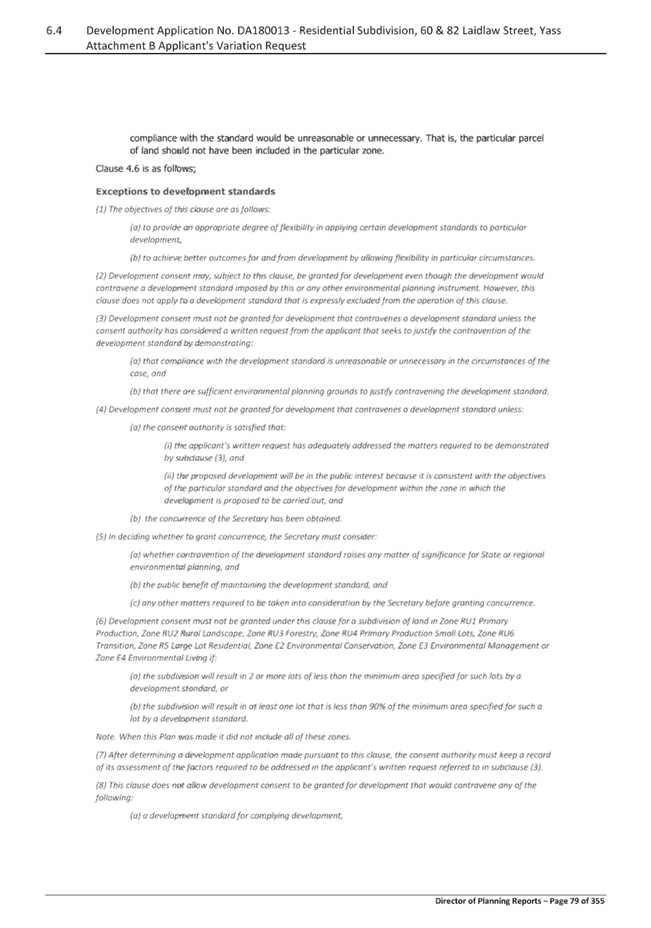

Attachment d Overall Master Plan
6.5 Development Application No. DA180013 - Residential Subdivision 60 & 82 Laidlaw Street, Yass
Attachment e Development Guidelines
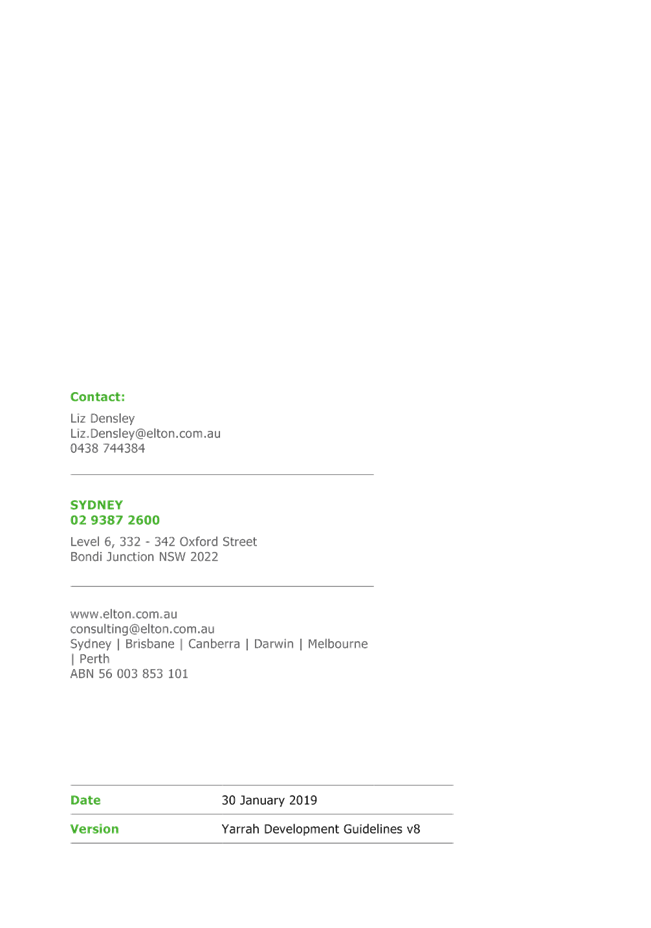
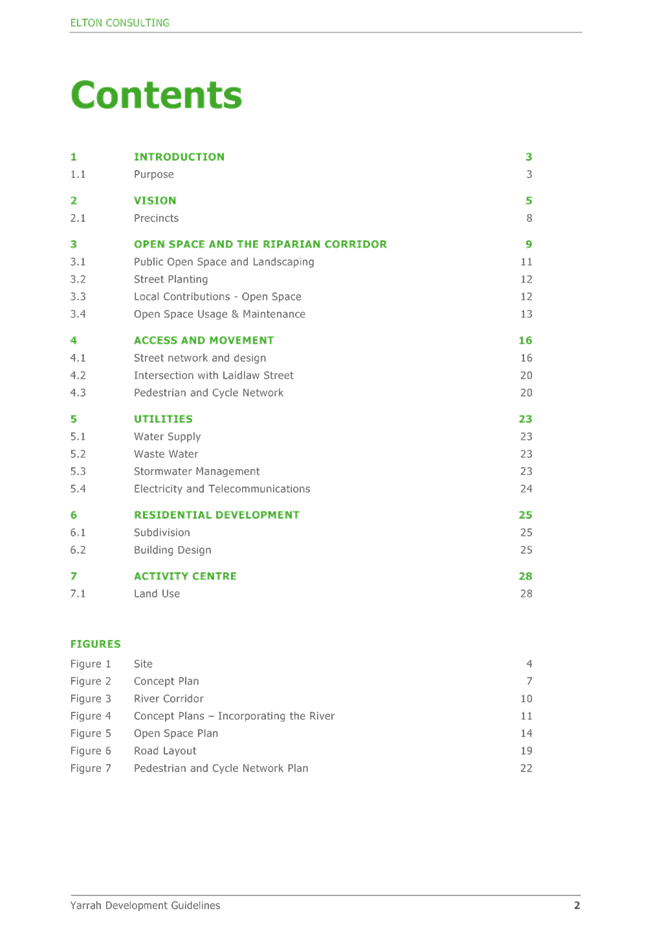
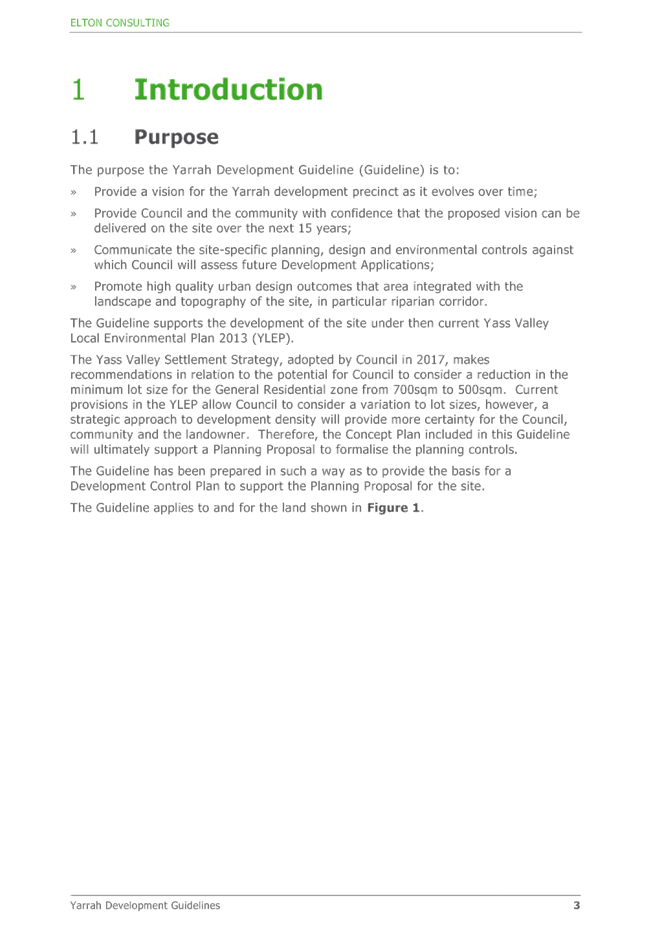
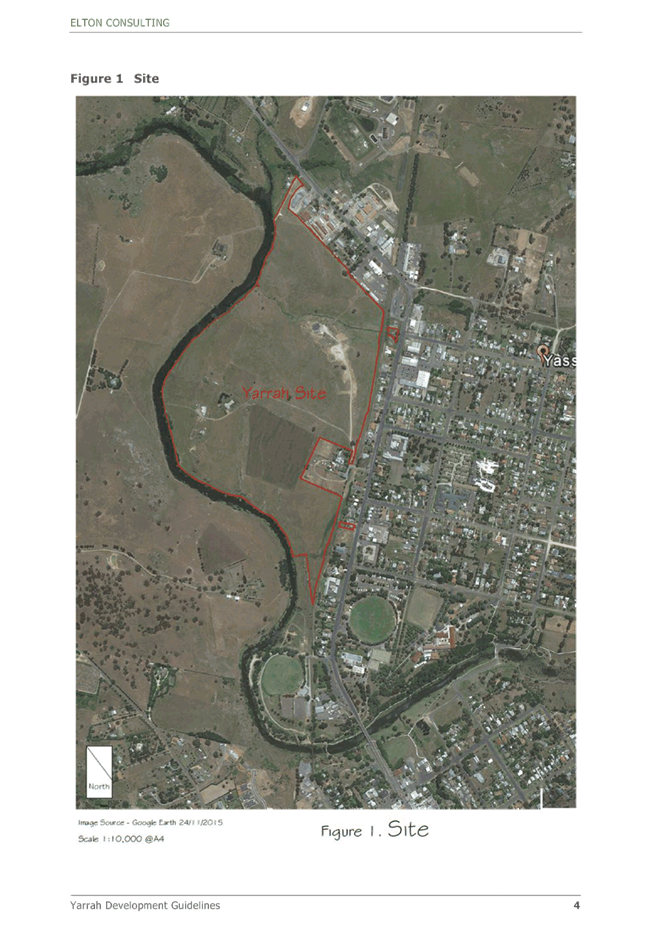
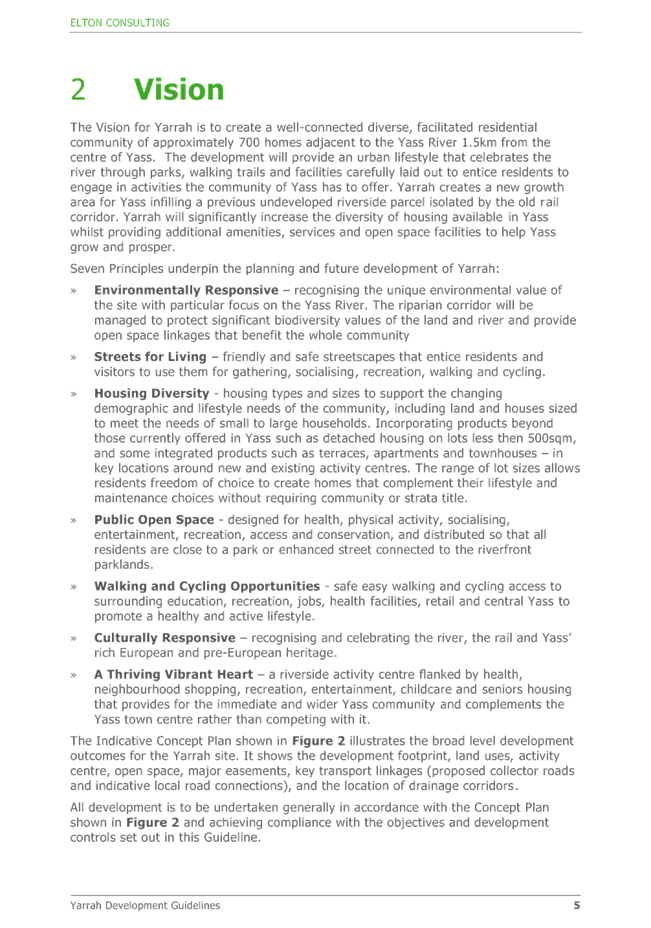

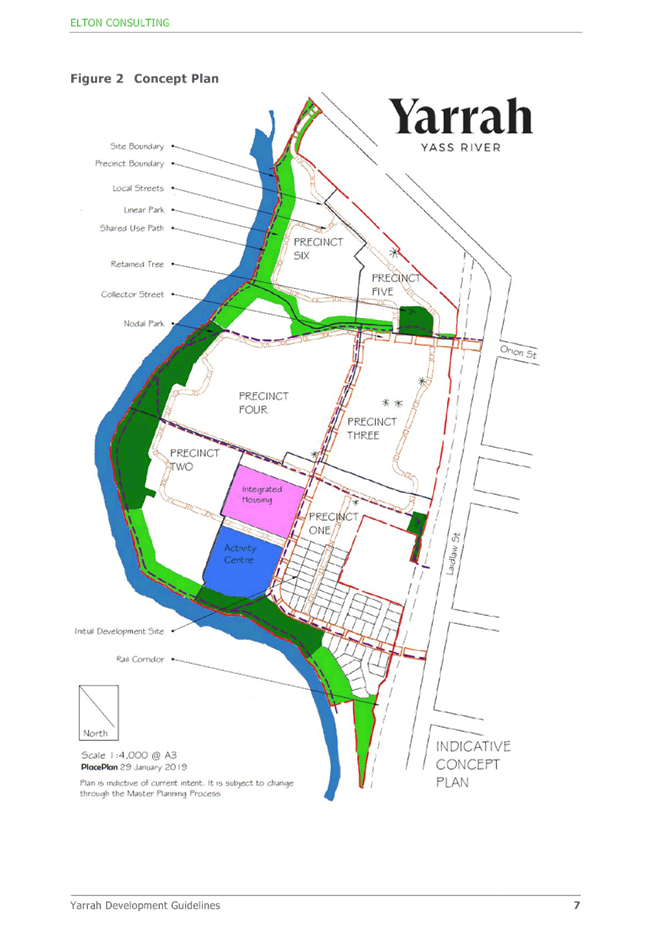
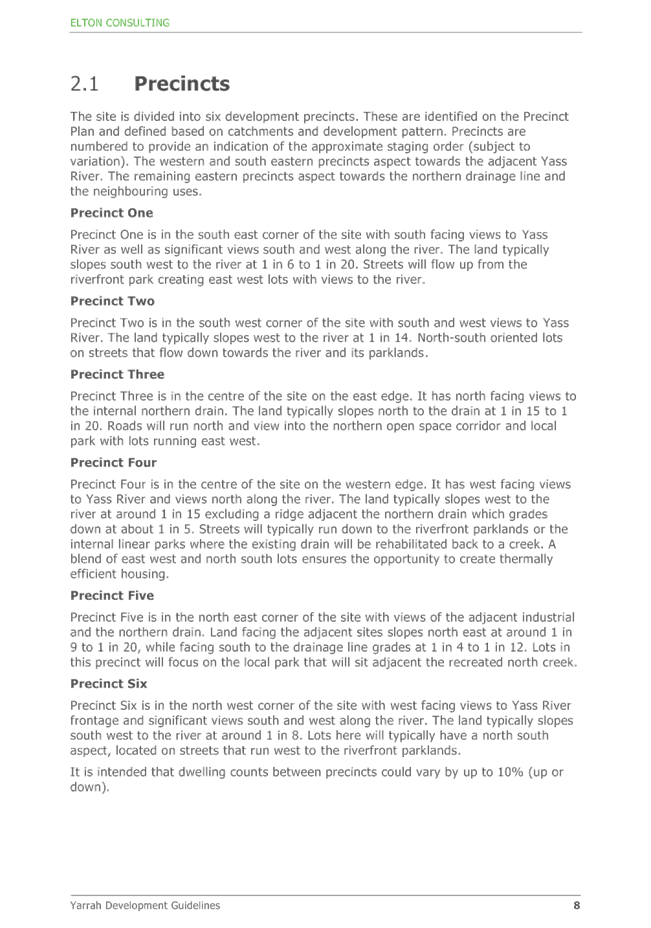
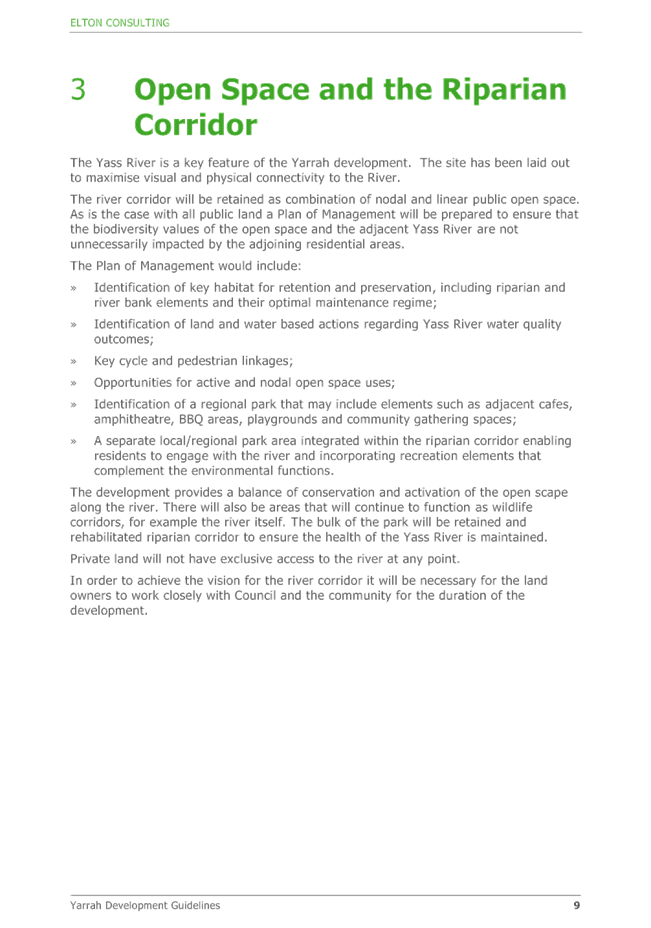
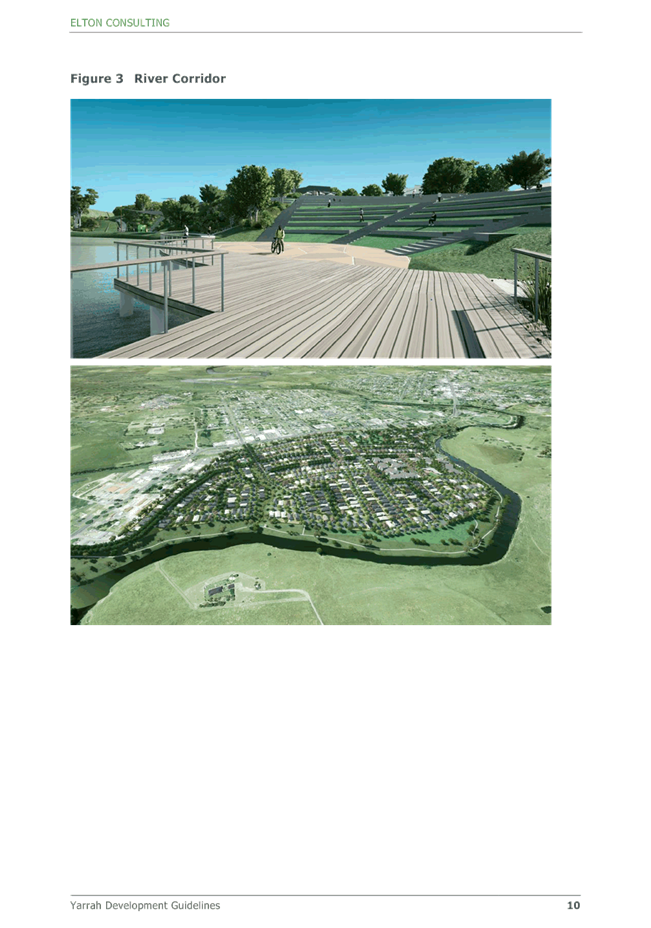
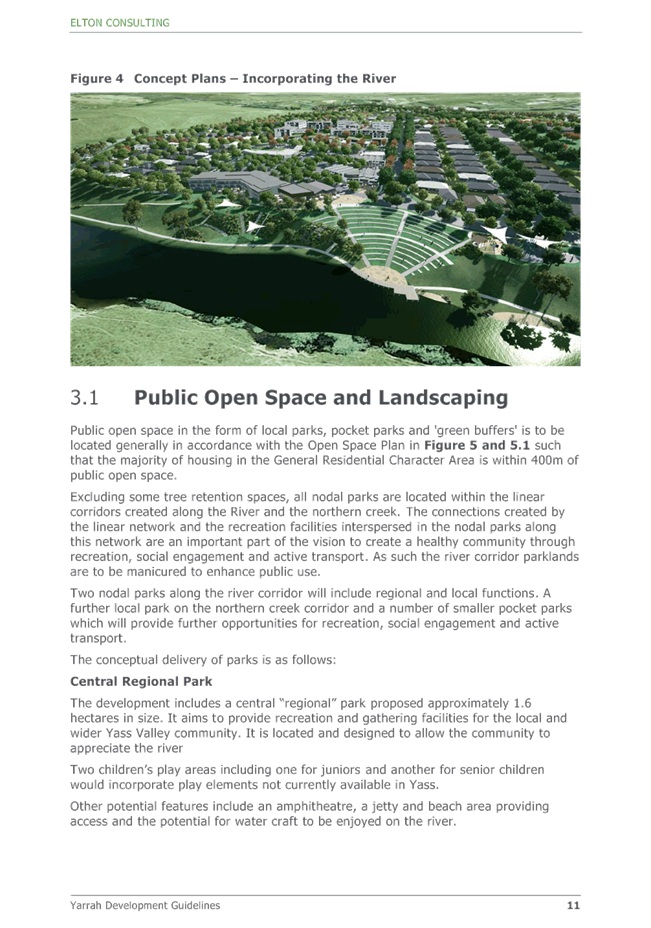
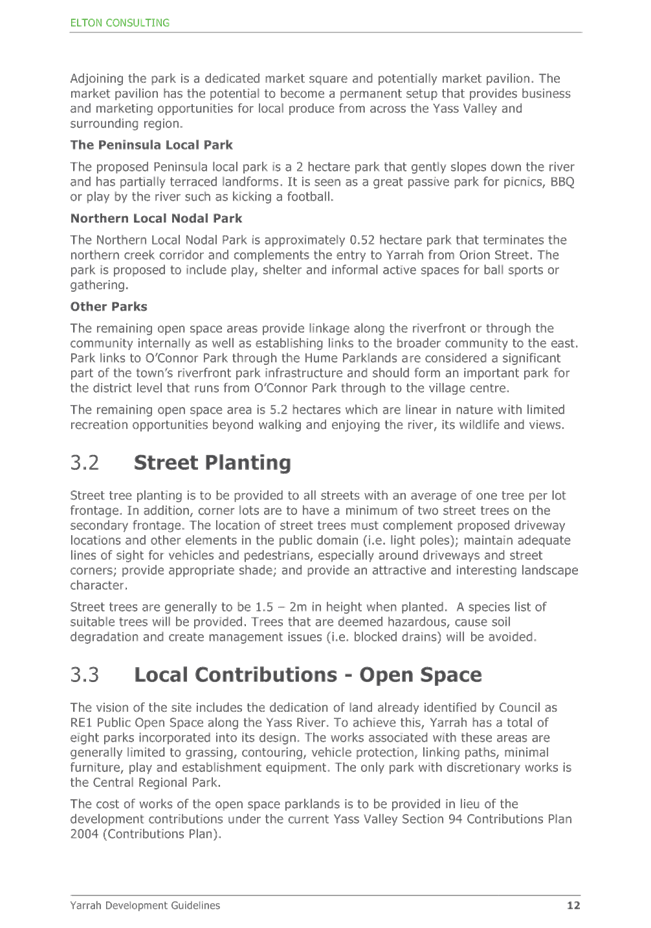
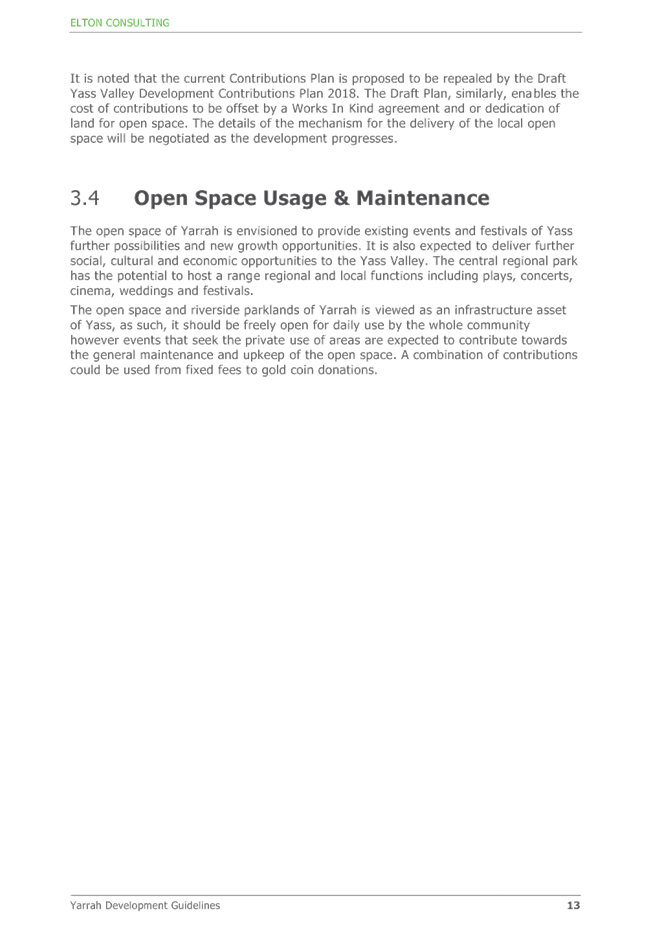
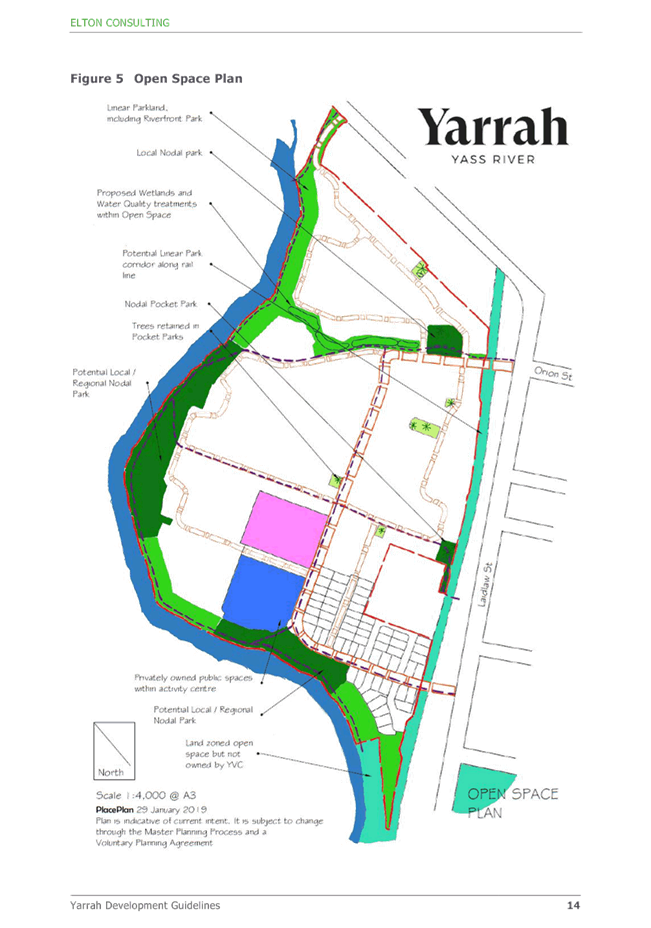
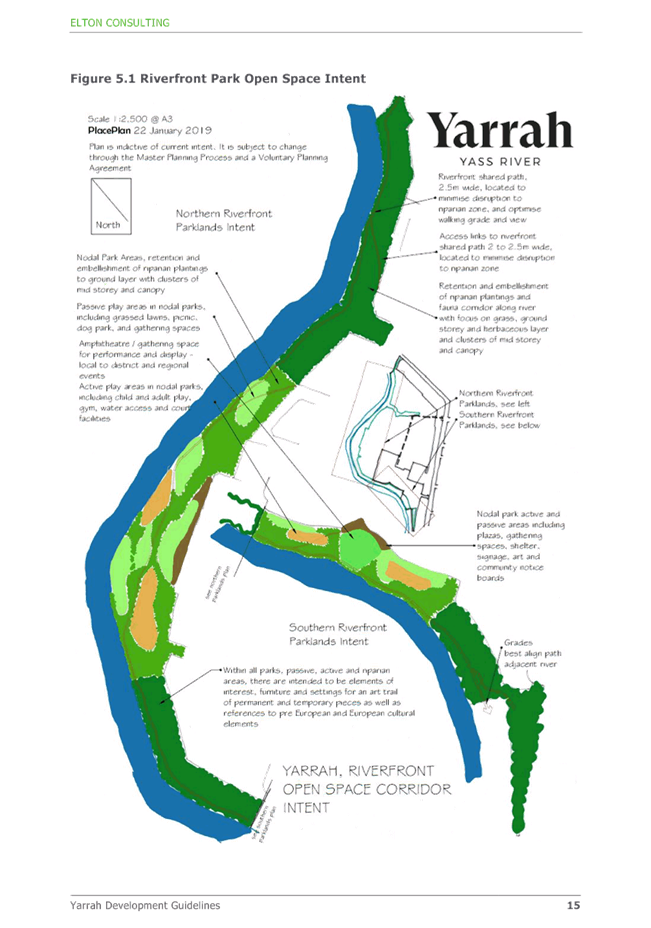
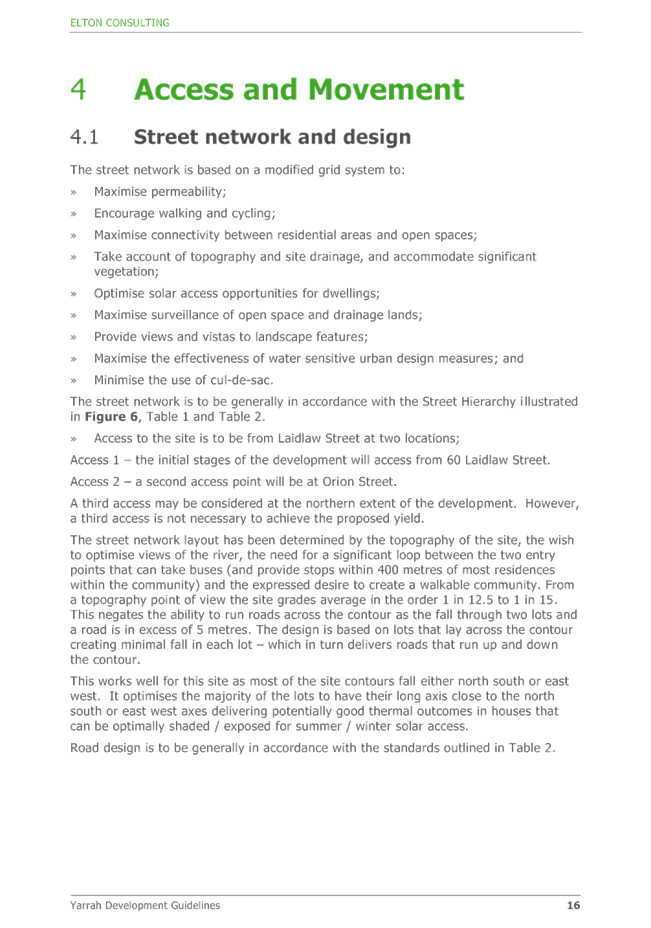
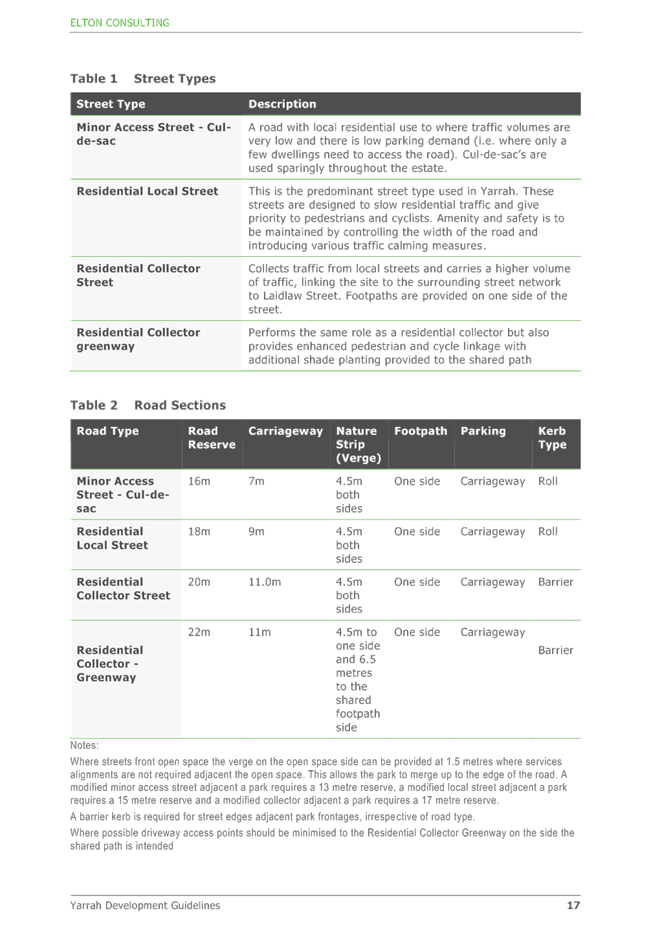
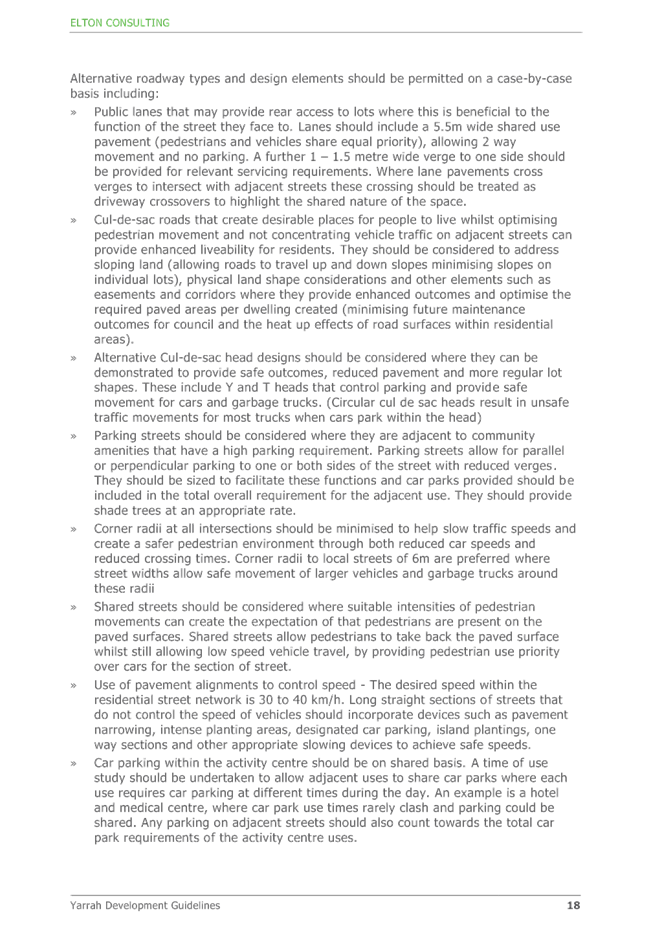
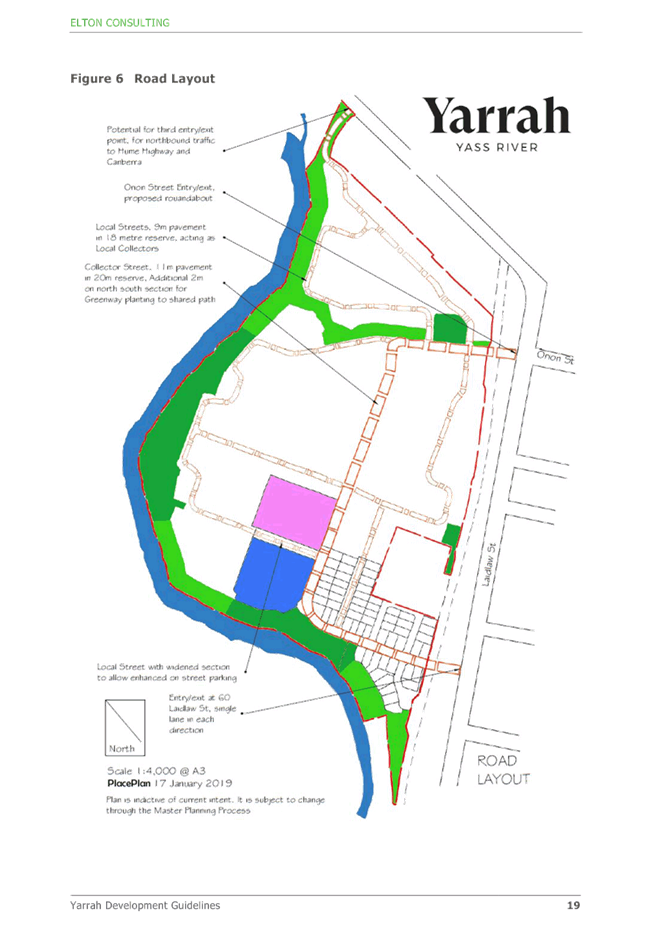
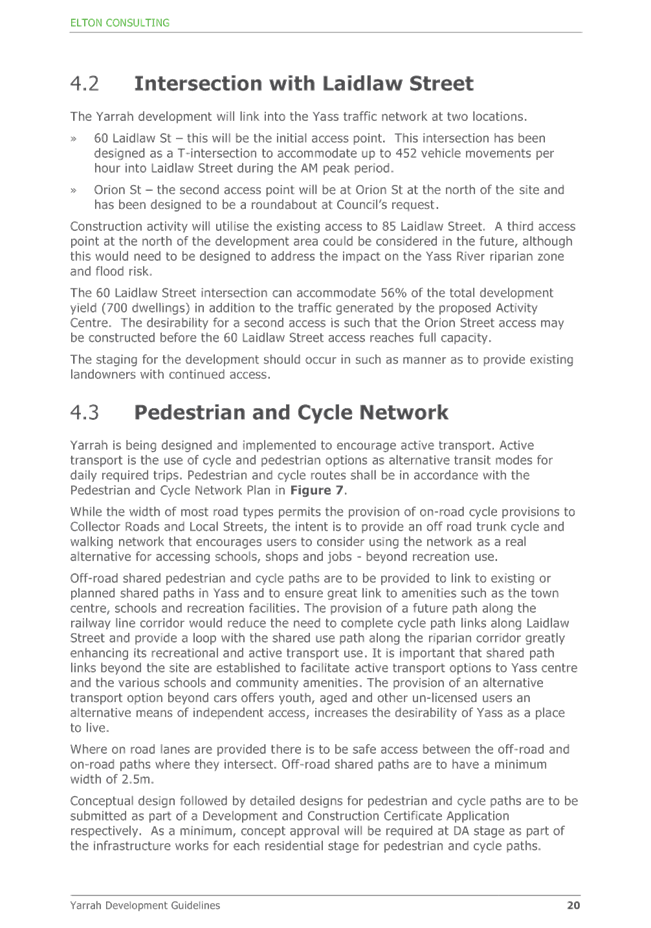

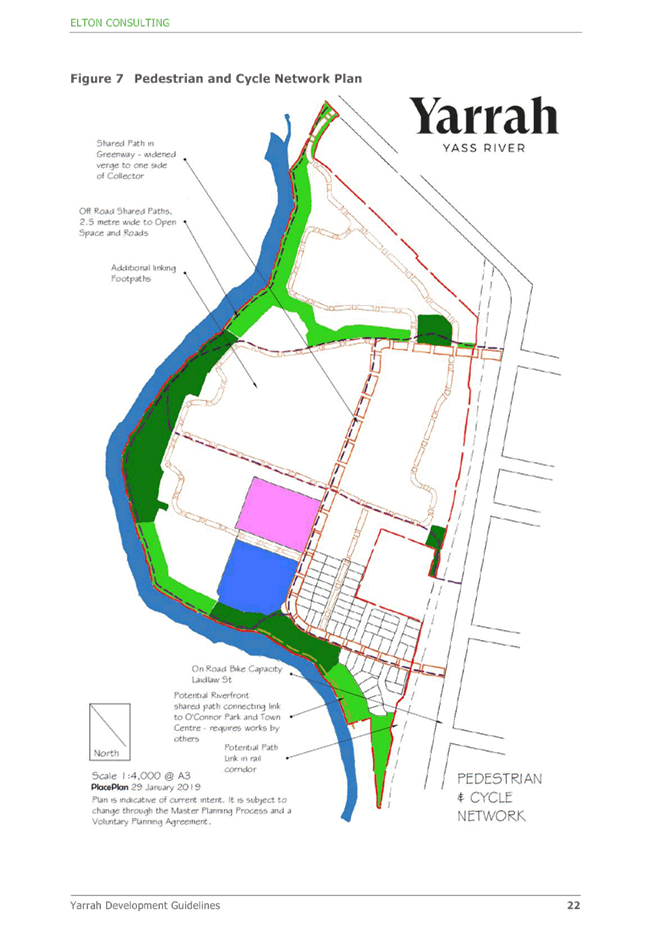
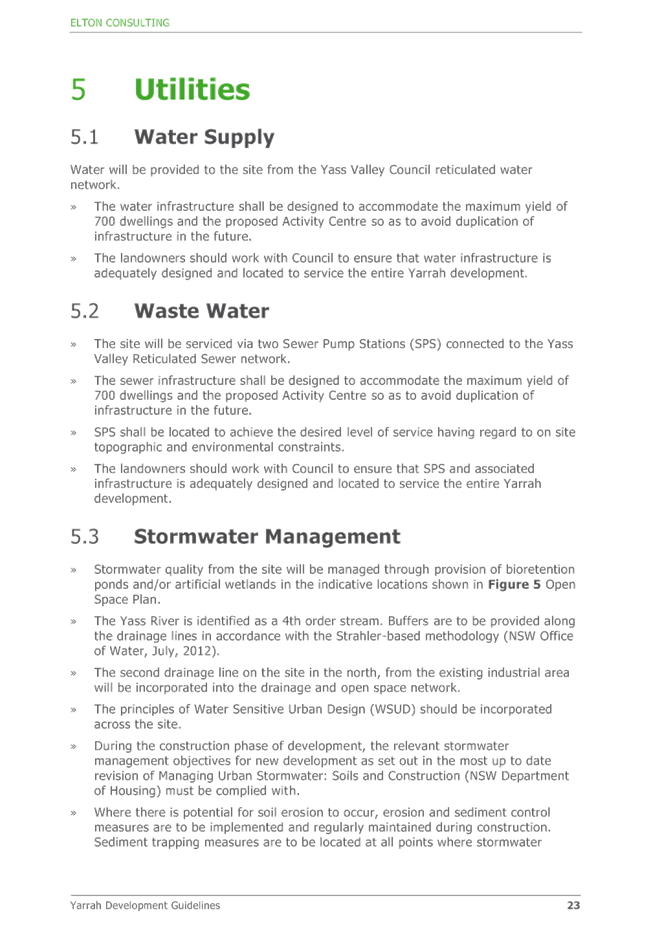

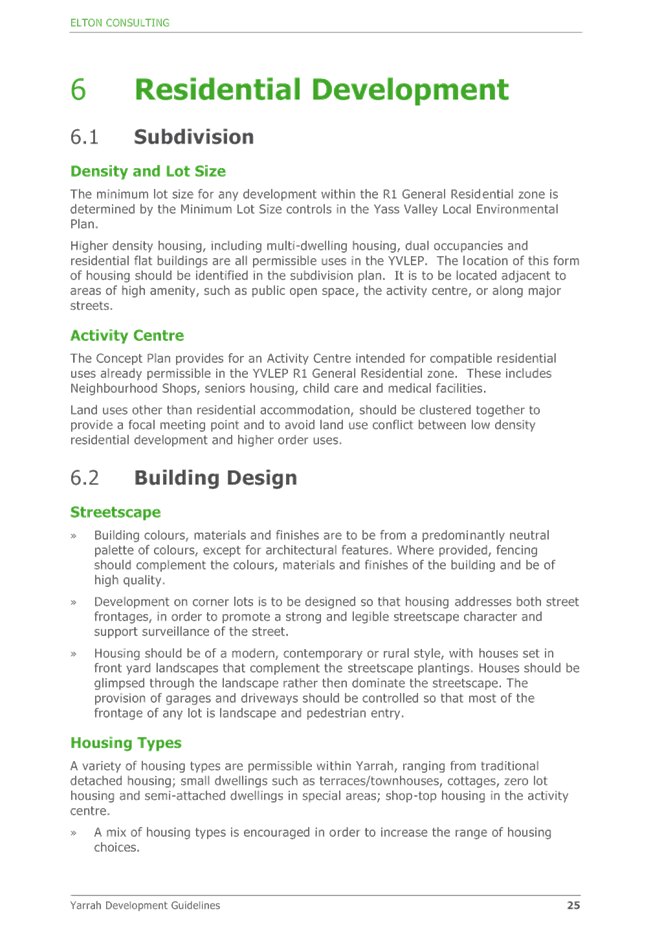
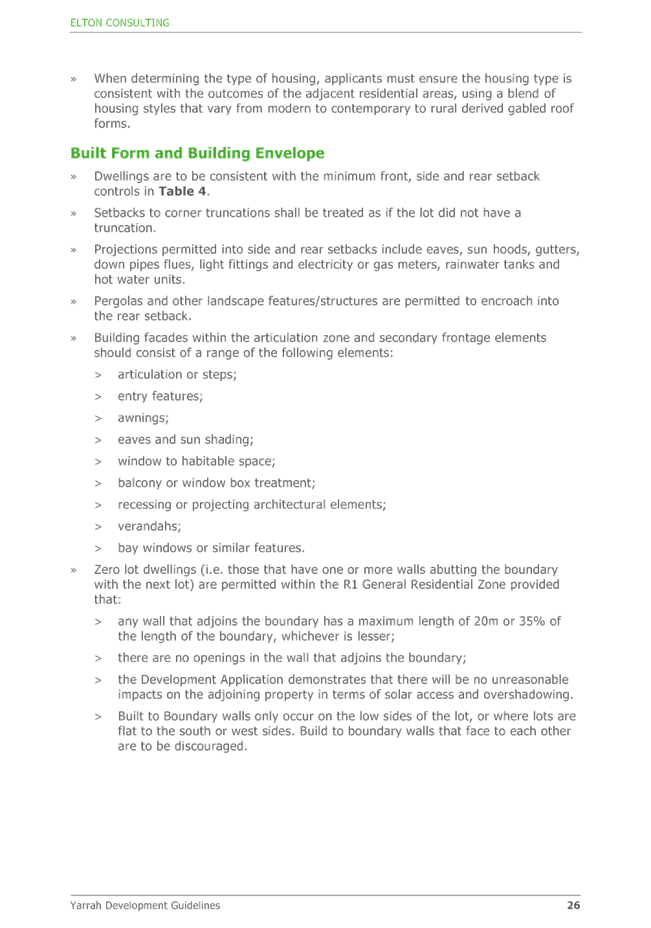
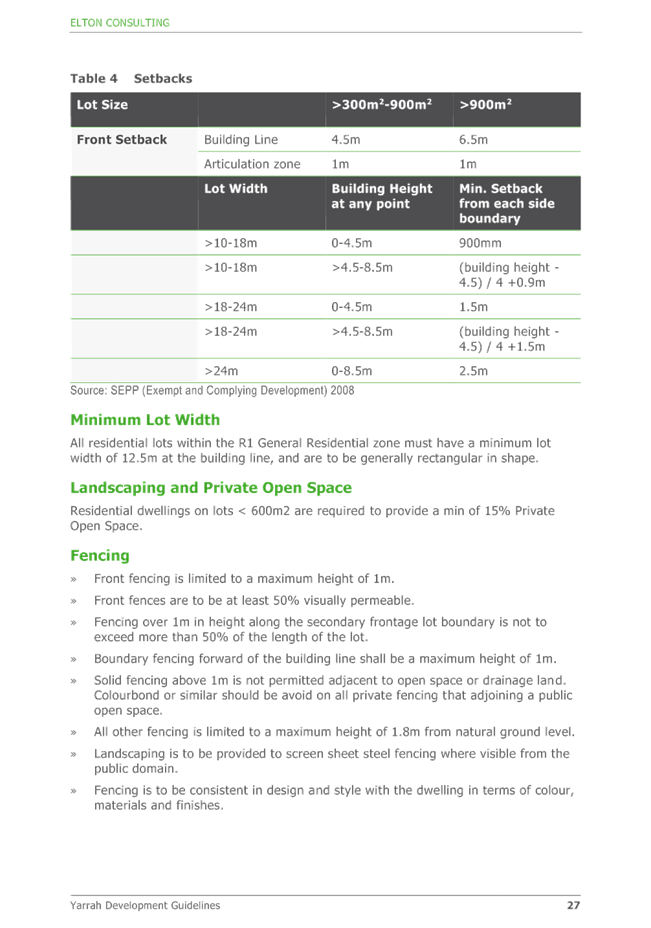
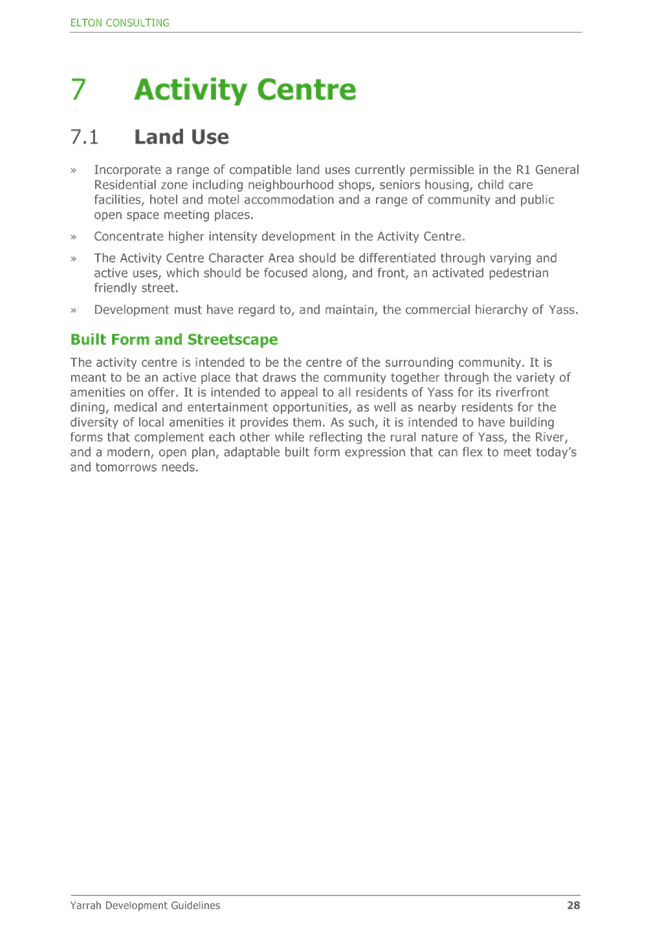
Attachment f Draft Conditions
PART A - GENERAL CONDITIONS
(1) Consent is granted generally in accordance with the plans and details submitted to Council with the Development Application. The plans of subdivision has been stamped and attached to this consent. The development shall be carried out in accordance with the stamped plan or as modified by these conditions.
(2) This approval relates only to the development referred to in the development application and specifically does not amount to an approval or acceptance by the Council of any works or buildings already erected on the land, whether or not those works or buildings are the subject of a prior development or building approval.
(3) An Engineering Construction Certificate, as defined by the Environmental Planning and Assessment Act 1979, shall be obtained for all engineering works prior to any works commencing on site. Council’s fee for providing a Construction Certificate is levied in accordance with Council’s Management Plan relevant at the time of payment.
This will require the Development Application Form (Form 1) to be filled out and submitted to Council to facilitate the issuing of the Construction Certificate.
(4) All engineering design and construction work shall be undertaken in accordance with the following, current at the time of the Engineering Construction Certificate being issued:
· Council's Road Standards Policy RD-POL-09
· Council’s Design and Construction Specification – AUS-SPEC #1
· Australian Standards and
· AustRoads
· Water Supply Code of Australia
· Sewerage Code of Australia
(5) The developer at no cost to Council shall make any necessary alteration, relocation or enlargement to public utilities whether caused directly or indirectly by this proposed subdivision.
(6) Public access to the site and construction works, materials and equipment on the site is to be restricted, when construction work is not in progress or the site is unoccupied.
(7) The capacity and effectiveness of runoff and erosion control measures shall be maintained at all times to the satisfaction of Council as shall any techniques to suppress dust and the tracking of sediment onto existing sealed roads;
(8) Consent is granted in accordance with John Holland Rail Pty Ltd (JHR) General Terms of Approval as detailed in JHR’s letter dated 7 January 2019 and 18 July 2017 (in principle approval) attached to this consent;
(9) The attached General Terms of Approval from JHR do not constitute an approval for the design of level crossing, storm water management/culvert or any other works within the rail corridor. The applicant must obtain approval from JHR for any works within or adjoining to rail corridor.
(10) The applicant must apply to NSW Natural Resources Access Regulator’s (NRAR) for a Controlled Activity Permit for any works within river corridor prior to commencing any works or activity within river corridor.
(11) Should any Aboriginal sites, objects or suspected human remains be unearthed during works associated with the subdivision, all work must cease and the NSW Office of Environment & Heritage (OEH) is to be contacted immediately. No works is to recommence at the location unless authorised by OEH in writing.
(12) Should any potential archaeological relics are discovered during works associated with the subdivision, all work must cease and the NSW Office of Environment & Heritage (OEH) is to be contacted immediately. No works is to recommence at the location unless authorised by OEH in writing.
(13) All Aboriginal objects and places are protected in NSW under National Parks & Wildlife Act 1974. It is an offence to harm an Aboriginal object or place without an approval issued by the Office of Environment & Heritage (OEH).
(14) If impacts to Aboriginal heritage sites or objects are found to be a possibility from the proposed development then consultation should be undertaken to discuss management and mitigation options in accordance with the “Aboriginal Cultural Heritage Consultation Requirements for Proponents”.
(15) The newly identified Aboriginal sites must be registered on Aboriginal Heritage Information Management System (AHIMS) register.
(16) The potential location of the archaeological resource/Watson’s Mill shall be determined prior to works commencing on site so that it is not inadvertently damaged by machinery, infrastructure or any other unanticipated action. This will enable the site be incorporated in landscaping plan of the river corridor,
(17) Kiln relics shall not be impacted by the proposed subdivision works.
(18) The applicant must adhere to the following days and hours of operation for the construction of the development unless otherwise approved by Council in writing:
· 7.00 am to 6.00 pm Monday to Friday
· 8.00 am to 1.00 pm Saturday
· No work on Sundays or Public Holidays
(19) Noise, dust and odour generated as a result of the development must comply with the provisions of the Protection of the Environment Operations Act 1997.
(20) Development within the subdivision shall be generally consistent with the ‘Yarrah Development Guidelines’ prepared by Elton Consulting Dated 30 January 2019.
PART B - PRIOR TO ISSUE OF ENGINEERING CONSTRUCTION CERTIFICATE
(1) Prior to issue of construction certificate, detailed drawings for the level crossing, storm water infrastructure within rail corridor, any other works within or adjacent to rail corridor and any other documentation prescribed in the General Terms of Approval (attached as Schedule 1 to this Consent) from John Holland Rail Pty Ltd (JHR) shall be submitted to (JHR) for their approval.
(2) The applicant shall submit to JHR a Risk Assessment /Management Plan and detailed Safe Work Method Statements for its review and approval prior to issue of a Construction Certificate.
(3) The applicant shall prepare and provide to JHR with a comprehensive geotechnical assessment confirming that the proposed development, during construction or occupation will have no adverse impact on the safety or stability of the rail corridor land.
(4) Written correspondence from the JHR shall be submitted to Council, stating that the design of level crossing, storm water infrastructure within rail corridor and any other works within or adjacent to rail corridor are to their satisfaction;
(5) Prior to issue of construction certificate, a Biodiversity Management Plan must be prepared to and approved by Council. The Biodiversity Management Plan may form part of a Construction Environmental Management Plan.
(6) The Biodiversity Management Plan must identify:
· the development site as per the Biodiversity Development Assessment Report and approved plans.
· areas of land that are to be retained as outlined in the Biodiversity Development Assessment Report.
· Construction impacts must be restricted to the development site and must not encroach into areas of retained native vegetation and habitat. All materials stockpiles, vehicle parking, machinery storage and other temporary facilities must be located within the areas for which biodiversity impacts were assessed in the Biodiversity Development Assessment Report.
· All measures proposed in the Biodiversity Development Assessment Report to mitigate and manage impacts on biodiversity, including performance measures for each commitment.
(7) Prior to issue of construction certificate the class and number of ecosystem credits in Table 1 must be retired to offset the residual biodiversity impacts of the development.
The requirement to retire credits may be satisfied by payment to the Biodiversity Conservation Fund of an amount equivalent to the class and number of ecosystem credits, as calculated by the Biodiversity Offsets Payment Calculator.
Evidence of the retirement of credits or payment to the Biodiversity Conservation Fund in satisfaction of this condition must be provided to Yass Valley Council prior to issue of construction certification.
Table 1 Ecosystem Credits Required to be Retired – like for like
|
Impacted plant community type |
Number of ecosystem credits |
IBRA sub-region |
Plant community type(s) that can be used to offset the impacts from development |
|
PCT 1289 – Wallaby Grass – Red-grass – Tall Speargrass – Kangaroo Grass dry tussock grassland of the North-western and Eastern Southern Tablelands in the South Eastern Highlands Bioregion |
14 |
Murrumbateman, Bondo, Crookwell, Inland Slopes, Monaro, Murrumbateman and Snowy Mountains. or any IBRA subregion that is within 100 km of the out edge of the impacted site |
Temperate Montane Grasslands (including PCT’s 586, 894, 895, 896, 1110, 1185, 1186, 1187, 1202, 1288, 1289, 1298) |
Note: The prices of credits in the Biodiversity Offsets Payment Calculator are subject to change. The amount payable to discharge an offset obligation will be determined at the time of payment.
(8) Prior to issue of construction certificate the class and number of ecosystem credits in Table 2 must be retired to offset the residual biodiversity impacts of the development.
The requirement to retire credits may be satisfied by payment to the Biodiversity Conservation Fund of an amount equivalent to the class and number of species credits, as calculated by the Biodiversity Offsets Payment Calculator.
Evidence of the retirement of credits or payment to the Biodiversity Conservation Fund in satisfaction of this condition must be provided to Yass Valley Council prior to issue of construction certification.
Table 2 Species Credits Required to be Retired – like for like
|
Impacted Species Credit Species |
Number of Species credits |
IBRA sub-region |
|
Delma impar/Striped Legless Lizard |
14 |
Anywhere in NSW |
|
Synemon plana/Golden Sun Moth |
28 |
Anywhere in NSW |
Note: The prices of credits in the Biodiversity Offsets Payment Calculator are subject to change. The amount payable to discharge an offset obligation will be determined at the time of payment.
(9) The developer shall provide evidence to Council in the form of a credit retirement report issued by NSW Office of Environment & Heritage (OEH) confirming credit transactions.
(10) The developer shall provide evidence to Council in the form of statement in accordance with s6.33 of Biodiversity Conservation Act 2016 confirming payment to Biodiversity Conservation Fund issued by Biodiversity Conservation Trust.
(11) Prior to issue of Construction Certificate, the developer shall prepare and submit to Council a Construction Environment Management Plan (CEMP) with an unexpected find protocol which includes both surface and ground water monitoring. The CEMP is to be implemented onsite prior to any development works be undertaken on site.
(12) Prior to issue of Construction Certificate, the developer shall engage a suitably qualified environmental consultant to prepare a Remediation Action Plan (RAP) detailing how the Areas of Environmental Concern (AECs) within the development footprint identified in Preliminary Site Assessment and Soil & Water Assessment by Robson Environmental Pty Ltd will be remediated and methodology for ensuring that the site can be validated following remediation.
(13) Submit to Council a statement from an accredited site auditor engaged by the developer in accordance with the “Contaminated Sites: Guidelines for the NSW Site Auditor Scheme (3rd Edition) that provides evidence that:
· An appropriate process has been undertaken in preparing the RAP, and
· If the RAP is implemented in accordance with consultant’s recommendations it is likely the site will be remediated to the extent that the ultimate use of the land will be suitable.
Nothing in this consent prevents remediation works being carried out prior to issue of the Construction Certificate subject to those works being carried out in accordance with approved Remediation Action Plan.
(14) Prior to issue of Construction Certificate, a site audit report shall be prepared by an accredited site auditor and be submitted to Council. The site audit report must indicate that the site has been remediated and validated to allow it to be used for its ultimate use.
(15) A Controlled Activity Permit from NSW Natural Resources Access Regulator (NRAR) that permits the carrying out work within 40m of a water course is to be submitted to Council.
Note: The plans for water course crossing shall be prepared in accordance with the NSW Natural Resources Access Regulator (NRAR) guidelines.
Note: The applicant shall apply to NSW Natural Resources Access Regulator (NRAR) for Controlled Activity Permit.
(16) Engineering drawings for the provision of access to each lot shall be submitted to Council’s Engineering Department for approval in accordance with:
· Council’s Road Standards Policy RD-POL-09 and
· Council’s Design and Construction Specification – Ausspec#1.
(17) Engineering drawings for the provision of footpaths shall be submitted to Council’s Engineering Department for approval.
(18) Engineering drawings for the provision of kerb & gutter shall be submitted to Council’s Engineering Department for approval.
(19) Engineering drawings associated with the construction of all roads shall be submitted to Council’s Engineering Department for approval in accordance with Council’s Roads Standards Policy RD-POL-09 and Council’s Design and Construction Specification – Ausspec#1
Note: All cul-de-sacs shall have a 12m turning radius and provided with an asphaltic concrete wearing surface. Minimum standard 40mm thick AC14. In accordance with Council’s Road Standards Policy RD-POL-9. The road reserve will need to be increased at cul-de-sac ends to cater for the turning radius and road verge
Note: Details of any temporary turnaround points shall be submitted for Council’s approval
Note: Details of all lines and signs shall be supplied
Note: The required works are to be undertaken at no cost to Council.
Note: No entry features or signs are to be placed within Council’s road reserve
Note: Details of the level crossing of the tram way shall be supplied
Note: Legal and Physical access to 78 & 80 Laidlaw Street shall be maintained at all times.
Note: Council is committed to the sustainable management of the environment which includes minimising the impact of road upgrades. Clause 9.5 of Council’s Road Standards Policy RD-POL-9 should be considered in the preparation of engineering designs. In this regard, Council may require a Review of Environmental Factors (REF) to accompany the engineering drawings for consideration and approval prior to the issue of an Engineering Construction Certificate.
(20) Engineering drawings associated with the construction of the intersection of the new road and Laidlaw Street all shall be submitted to Council’s Engineering Department for approval in accordance with Council’s Roads Standards Policy RD-POL-09 and Council’s Design and Construction Specification – Ausspec#1 and generally in accordance with the additional traffic information and reports provided in email dated 30/1/2019.
Note: Truck turning templates are to be provided
Note: Details of any impact for truck access to other properties at this intersection are to be submitted
Note: details of proposed pavement upgrades at the intersection are to be provided
(21) Engineering drawings and calculation associated with the drainage of storm water shall be submitted to Council’s Engineering Department for approval in accordance with Council’s Storm water Policies and Design and Construction Specification – Ausspec#1
These documents will include details of the discharge of storm water off the site (including quantities for various storm event and is to include storm water that falls on the site or enters the site from upstream), what is proposed to manage the discharge (including details of any infrastructure etc.), the potential downstream effects of such discharges and actions proposed to ameliorate such effects and what is proposed to ameliorate any effects on the site from storm water from upstream of the site
Note: An overland flow path to accommodate the discharge from a 1 in 100 year storm event shall be provided and clearly shown on plans.
(22) Engineering drawings associated with the supply of water shall be submitted to Council’s Engineering Department for approval in accordance with the Water Supply Code of Australia.
Notes:
(i) Development shall not exceed 62 residential units (equivalent tenements) due to the limitations of the existing capacity of Council’s sewerage infrastructure.
(ii) Water supply shall be from the Council’s 250mm water main on the corner of Laidlaw Street and Grampian Street.
(iii) Water network analysis for the proposed subdivision shall be provided.
(iv) Water supply network analysis and plan for the remaining land shall also be provided.
(v) Water reticulation mains shall be designed and laid in accordance with the Water Supply Code of Australia.
(vi) All reticulation mains shall be of MPVC, PN 12, S2 except at road crossings. Road crossings shall be DICL pipe class PN 35. Minimum diameter shall be 100 mm.
(vii) All water mains in cul de sac locations shall be looped, unless otherwise instructed by Council.
(viii) All valves shall be anti-clockwise closing and shall conform to Council standards.
(ix) All water mains shall be tested in accordance with Yass Valley Council requirements.
(x) All property services shall be with copper pipes as per plumbing standards. Long services shall be with 25 mm and short services shall be with 20 mm.
(xi) All meter cocks of each property service shall be installed at 200 mm – 300 mm below finished ground level and shall be covered with meter boxes. Meter boxes will be supplied by the Council.
(xii) Tapping saddle, main cock and meter cock shall meet Yass Valley Council requirements.
(xiii) Connections to existing water mains shall be carried out by Yass Valley Council at the Developer’s cost.
(23) Engineering drawings associated with the drainage of sewer shall be submitted to Council’s Engineering Department for approval in accordance with the Sewerage Code of Australia;
Notes:
(i) Development shall not exceed 62 residential units (equivalent tenements) due to the limitations of the existing capacity of Council’s sewerage infrastructure
(ii) Sewerage infrastructure shall be designed to discharge to existing sewer manhole MM0/16 at the corner of Castor Street and Laidlaw Street.
(iii) Sewer network analysis for the proposed subdivision shall be provided.
(iv) Sewer network analysis and plan for the remaining land shall also be provided.
(v) Number of sewage pump stations for the overall development shall be minimized and appropriate arrangements shall be provided to integrate with the ultimate sewerage layout.
(vi) Sewer reticulation shall be designed and laid to satisfy hydraulic requirements in accordance with Sewerage Code of Australia.
(vii) All sewer reticulation mains shall be with PVC, RRJ, Class SN8 with a minimum diameter of 150 mm (for industrial, minimum diameter is 225mm)
(viii) Trench stops / concrete bulkheads shall be installed for mains designed for grades 5% and above as per the Sewerage Code of Australia.
(ix) Sewer mains shall be air pressure tested as per approved methods and sewer manholes shall be vacuum tested as per approved methods.
(x) Sewer connections to existing sewer manholes or existing main shall be carried out by a licensed plumber in accordance with Council requirements.
(xi) Sewer ties shall be raised with a boundary riser and capped if the tie depth is more than two (2) metres.
(xii) Marker peg system or marker tape system shall be installed to each sewer tie as per the Sewerage Code of Australia.
(24) Sewage pump station shall meet the following requirements
(i) Duty and Standby pumps shall be installed to satisfy Peak Wet Weather Flow (PWWF) conditions.
(ii) Wet Well shall have eight hours of emergency storage at Average Dry Weather Flow (ADWF) above the normal operating levels.
(iii) Duty Selector Switch (P1, P1/2, Alt, Off, P2/1, P2) & (Auto / Manual / Off) Switch for each pump
(iv) Overload Reset Button for each pump
(v) Ammeter and Volt Meter for each pump
(vi) Thermal overload indicator for each pump
(vii) Hours run Meter for each pump
(viii) External fault indicator light
(ix) Emergency Generator connection point with Change Over Switch
(x) Extra high Level float switch in Wet Well and with direct connection to Council’s Rad-Tel telemetry system
(xi) Installation of RTU to suit Council’s Telemetry System
(xii) Outdoor type Switchgear and Control Gear Assembly (SCA) with minimum degree of protection of IP56D with a separate lockable cubicle for Power Supply Authority Meter.
(xiii) Enclosure for SCA shall be either SS316 grade stainless steel or marine grade aluminium.
(xiv) A 25mm water service with RPZD backflow prevention device.
(xv) Provision of FRP Ladder access to wet well
(xvi) Provide direct Power supply from Electricity Supply Authority
(xvii) Access for maintenance vehicles
(xviii) Top floor level of Pump station shall be 300mm above finished surrounding ground level.
(25) A Design Certification Report relating to the detailed engineering design work shall be submitted to Council as per Council’s Design Specification - AusSpec #1, Annexure DQS-A.
Note: This Design Report shall provide evidence that suitably qualified designers have designed each component of the engineering works for the development
(26) A detailed landscaping plan for the subdivision including river corridor prepared by a qualified horticulturalist shall be submitted to Council’s Engineering Department for Approval. Details of the proposed landscaping species and installation including cultivar, common and botanical names, height and spread at maturity shall be submitted along with this plan. Approved advanced street trees shall be planted in the road reserve at a rate of 1 every 20 metres and shall be adequately protected.
Installed street trees must be appropriately maintained (including watered) to ensure they survive and will be checked as part of any defect liability period. Any missing or dead tress must be replaced before issuing the final defect liability period compliance certificate
The plan is to provide landscaping around the river corridor so as to improve the riparian environment.
The plan shall specify details of proposed planting, including common and botanical names and height and spread at maturity.
The plan shall also include:
a) The location of lighting, seating, pathways and the type of material to be used for sealing these areas;
b) Details of earthworks including mounding and retaining walls;
c) Details of planting procedure and maintenance.
All landscaping is to be carried out and maintained in accordance with the approved plan at all times.
Note: The potential location of the archaeological resource/Watson’s Mill shall be determined to avoid any inadvertently damage by machinery, infrastructure or any other unanticipated action. Archaeological resource/Watson’s Mill be incorporated in landscaping plan of the river corridor.
Note: A supplementary Biodiversity Development Assessment Report (BDAR) shall be submitted to include the area of impacts along the river corridor.
Note: Depending upon supplementary BDAR, the number of ecosystem credits & species credit referred to in condition 7 & 8 will be changed.
(27) A list of three street names, for each new street shall be submitted to Council for consideration and approval in accordance with Council’s Naming of Roads Policy RD-POL-6.
PART C - PRIOR TO SUBDIVISION WORKS COMMENCING
(1) Subdivision work shall not be commenced until the person having the benefit of this Development Consent provides at least two (2) days’ notice to Council of their intention to commence subdivision work.
(2) A Soil and Water Management Plan shall be submitted to Council’s Engineering Department for approval in accordance with Council’s Design and Construction Specification – Ausspec#1. The plan shall include construction techniques to minimise site disturbance and the potential for soil erosion by wind or water, erosion control on any watercourse on the property, revegetation of disturbed areas and any other matters that are deemed necessary by Council.
Note: An indicative plan may be prepared to complement the design plans, however, the final plan for approval shall be prepared in consultation with the construction contractor.
(3) Appropriate soil erosion and sediment control measures shall be installed;
(4) Any contractor undertaking works in an existing road reserve shall also submit the following details:
· A current public liability certificate with a minimum cover of $20 million
· Current Plant / vehicle insurances
· A certified traffic control plan for the proposed works
(5) A sign shall be displayed in a prominent position on any site on which building work, subdivision work or demolition work is being carried out.
The sign must list the following details:
· The name, address and telephone number of the Principal Certifying Authority
· The name or the Principal Contractor and an after-hours telephone number and
· That unauthorised entry to the site is prohibited.
The sign must be maintained while the subdivision work is being carried out and removed upon completion.
PART D – DURING CONSTRUCTION
(1) The developer shall implement the approved Construction Environment Management Plan (CEMP) and keep it in place at all times during subdivision construction work.
(2) Should any contamination be identified during construction work, the developer shall prepare and submit to Council for approval a Remediation Action Plan (RAP) detailing how the contaminated areas/Areas of Environmental Concern (AECs) will be remediated and methodology for ensuring that the site can be validated following remediation.
(3) Should any contamination be identified during construction work, a statement from an accredited site auditor engaged by the developer in accordance with the “Contaminated Sites: Guidelines for the NSW Site Auditor Scheme (3rd Edition) shall be submitted to Council providing evidence that:
· An appropriate process has been undertaken in preparing the RAP, and
· If the RAP is implemented in accordance with consultant’s recommendations it is likely the site will be remediated to the extent that the ultimate use of the land will be suitable.
PART E – INSPECTIONS
(1) A compliance certificate shall be obtained from Council’s Engineering Department at the following stages of construction:
Roads
· Completion of property access. This inspection is for access dimensions and to ensure there are no ‘trip-fall’ hazards. Compliance with change in longitudinal grade will only be undertaken where it can be confirmed via WAE drawings
· Completion of sub-grade pavement layer – proof roll
· Completion of base course pavement layer– proof roll
· Completion of two coat bitumen seal
· Completion of kerb and guttering
· Completion of footpaths
Water
· Completion of water main and service connections - prior to backfilling
· Testing of water mains and service connections
Stormwater
· Completion of stormwater drainage line – prior to backfilling
· Completion of stormwater detention infrastructure (if included)
· Completion of stormwater quality improvement infrastructure (if included)
Sewer
· Completion of sewer main and lot sewer ties - prior to backfilling
· Installation of sewer drainage connections to Council’s main - prior to backfilling
· Testing of sewer mains and manholes
· Excavation of sewage pumping station – prior to installation of wet well
· Completion of sewage pumping station
· Commissioning of sewage pumping station
Other
· Completion of streetscaping and other public landscaping;
· Practical completion;
· Refund of bond(s).
(2) If Council is selected as the Principal Certifying Authority for engineering works, the fee per inspection shall be levied in accordance with Council’s Fees and Charges, relevant at the time of payment.
PART F – DEMOLITION
(1) All demolition work is to be carried out in accordance with the provisions of Australian Standard AS 2601-1991: The Demolition of Structures;
(2) All utility services are to be disconnected to the requirements of the relevant authorities;
(3) Asbestos waste, if present in the building proposed to be demolished, is to be removed, handled, transported and disposed of in accordance with NSW WorkCover requirements and the provisions of both the Protection of the Environment Operations Act 1997 and the Protection of the Environment Operations (Waste) Regulation 2014;
Note: There is no waste facility licensed to receive asbestos within the Yass Valley Local Government Area. The nearest suitably licensed waste management facilities are located in Jugiong and Canberra.
(4) All waste is to be disposed of at a suitably licenced waste management facility. Copies of receipts relating to the disposal of waste must be submitted to the Yass Valley Council upon request.
(5) The deliberate burning of demolition materials shall not be permitted.
(6) All demolition work must be carried out totally within the allotment boundaries and must not extend onto public footpath, public roadway or adjoining properties.
(7) Vehicles transporting demolition material off site shall have loads secured against any loss during transit.
PART G- PRIOR TO ISSUE OF SUBDIVISION CERTIFICATE
(1) A site audit report shall be prepared by an accredit site auditor and be submitted to Council. The site audit report must indicate that the site has been remediated and validated to allow it to be used for its ultimate use.
(2) In accordance with section 7.12 Environmental Planning and Assessment Act 1979 and the Yass Valley Development Contributions Plan 2018, a monetary contribution must be paid to Council.
The contribution rate is determined in accordance with the table below:
|
Cost of Carrying Out the Development |
Contribution Rate |
|
Up to and including $100,000 |
Nil |
|
More than $100,000 and up to and including $200,000 |
0.5% of that cost |
|
More than $200,000 |
1% of that cost |
Note: A Quantity Surveyor’s report is required for works exceeding $1,000,000. Below this threshold, a cost summary report is acceptable
(3) A levy under the Building and Construction Industry Long Service Payments Act 1986, equivalent to 0.35% of the value of the works, shall be paid to Council, where the value of such works is greater than $25,000.00;
(4) A Certificate of Compliance shall be obtained, and relevant contribution fees paid, under section 305 of the Water Management Act 2000, in relation to augmentation of Council's water supply system.
The fee for the Certificate of Compliance under Section 305 of the Water Management Act 2000, with regard to water service augmentation, is $848,966.00 being the total for 62 lot increase in demand, calculated on a base rate of $13,693.00 per lot. It should be noted that:
· The base rate utilised above was the rate applicable at the time the application was determined;
· The amount payable will be calculated on the rate applicable at the time of payment, rather than at the time the application was determined;
· The base rate per connection may vary over time;
· Compliance under Section 305 does not include the physical installation of any infrastructure.
(5) A Certificate of Compliance shall be obtained, and relevant contribution fees paid, under section 305 of the Water Management Act 2000, in relation to augmentation of Council's Sewerage supply system.
The fee for the Certificate of Compliance under Section 305 of the Water Management Act 2000, with regard to sewerage service augmentation, is $393,266.00 being the total for 62 lot increase in demand, calculated on a base rate of $6,343.00 per lot. It should be noted that:
· The base rate utilised above was the rate applicable at the time the application was determined;
· The amount payable will be calculated on the rate applicable at the time of payment, rather than at the time the application was determined;
· The base rate per connection may vary over time;
· Compliance under Section 305 does not include the physical installation of any infrastructure.
(6) One complete set of “Work as Executed” (WAE) drawings, indicating all details of new engineering works constructed, shall be submitted to Council.
The WAE Drawings shall be supplied to Council in the following format:
- AutoCAD LT 2011 on MGA 94 Zone 55 coordinates; and
- AutoCAD R12/LT DXF for each layer; and
- PDF; and
- A1 Hard Copy; and
and shall include the following details in separate files:
· Water – Location, Depth, Size, Material, Easement;
· Sewer – Location, Depth, Size, Material, Easement, Invert Level, Grades, Pit Details and tie details;
· Stormwater - Location, Depth, Size, Material, Easement, Invert Level, Grades, Pit Details and tie details;
· Transport Infrastructure – roads plan, cross sections, long sections, pavement details, K&G details, Footpath and Cycleway Details, Bus Stop Details, Street Light Locations;
· Details of property accesses including a cross section from the centre of the road to at least 3 metres into the adjacent property. Cross section to show all change in grades
· Landscaping Details;
· Other Utilities – Gas, Telstra, Electricity, Fibre Optic Cable locations, Depths, Easements and heights in comparison to the roads centre line.
· Survey Mark Details – Marker Numbers and AHD.
Note: Tie details must include depth, distance into the property and distance from a specified property boundary
(7) A Constructed Asset Information shall be supplied for all assets dedicated to Council. The required information shall include:
(a) Roads
(i) Length, width, gravel depth;
(ii) Earthworks cost;
(iii) Pavement cost;
(iv) Seal cost;
(v) Guidepost numbers and cost;
(vi) Raised pavement markers numbers and cost;
(vii) Guardrail type, size in metres and cost;
(viii) Signposts cost;
(ix) Open drainage works length and cost;
(x) Kerb and gutter length and cost;
(xi) Footpath cycleway length, width and cost
(b) Stormwater Drainage
(i) Pipe type, length and cost;
(ii) Pit type, number and cost;
(iii) Headwalls, number and cost;
(iv) Rockwork area and cost;
(v) Storm water quality improvement features, type, number and component costs
Sewerage Infrastructure
(i) Pipe type, length and cost;
(ii) Pit type, number and cost;
(iii) Pump well type and cost;
(iv) Electrical and Control equipment type and cost;
(v) Monitoring equipment type and cost.
Water Supply Infrastructure
(i) Pipe type, length and cost;
(ii) Valve type, number and cost;
(iii) Hydrant type, number and cost;
(c) Other Assets
(i) Description, dimensions and cost.
(8) An overland flow path to accommodate the discharge from a 1 in 100 year storm event shall be provided, including the provision of an easement where this flow path traverses private property.
(9) Road construction and upgrades are to be undertaken in accordance with the approved designs/drawings with the Engineering Construction Certificate construction certificate.
(10) Stormwater (including any detention or water quality devices shall be constructed in accordance with designs/drawings approved with the Engineering Construction Certificat.
(11) Street lighting shall be designed and installed throughout the subdivision in accordance with Australian Standard AS1158.1;
(12) Approved advanced street trees shall be planted in the road reserve at a rate of 1 every 20 metres. The trees shall be adequately protected in accordance with the approved landscaping plans.
(13) The landscaping within river corridor shall be completed and maintained at all times in accordance with the approved landscaping plan.
(14) The property vehicular accesses (new or existing) from the road to the property boundary shall be constructed to the following minimum standard, as per the appropriate location of the development:
· Safe Distance Requirements in accordance with Section 7 of Council’s Roads Standards Policy RD-POL-09;
· Minimum of 3.0 metres wide
· Maximum trafficable width of 5.0 metres wide at the kerb;
· Minimum of 50 mm. thick gravel base;
· Refer Council’s Road Standards Policy for the finished surface material and associated specification;
· Cut and fill batters within the road verge shall be graded to a maximum of 1 in 8.
· Constructed at least 6m from the tangent point of the kerb at any intersection.
· The grade of the driveway from the kerb or edge of seal to the property boundary shall be +2.5% (ie. 2.5% sloping upwards from the kerb to the property boundary).
· The maximum allowable longitudinal change in grade of any driveway shall be 12%.
NB: Where the above requirements are not practical due to site constraints, alternative proposals may be considered by the Director of Engineering.
· New property accesses shall not be constructed over any water service or sewer tie. Where an access is constructed over Councils water, sewer, or stormwater mains a minimum of 450mm cover is required over the main. Clearance to other services shall be by approval of the relevant service authority.
· The surrounding soil shall be made flush with the new driveway and reseeded.
· Any damage to Council’s road, footpath or kerb and gutter caused by the construction is to be repaired;
· Saw cut existing kerb and gutter, construct a concrete vehicle crossing and make flush;
· Remove existing entry, reinstate kerb and revegetate disturbed area;
· Clean debris from driveway pipe and nearby drain to facilitate water flow.
· Driveway to be constructed no less than 6m from the tangent point of the curve of the road
· The maximum grade of the driveway across the footpath shall be 2.5% and the joins shall be made flush;
· If there is no kerb and gutter present then the following clauses may be applicable
· Reinforced concrete pipes and headwalls (grout pipe to headwall) are to be provided through the table drain (or modified drain to ensure at least 2 m from the road).
Pipe are to be installed in accordance with the AS 3725 or meet the following for light loads:
|
Pipe Cover |
300 mm+ |
200 mm+ |
100 mm+ |
|
Pipe Class |
2 |
3 |
4 |
Pipe size shall be designed using the methods outlined in Australian Rainfall and Runoff (AR & R) or determined as follows:
|
Catchment Size |
Less than 0.5 Ha |
Less than 1 Ha |
Less than 2 Ha |
Less than 3 Ha |
3+Ha |
|
Pipe Size |
300 mm |
375 mm |
450 mm |
600 mm |
AR & R 1 in 5 year storm event. |
OR
Alternately, in instances where topography prohibits the use of pipe, a reinforced concrete dish drain (minimum 150 mm thick) 900 mm wide by 5 metres length may be constructed existing table drain (or an appropriate modification to an existing table drain that ensures at least a 2 m offset from the road).
Note: All disturbed surfaces adjacent to the works, either natural or manmade, will be required to be rehabilitated to a suitable state at the end of the works.
Note: The driveway works cannot be signed off as completed until such time as the surrounding soil has been made flush with the new driveway and reseeded.
(15) A bank guarantee, or cash bond, equivalent to 5% of the value of the whole of the engineering works shall be lodge with Council as a performance bond.
Note: This bond must be unconditional with no time limit and must be in the name of the developer (ie bonds in the name of the construction contractor will not be accepted)
Note: This bond shall be held for a period of the defects liability period (at least 12 months), which will commence from the later of linen plan release from Council or the practical completion of the engineering works (as evidence by the associated engineering compliance certificate).
Note: at the end of the defects liability period a final compliance inspection will be undertaken. Areas inspected may include the following:
· Roadside drainage
· Piped drainage
· Water quality or retention systems/devices
· Sealed road surface condition including excessive loose gravel
· Road signs and lines
· Sub-grade failures (eg soft spot)
· Roadside landscaping
Note: during the defect liability period the applicant will be responsible for all maintenance activities except for the following, which will be undertaken by Council:
· maintenance grading of unsealed roads public roads
· Council sewer blockages
(16) Footpaths in accordance with the approved construction certificate shall be constructed
(17) Kerb and gutter shall be constructed in accordance with the approved construction certificate
Note: Kerb & Gutter standards are to be in accordance with Council’s Roads Policy (RD-POL-09).
(18) Street name signs shall be installed at the entrance to each new road. The street sign shall be in accordance with Council’s standard urban street sign design
(19) An over land flow path to accommodate the discharge from a 1 in 100 year storm event shall be provided;
(20) Concrete vehicle crossings shall be constructed ensuring each allotment within the subdivision has its own vehicle access
(21) Water reticulation mains shall be laid in accordance with Water Supply Code of Australia and tested in accordance with Yass Valley Council requirements.
(22) Sewerage reticulation shall be laid in accordance with Sewerage Code of Australia and tested in accordance with Yass Valley Council requirements.
(23) Sewer connections to existing sewer manholes or existing mains shall be carried out by a licensed plumber in accordance with Council requirements.
(24) Sewer ties shall be raised with a boundary riser and capped if the tie depth is more than two (2) metres. A marker peg or marker tape system shall be installed to each sewer tie as per the Sewerage Code of Australia.
(25) The applicant shall reinstate the railway infrastructure and the relevant section of the rail corridor to the condition it was prior to when the crossing was constructed over the railway line at its costs and in accordance with JHR’s standards and requirements
(26) A restriction to user under Section 88B of the Conveyancing Act shall be placed on proposed Lots 1000, 1001, 1002 & 1003 that states the allotments shall not be developed until new sewerage infrastructure such as gravity sewers, pump stations, rising mains etc. is approved by Council and installed by the developer to transfer the sewage directly to Yass Sewage Treatment Plant. All the associated costs shall be borne by the developer.
The name of the Authority having the power to release vary or modify this restriction shall be Yass Valley Council.
(27) A restriction to user under Section 88B of the Conveyancing Act shall be placed on proposed Lots 1 to 62 that states the allotments shall not be developed for the purpose of a dual occupancy until new sewerage infrastructure such as gravity sewers, pump stations, rising mains etc. is approved by Council and installed by the developer to transfer the sewage directly to Yass Sewage Treatment Plant. All the associated costs shall be borne by the developer.
The name of the Authority having the power to release vary or modify this restriction shall be Yass Valley Council.
(28) Legal and physical access to 78 & 80 Laidlaw Street shall be provided.
(29) The drainage line/creek passing through proposed Lots 16, 1, 3 & 4 shall be realigned in accordance with the approved designs/drawings approved with Engineering Construction Certificate.
(30) The applicant shall lodge the planning proposal with Council to fix the zonal anomalies.
(31) The applicant shall confirm by survey that the formation and associated batters and drainage structures along the road frontage(s) of the subject property, are within the road reserve.
Where the existing road is within the subject land, the applicant shall ensure that the legal and physical attributes coincide by adjustment of the road reserve. The applicants request for a Subdivision Certificate shall include specific reference to the review and whether or not adjustment of the road reserve is necessary.
(32) Written confirmation from Essential Energy shall be submitted to Council, prior to the release of the final linen plan of subdivision, stating that suitable arrangements for the supply of electricity have been made to each allotment within the subdivision.
(33) Written confirmation from a Telecommunication Service provider shall be submitted to Council, prior to the release of the final linen plan of subdivision, stating that suitable arrangements for the provision of a telephone service have been made to each allotment within the subdivision.
(34) Easements shall be created on the final linen plan of subdivision centred on any existing or new power lines/cables passing through private property and shall be in accordance with the service providers requirements.
(35) Easements shall be created on the final linen plan of subdivision centred on any existing or new stormwater drainage lines passing through private property.
Easements shall generally be three metres wide however consideration will be given to a narrower easement in circumstances where it can be justified and is approved by Council’s Engineering Department.
(36) The developer shall restore, replace or reconstruct any damage caused to road pavements, surfaces, roadside drainage or underground facilities as a result of the construction of the development;
(37) A Subdivision Certificate Application (Form 206) must be submitted to Council.
The application is to be accompanied by the following:
(a) A plan of subdivision (linen plan) acceptable for registration by the NSW Land and Property Information Office.
(b) An Administration Sheet which incorporates a subdivision certificate acceptable for registration by the NSW Land and Property Information Office.
(c) Where easements, rights of carriageway or restrictions on the use of land are proposed or required to be created under Section 88 of the Conveyancing Act 1919, a copy of the relevant instrument.
(d) The relevant documents required by the NSW Land and Property Information Office for the registration of a Community scheme or a Strata scheme, if applicable.
(e) The applicant shall create, where applicable, 20 metre wide easements over the final plan of subdivision in favour of Essential Energy, centred on all existing power lines which cross the subdivision.
(f) A copy of relevant development consent or complying development certificate.
(g) A copy of any relevant construction certificate.
(h) A copy of any relevant compliance certificates, letters from authorities and receipts for payment of any fees/contributions.
(i) A copy of detailed subdivision engineering plans, where relevant.
(j) Evidence that the applicant has complied with all conditions of consent that it is required to comply with before a subdivision certificate can be issued.
(k) For subdivision involving subdivision work, evidence that the work has been completed, or:
· agreement has been reached with the relevant consent authority as to payment of the cost of work and as to the time for carrying out the work, or
· agreement has been reached with the relevant consent authority as to security to be given to the consent authority with respect to the completion of the work.
(l) The relevant fee payment at the date of issue of this consent. The current fee for a subdivision creating up to five lots is $515.00. Where greater than 5 lots are created, the current fee is $855.00.
(38) The subdivision certificate will not be issued until all conditions of this consent have been complied with in accordance with the provisions of the Environmental Planning and Assessment Act 1979 and Environmental Planning and Assessment Regulation 2000.
NOTES ACCOMPANYING DEVELOPMENT CONSENT DA180013
(Please read these notes carefully to ensure you are fully conversant with the conditions under which this consent is granted.)
(1) This consent has been granted under clause 4.1 (using clause 4.6) of the Yass Valley Local Environmental Plan 2013.
Note: This approval is granted using clause 4.6 of Yass Valley Local Environmental Plan 2013 and assumed concurrence of the Secretary Department of Planning & Environment to vary the development standard contained within Clause 4.1 of Yass Valley Local Environmental Plan 2013.
(2) This approval is for subdivision only. Further development consent is required for any proposed dwelling house or other permissible use, as prescribed in the relevant Environmental Planning Instruments of Council.
(3) All fees and charges associated with this consent shall be adjusted annually from the date of this consent in accordance with seasonal movements in the CPI for the Canberra region.
(4) Any additional Council inspection, beyond the scope of any Compliance Certificate package and needed to verify the compliance of any work, shall be charged at the individual inspection rate nominated in Council’s Fees and Charges Schedule.
(5) The applicant shall ensure all sub-contractors are licensed by the NSW Department of Fair Trading.
(6) The Work Health and Safety Act 2011, the Work Health and Safety Regulation 2011 and various Australian Standards provide a comprehensive set of risk control measures and procedures for development sites which cover all types of risk. This legislation is administered by WorkCover New South Wales which has produced a variety of guidelines and other supporting documents for the information of developers.
All persons undertaking work in connection with this consent should ensure that all required risk control measures and procedures are complied with.
SCHEDULE 1 – General Terms of Approval John Holland Rail Pty Ltd (JHR)
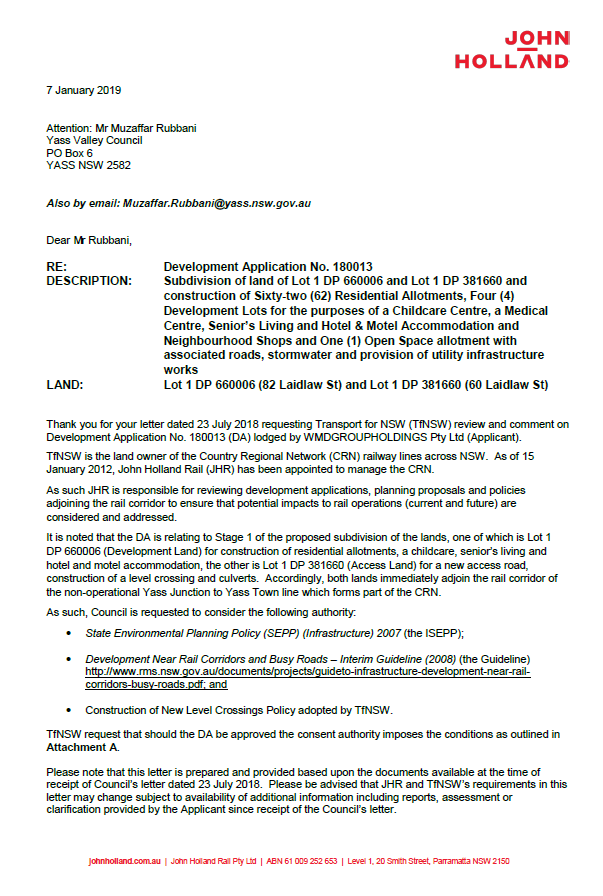
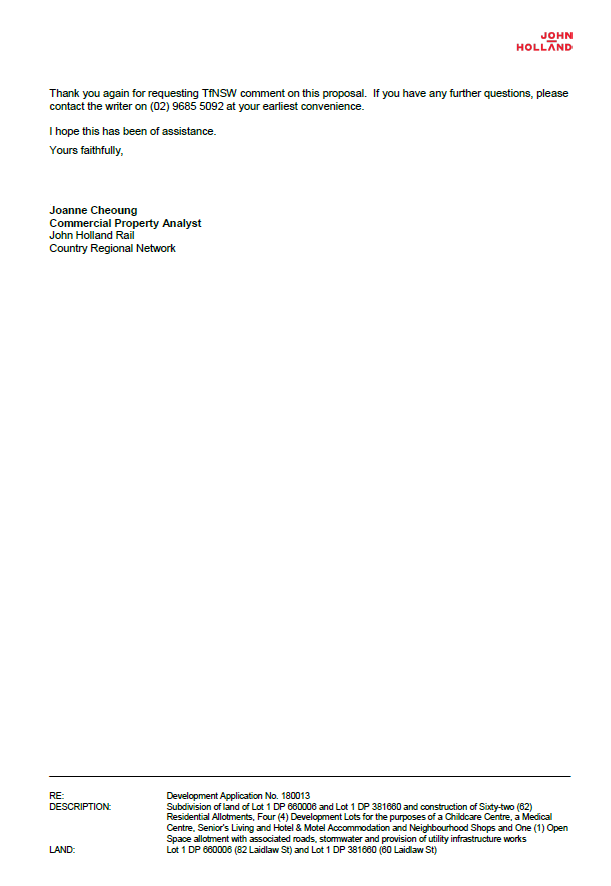
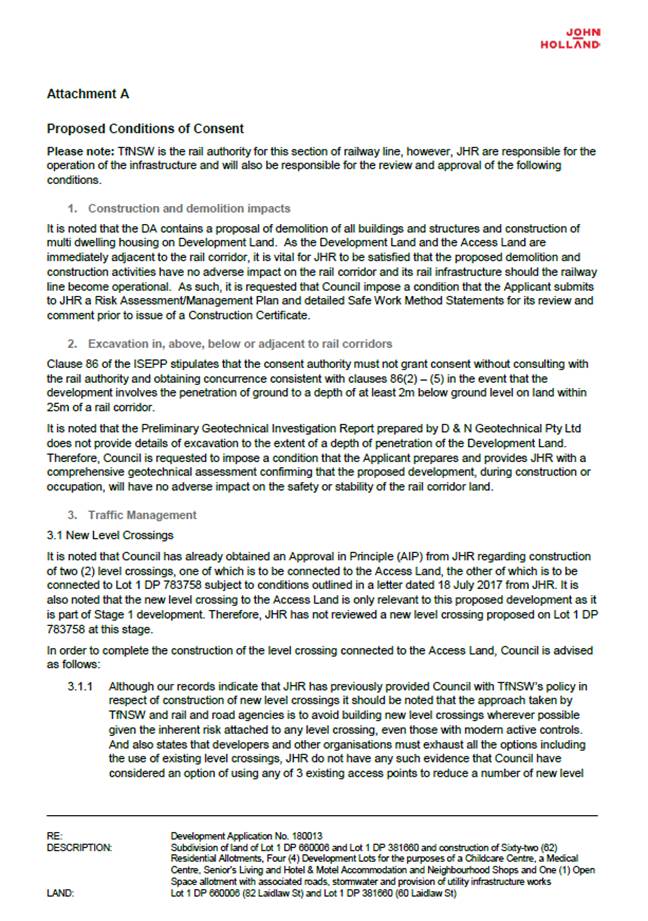
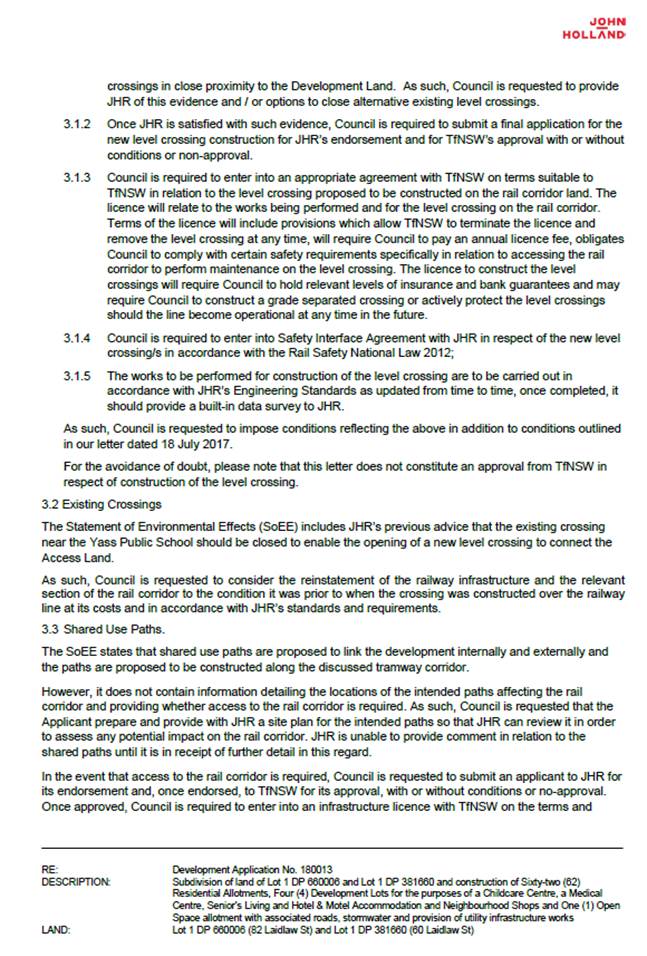
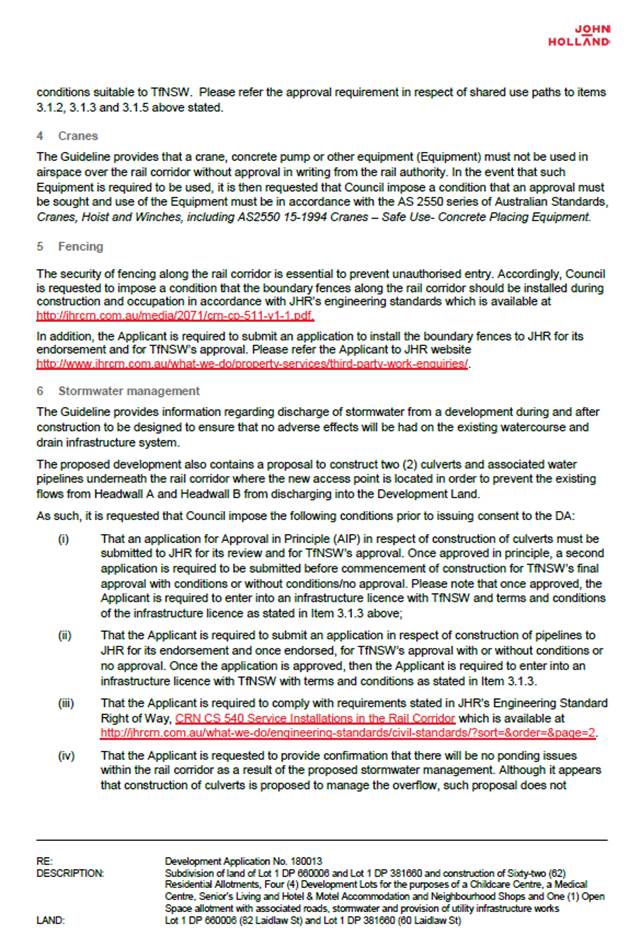
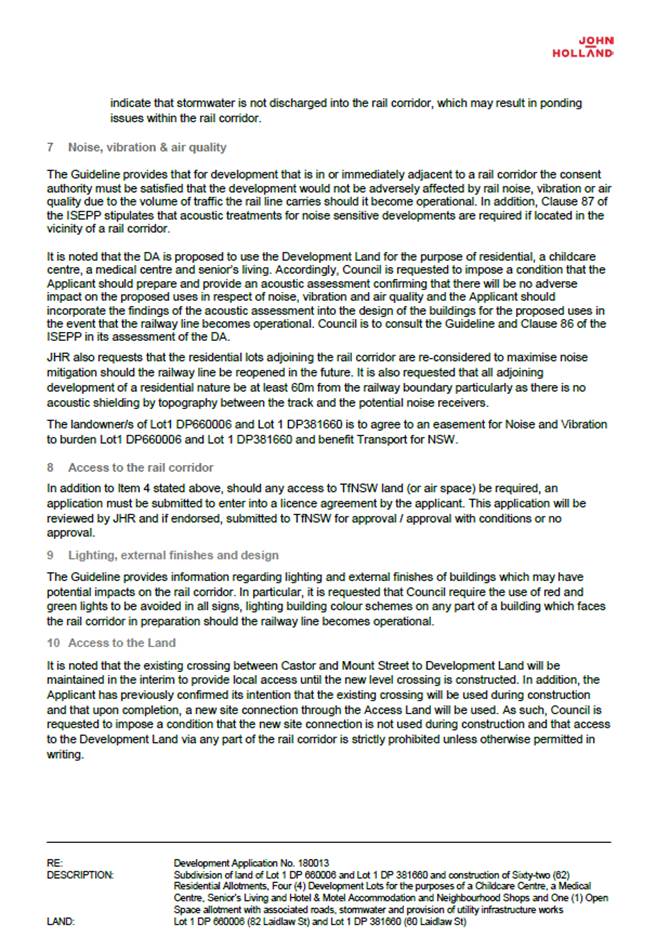
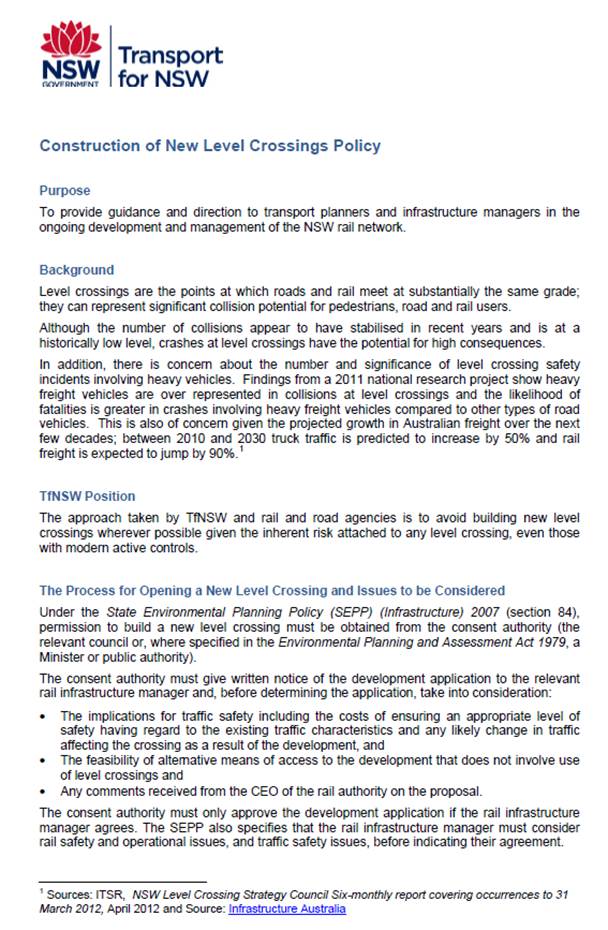
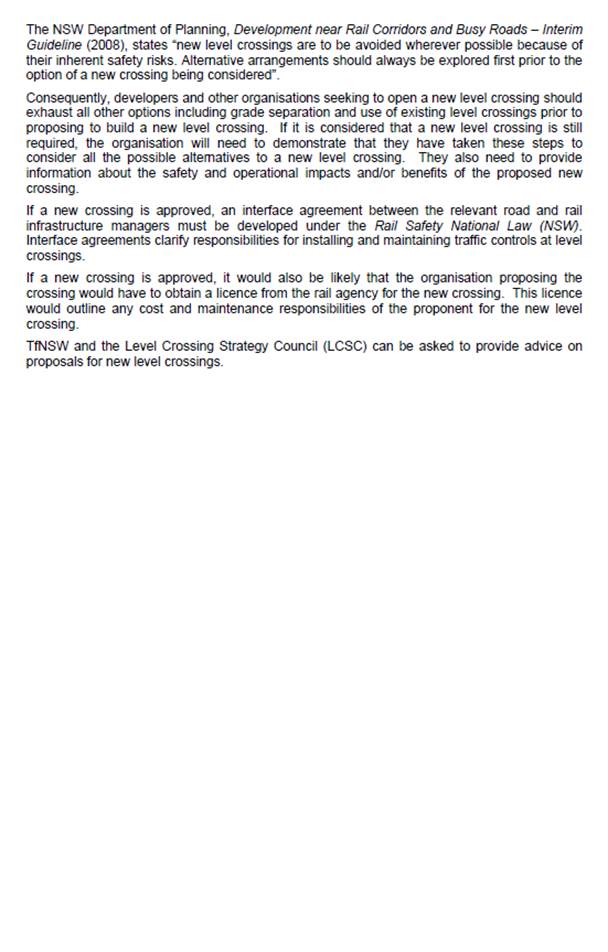
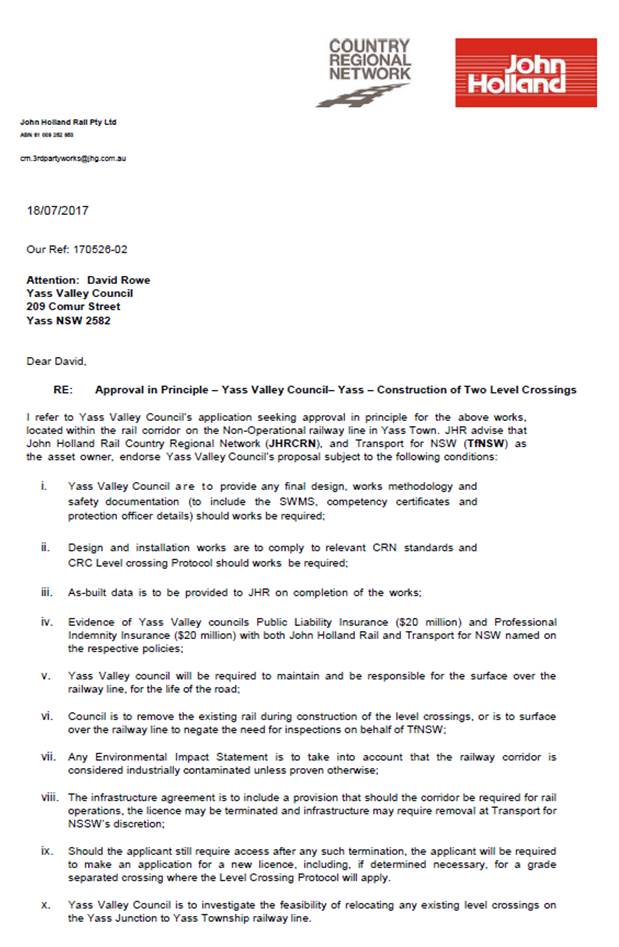

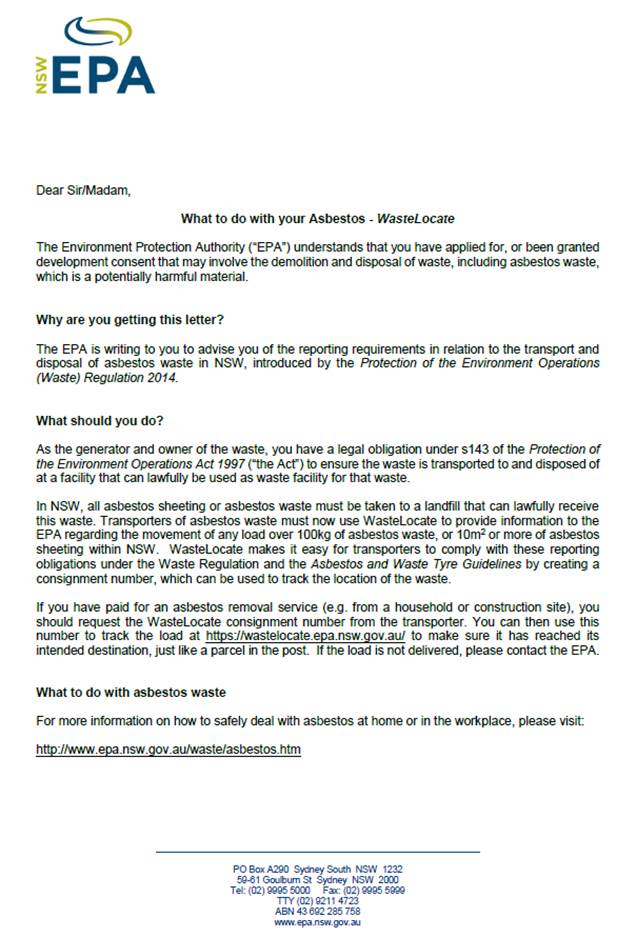
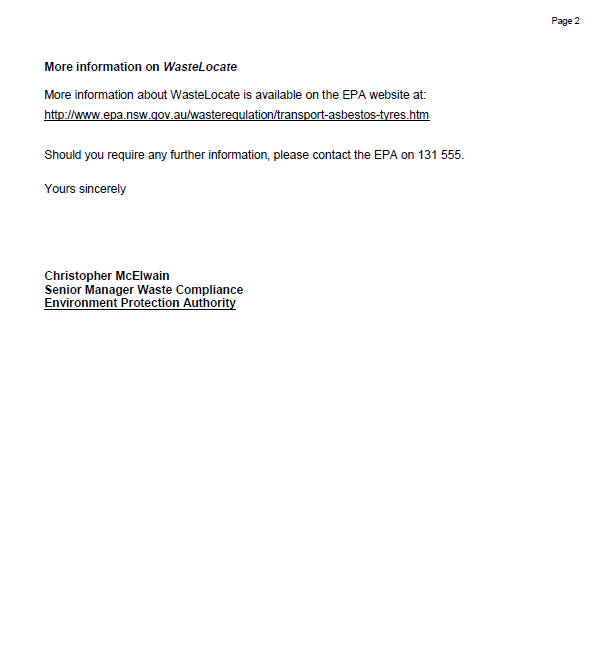
6.6 Development Application No. DA190007 - Alterations & Additions Yass Soldiers Club - 86 Meehan Street, Yass
SUMMARY
To present a report on Development Application No. 190007 for additions and alterations to Yass Soldiers Club. The application is presented to Council as the proposal involves construction of an enclosed terrace area encroaching over the footpath area of Meehan Street. It is recommended the application be approved subject to terrace area being un-enclosed similar to outdoor dining areas throughout the main street of Yass.
|
That conditional Development Consent No. DA190007 for alterations and additions at the Yass Soldiers Club, 86 Meehan Street, Yass be issued subject to the submission of revised plans showing the outdoor dining area as an un-enclosed area, consistent with other existing outdoor dining areas within Yass CBD.
|
FINANCIAL IMPLICATIONS
Resources for development assessment are provided for in the current Operational Plan.
POLICY & LEGISLATION
· Environmental Planning & Assessment Act 1979
· Environmental Planning & Assessment Regulation 2000
· Local Government Act 1993
· Roads Act 1993
· Liquor Act 2007
· Smoke-free Environment Act 2000
· Yass Valley Local Environmental Plan 2013
· Road Standards Policy
REPORT
1. Application Details
|
Date Received |
- |
14 January 2019 |
|
Land |
- |
86 Meehan Street Yass |
|
Area |
- |
4,936 m2 |
|
Zoning |
- |
B2 Local Centre |
2. Site Description and Locality
The subject land is located in Meehan Street about 70m from the intersection of Meehan Street with Church Street. The site is currently occupied by Yass Soldiers Club.
The site is located within Yass Heritage Conservation Area and several heritage listed commercial buildings and the Yass Fire Station are located nearby. The site is surrounded by a mix of land uses including Yass Fire Station and commercial buildings. The surrounding area is characterised by Banjo Paterson Park, commercial development to the west and south, and residential development to the north and east.
The existing building on the subject land comprises of a bistro, cafe, function centre, gaming area, lounge bar, sports lounge and squash courts. An existing awning extends over approximately two thirds of the building frontage and for half the width of the footpath area.
A Locality Plan is included in Attachment A.
3. Proposal
The submitted application involves the additions and alterations to an existing registered club, including:
· New glass enclosed terrace area (partially located within road reserve) below the existing covered awning along Meehan Street
· Reconfiguration of the ground floor
· New toilet facilities
· Cafe
· Kid’s play room
· Seating areas around gas fire places
· Refurbishment of existing lounge bar and gaming facilities
· New alfresco gaming area
· Addition of a bar to service function rooms
· Fire safety upgrade works
The terrace in Meehan Street is to be used as an extension of the bistro area for outdoor dining. This structure is proposed to be cantilevered over the footpath with footings of the terrace being within the confines of the site boundaries. The terrace will operate during times when kitchen is open and offering food 10.00am to 10.00pm 7days a week.
Copies of submitted plans are included as Attachment B.
4. Public Exhibition
Public exhibition included notice to 28 adjoining and nearby landowners, however, no submissions have been received.
5. Assessment
An assessment of the proposal has been completed in accordance with the planning legislation. The proposal generally complies with the relevant planning controls, policies and guidelines. The key issues relate to the outdoor dining area. The planning response to these issues identified in the assessment are as follows:
5.1 Outdoor Dining Area
The proposal includes an enclosed glass outdoor dining area over part of the Meehan Street footpath area.
While an outdoor dining area is consistent with other cafes in the Yass CBD, enclosing has the potential to create a precedent for similar premises. Enclosing a public place permanently has the potential to significantly impact on the streetscape of the CBD.
Whilst the importance of a vibrant street is recognised in achieving the economic and planning objectives, this does need to be balanced by ensuring adequate footpath area for the safety of the broader community and protecting the heritage values and streetscapes of the CBD.
Enclosing the dining space will reduce the level of on street vibrancy.
Outdoor dining areas in the CBD are temporary in nature as they are removed from the footpath area when the business is not operating. However in this instance an enclosed dining area removes the footpath area from public use permanently.
It is recommended that the submitted plans be amended to remove the terrace area and make it an unenclosed outdoor dining area for consistency with other dining areas in the CBD. This adjustment is also likely to involve some reconfiguration of the internal building layout to enable access between the outdoor dining area and the bistro area.
5.2 Clear Passage Width
The Meehan Street footpath is approximately 6.2m wide. The existing awning of the building extends 4.4m over the footpath area. The enclosed area will be under the existing awning and is 3m wide. This leaves a passage of approximately 3.2m for pedestrian movements which is in excess of the 2m wide clear passage required under Council’s guidelines for footpath activities.
5.3 Smoking Regulations
The provisions of the Smoke-free Environment Act 2000 apply independently of any Development Consent that may be issued.
The NSW Health Tobacco Compliance has indicated that the existing smoking areas comply with the Smoke-free Environment Act 2000 and the new areas are required to comply separately with these requirements.
5.4 Consumption of Alcohol
The Alcohol Free Zone in the CBD prohibits the consumption of alcohol on footpath areas. A variation to the Alcohol Free Zone is required to allow alcohol to be consumed in the outdoor dining area. Council has previously allowed a variation to the Alcohol Free Zone in similar circumstances (i.e. Yazzbar).
In October 2016 Council adopted a position that footpath activities, such as outdoor dining, no longer require a permit where they are undertaken in accordance with the requirements of an approval obtained by Council for such activities. Part of this resolution included reference to the fact that the consumption of alcohol remains prohibited unless the appropriate planning approval is obtained and a variation is sought to the Alcohol Free Zone. This resolution represents a strategic desire of Council to allow consideration of such proposal on a case by case basis for licenced venues.
6. Conclusion
From the assessment of the proposal and the consideration of issues it is recommended that Consent be issued subject to a condition requiring outdoor dining area not to be enclosed. Draft conditions are included as Attachment C.
Key Pillar 1. Our Environment
CSP Strategy EN4 - Maintain a balance between growth, development and environmental protection through sensible planning
Delivery Program Action EN4.2 - Ensure development application assessment is thorough and efficient
Operational Plan Activity EN4.2.1 - Implement development process improvements to deliver quality and efficiency gains
ATTACHMENTS: a. Locality Plan ⇩
b. Plans ⇩
c. Draft Conditions ⇩
6.6 Development Application No. DA190007 - Alterations & Additions Yass Soldiers Club - 86 Meehan Street, Yass
Attachment a Locality Plan
![]()
Locality Plan
6.6 Development Application No. DA190007 - Alterations & Additions Yass Soldiers Club - 86 Meehan Street, Yass
Attachment b Plans
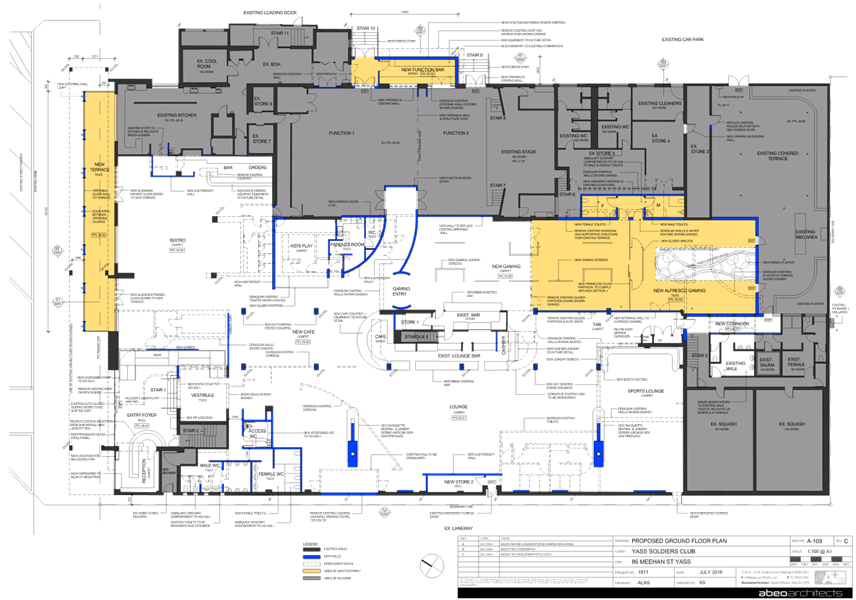
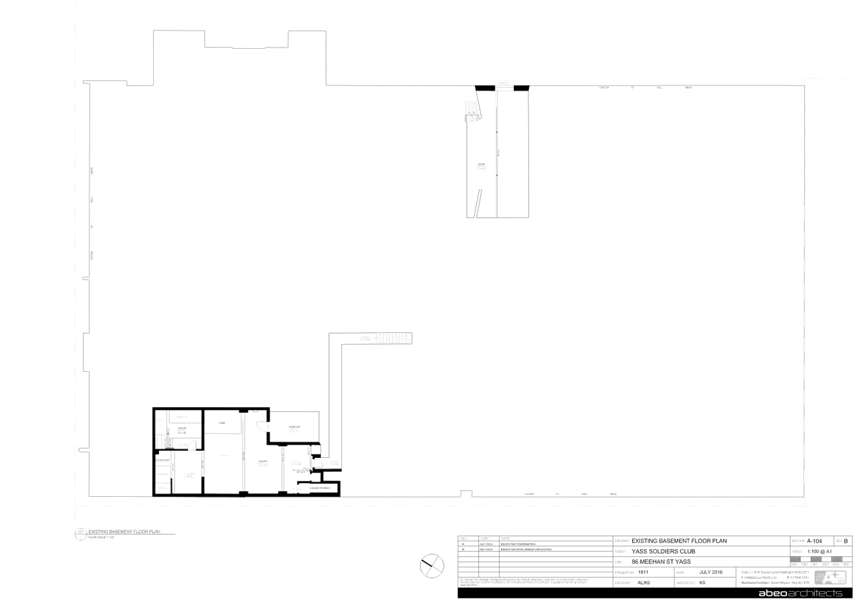
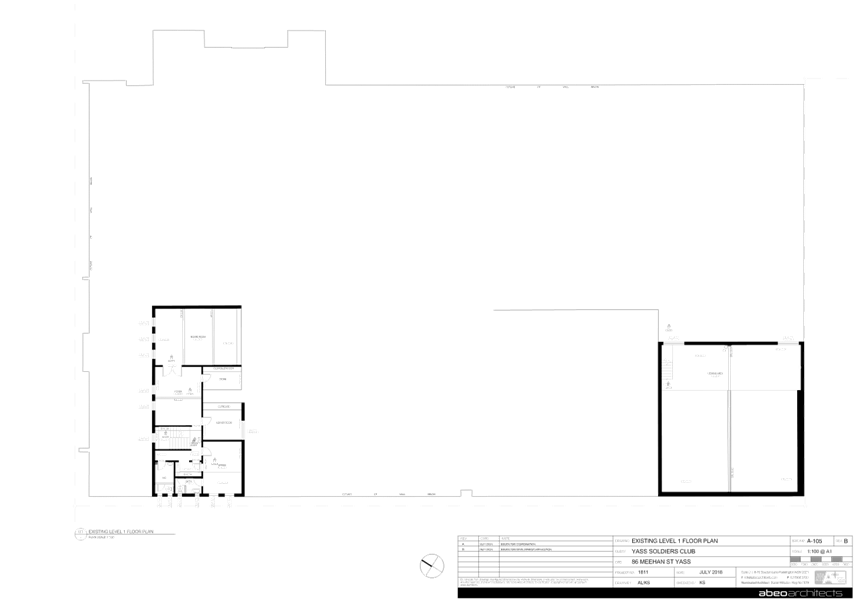
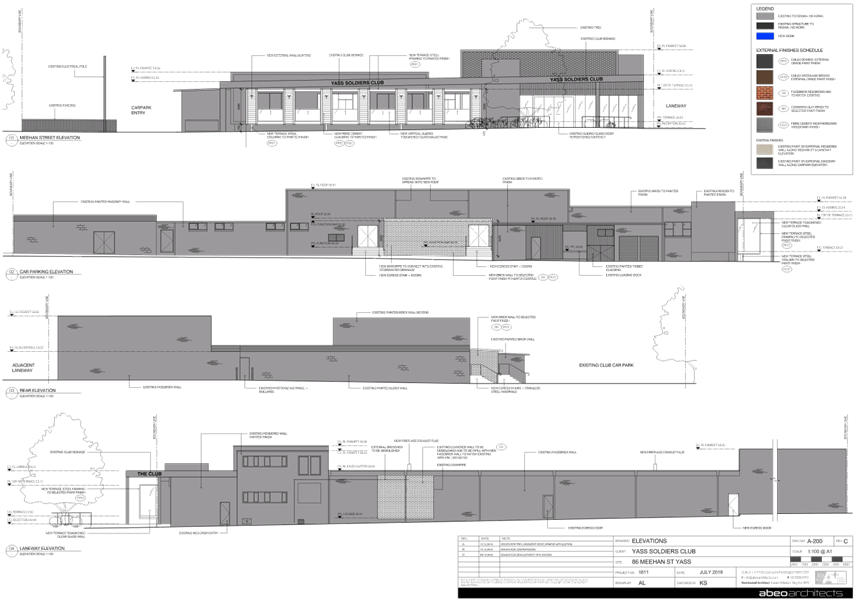
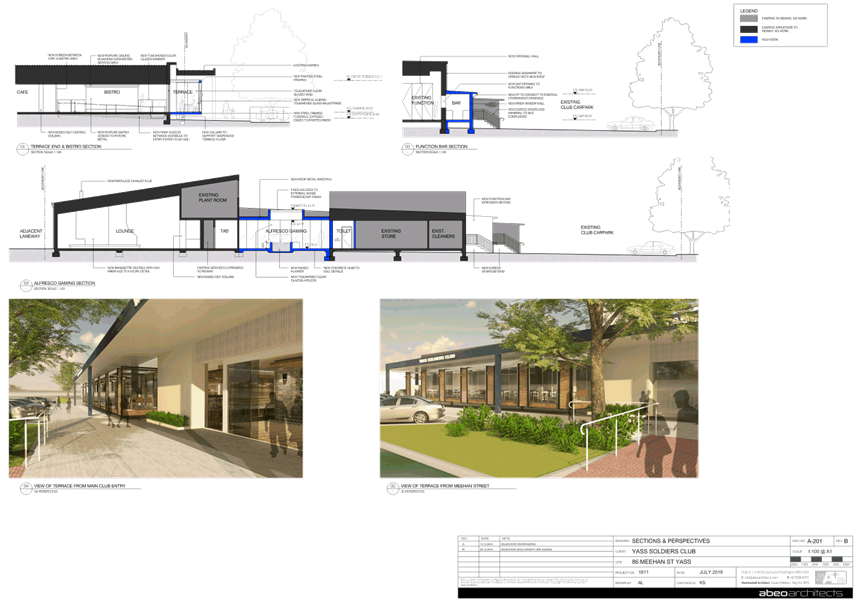
6.6 Development Application No. DA190007 - Alterations & Additions Yass Soldiers Club - 86 Meehan Street, Yass
Attachment c Draft Conditions
PART A - GENERAL CONDITIONS
(1) Consent is granted generally in accordance with the plan(s) and details submitted to Council with the Development Application. The plan(s) and details have been stamped and attached to this consent. The development shall be carried out in accordance with the stamped plans or as modified by these conditions.
(2) Work on any building shall not commence until a Construction Certificate, complying in all respects with the provisions of the Environmental Planning and Assessment Act 1979, Environmental Planning and Assessment Regulation 2000 and the Building Code of Australia, has been issued.
Note: A Construction Certificate Application has not been lodged with Council.
(3) This approval relates only to the development referred to in the development application and specifically does not amount to an approval or acceptance by the Council of any works or buildings already erected on the land, whether or not those works or buildings are the subject of a prior development or building approval.
(4) The capacity and effectiveness of runoff and erosion control measures shall be maintained at all times to the satisfaction of Council as shall any techniques to suppress dust and the tracking of sediment onto existing sealed roads.
(5) All adjustments to existing utility services whether caused directly or indirectly by this proposed development are to be undertaken at the developer’s expense.
(6) The predominant activity of the outdoor dining area must be for the service of meals for consumption to seated patrons.
(7) The applicant shall comply with all legal requirements relevant to the operation of outdoor dining area and keep in force all necessary licences & approvals.
(8) The outdoor dining area shall be smoke free as per Smoke-free Environment Act 2000 at all times.
(9) The outdoor dining area is to operate in conjunction with the existing business premises and its operating hours.
(10) The applicant shall be responsible for the good order, conduct and behaviour of the patrons using outdoor dining area.
(11) The applicant shall ensure that the outdoor dining area and surrounding footpath and locality is kept free from rubbish and waste and is disposed of in accordance with waste management standards.
(12) The applicant shall indemnify ad release Council from all liability arising from the use or occupation of the outdoor dining area including any claim made by any person for injury, loss or damage arising in any manner.
(13) The applicant must maintain a comprehensive public risk insurance policy for a minimum of twenty million dollars ($20,000,000) cover for the footpath area being occupied.
(14) All tables, chairs and surrounds to be kept clean and free of food scraps and litter.
(15) The furniture is to be suitable for outdoor use.
(16) All outdoor furniture is to be stored within the business premises when the outdoor dining area is not in operation.
(17) Furniture for outdoor dining is to be maintained in a physically sound condition.
(18) To provide for the safe movement of pedestrians a clear passage area along the footpath is to be maintained at all times. Any furniture along the building line may need to be removed or relocated should it create issues for people with disabilities.
(19) To minimise the potential for conflict between pedestrians, wait staff and diners, all tables and chairs are to be located within the area adjacent to the business premises.
(20) Prior to carrying out any works particularly within footpath area, a “Dial Before You Dig” enquiry must be undertaken to ensure no utility services are impacted by the proposed development.
(21) Prior to carrying out any works contact shall be made with all relevant utility service providers to ensure utility services infrastructure is not impacted by the proposed development.
(22) Separate approval shall be sought from the relevant utility provider should the activities encroach on to any utility infrastructure.
(23) Essential Energy’s electricity infrastructure is located within the property and within close proximity to the property, any activities within these locations must be undertaken in accordance with the latest industry guideline currently known as ISSC 20 Guideline for the Management of Activities within Electricity Easements and Close to Infrastructure. Approval shall be obtained from Essential Energy should activities within the property encroach on the electricity infrastructure.
(24) It is responsibility of the person(s) completing any works around power lines to understand their safety responsibilities. SafeWork NSW (www.safework.nsw.gov.au) has publications that provide guidance when working close to electricity infrastructure. These include the Code of Practice – Work near Overhead Power Lines and Underground Assets.
(25) The driveway access to the club carpark must remain at least three (3) metres away from any electricity infrastructure (power pole) at all times to prevent accidental damage.
PART B - PRIOR TO ISSUE OF CONSTRUCTION CERTIFICATE
(1) The applicant shall submit revised plans to principal certifying authority that shows the outdoor dining area is un-enclosed and is consistent with the existing outdoor dining areas within the CBD.
(2) Structural drawings prepared by a suitably qualified and experienced Structural Engineer shall be submitted to and approved by the PCA prior to the issue of a Construction Certificate.
Unless otherwise approved by the PCA, these plans shall detail:
(a) All reinforced concrete floor slabs and/or beams or raft slabs (having due regard to the possible differential settlement of the cut and fill areas where applicable);
(b) Footings for the proposed structure;
(c) Structural steel beams/columns;
(d) Roof framing members;
(e) Hold-down/connection details;
(f) Wall and roof bracing details.
(3) Plans and specifications demonstrating compliance with the National Construction Code/Building Code of Australia are to be submitted to and approved by the Principal Certifying Authority prior to the issue of a construction certificate.
PART C - PRIOR TO COMMENCEMENT OF WORKS
(1) Council shall be informed of the name and details of the Principal Certifying Authority and the date construction work is proposed to commence, no later than two days prior to such commencement;
(2) Appropriate soil erosion and sediment control measures shall be installed;
(3) A sign shall be displayed in a prominent position on any site on which building, work, subdivision work or demolition work is being carried out.
The sign must list the following details:
Ø The name, address and telephone number of the Principal Certifying Authority; and
Ø The name of the Principal Contractor and an after-hours telephone number; and
Ø That unauthorised entry to the site is prohibited.
The sign must be maintained while the building work, subdivision work or demolition work is being carried out and removed upon completion.
(4) Public access to the site and building works, materials and equipment on the site is to be restricted, when building work is not in progress or the site is unoccupied.
Note: The public safety provisions must be in place prior to the commencement of any demolition, excavation or building works and be maintained throughout construction.
(5) Toilet facilities must be provided at the work site on which work involved in the erection or demolition of a building is being carried out. Each toilet provided must be:
(a) a flushing portable toilet maintained under a service agreement with an accredited service provider; or
(b) a standard flushing toilet connected to a public sewer; or
(c) a standard flushing toilet connected to an accredited on-site sewage management facility approved by Council.
(6) The building(s) shall be set out by a registered surveyor to verify the correct position of each structure in relation to the property boundaries prior to the commencement of works.
Evidence that the building(s) were set-out and have been located in accordance with the approved plans shall be submitted to the Principal Certifying Authority or Council upon request.
(7) Any contractor undertaking works in a Council road reserve shall be recognised by Council as an “Approved Contractor” for such works.
The contractor shall also submit the following details to Council not less than three days prior to works commencing:
(a) A current public liability certificate with a minimum cover of $20 million;
(b) Current Plant / vehicle insurances;
(c) A certified traffic control plan for the proposed works.
(8) Each Plumber and Drainer that works on the development must notify the Yass Valley Council of their intention to carry out works as outlined in the Plumbing and Drainage Act 2011. Such notification is to come in the form of the standard Notice of Work (NoW) form prepared by the Office of Fair Trading.
Note: The minimum amount of notice under this Act is two business days.
PART D – INSPECTIONS
(1) Critical stage inspections as required by Clause 162A of the Environmental Planning and Assessment Regulation 2000 must be carried out by the Principal Certifying Authority.
Where Council is nominated as the Principal Certifying Authority Inspections will be required at the following stages of construction:
|
Inspection |
Hold Point |
|
(a) After excavation of footings
|
Prior to pouring concrete, after placement of erosion and sediment control measures, on-site toilet and signage.
|
|
(b) Bearers and Joists |
Prior to placement of floor sheeting.
|
|
(c) Floor slab |
Prior to pouring concrete.
|
|
(d) Frame/Pre-sheet |
Prior to placing internal sheeting, after all internal services including water plumbing and electrical are installed and external cladding has been fixed.
|
|
(e) Waterproofing of wet areas |
Prior to the placement of tiling and/or covering.
|
|
(f) Stormwater |
Prior to backfilling or covering pipes and connections to services.
|
|
(g) Interim Occupation |
Building completed with minor works outstanding – able to be occupied.
|
|
(h) Final |
All works relating to the proposed development are complete and all conditions of development consent are complied with. |
(2) As the local plumbing and drainage regulator Yass Valley Council must undertake inspections at the following stages of construction:
|
Inspection |
Hold Point |
|
(a) All internal sanitary drainage. |
Prior to backfill;
|
|
(b) All external sanitary drainage
|
Prior to backfill;
|
|
(c) At the completion of all plumbing and drainage works. |
Prior to the occupation of the dwelling. |
(3) Upon inspection of each stage of construction, the Principal Certifying Authority (or other suitably qualified person on behalf of the principal certifying authority subject to the provisions of the Environmental Planning and Assessment Act 1979 and Environmental Planning and Assessment Regulation 2000) is also required to ensure that adequate provisions are made for the following measures (as applicable), to ensure compliance with the terms of Council’s approval:
(a) Sediment control measures.
(b) Provision of perimeter fences or hoardings for public safety and restricted access to building sites.
(c) Maintenance of the public place free from any unauthorised materials, waste containers or other obstructions.
(4) Roof truss and wall bracing details are to be supplied to the Principal Certifying Authority prior to frame inspection.
PART E – DEMOLITION
(1) All demolition work is to be carried out in accordance with the provisions of Australian Standard AS 2601-1991: The Demolition of Structures;
(2) All utility services are to be disconnected to the requirements of the relevant authorities;
(3) Asbestos waste, if present in the building proposed to be demolished, is to be removed, handled, transported and disposed of in accordance with NSW WorkCover requirements and the provisions of both the Protection of the Environment Operations Act 1997 and the Protection of the Environment Operations (Waste) Regulation 2014;
Note: There is no waste facility licensed to receive asbestos within the Yass Valley Local Government Area. The nearest suitably licensed waste management facilities are located in Jugiong and Canberra.
(4) All waste is to be disposed of at a suitably licenced waste management facility. Copies of receipts relating to the disposal of waste must be submitted to the Yass Valley Council upon request.
(5) The deliberate burning of demolition materials shall not be permitted.
(6) All demolition work must be carried out totally within the allotment boundaries and must not extend onto public footpath, public roadway or adjoining properties.
(7) Vehicles transporting demolition material off site shall have loads secured against any loss during transit.
PART F – CONSTRUCTION
(1) The applicant shall adhere to the following days and hours of operation for the construction of the development unless otherwise approved by Council in writing:
· 7.00 am to 6.00 pm Monday to Friday
· 8.00 am to 1.00 pm Saturday
· No work on Sundays or Public Holidays
(2) All building work shall be carried out in accordance with the provisions of the National Construction Code/Building Code of Australia (as amended) and all relevant Australian Standards;
(3) Noise and dust generated during construction of the proposed development shall comply with the provisions of the Protection of the Environment Operations Act 1997.
(4) All construction and or demolition waste associated with the development shall be disposed of at a licensed waste management facility after being separated into components of:
· Asbestos
· Clean fill
· Bricks, tiles, concrete
· Steel
· Other metals
· Timber & vegetation and
· Other material.
Any asbestos shall be handled, removed, wrapped and transported in accordance with relevant regulations and WorkCover requirements.
Copies of receipts relating to the disposal of waste at a licensed waste management facility (or facilities) must be submitted to the Yass Valley Council upon request.
(5) To minimise soil erosion and sediment movement during construction, the following measures shall be implemented:
(a) Removal and/or disturbance of vegetation shall be confined to the basal area of the approved building, the site of permanent accessways, and land extending a maximum of three metres beyond the outermost projection of the approved building.
(b) Topsoil stripped from the construction site shall be stockpiled and protected from erosion until re-use during landscaping.
(c) Stockpiles of construction and landscaping materials, and of site debris shall be located clear of drainage lines and in such a position that they are within the erosion containment boundary or are equivalently protected from erosion and do not encroach upon any footpath, nature strip or roadway.
(d) Final site spoil shall be disposed of to the satisfaction of Council.
(e) Trenches shall be backfilled, capped with topsoil and compacted to a level at least 75mm above adjoining ground level.
PART G – PLUMBING AND DRAINAGE
(1) All Plumbing and Drainage work shall comply with the provisions of the Plumbing Code of Australia.
(2) Plumbing and Drainage shall comply with the provisions of the Plumbing and Drainage Act 2011 and Plumbing and Drainage Regulation 2012.
Note: The Plumbing and Drainage Act 2011 requires each Plumber and Drainer that works on the development to submit the following information to the Yass Valley Council:
· Notice of Work (NoW);
· Sewer Service Diagram (SSD);
· Certificate of Compliance (CoC).
(3) Sewer boundary riser is to be located and exposed at all times. If there is no existing sewer boundary riser, then a sewer boundary riser shall be installed by licenced Plumber in accordance with AS 3500.
PART H – STORMWATER DRAINAGE
(1) Stormwater drainage work shall comply with AS/NZS 3500.3, 2003 - Stormwater drainage;
(2) Stormwater collected from the development shall not cause nuisance to adjoining landowners;
(3) Where up-stream surface water flows through the allotment the development shall not redirect or divert this water in such a manner that would intensify flows onto adjoining properties.
(4) Adequate provision shall be made for the disposal of roof water collected from the development. In this regard roof water shall be piped and discharged to one of the following as applicable:
(a) The street stormwater drainage system;
(b) Inter-allotment stormwater drainage system;
(c) A rubble pit designed by a suitably qualified person to cater for a 1 in 5 year rainfall event. The pit design shall make suitable provision for overflow.
PART I - PRIOR TO ISSUE OF ANY OCCUPATION CERTIFICATE
(1) Where applicable, the applicant shall submit to the PCA product testing which demonstrates compliance with the provisions of Specification C1.10 of Volume 1 of the National Construction Code (NCC)/Building Code of Australia (BCA) prior to the issue of an Occupation Certificate.
(2) The fire safety measures, as detailed in the relevant Fire Safety Schedule are to be installed and maintained in accordance with the provisions of Clause 168 Environmental Planning and Assessment Regulation 2000.
(3) A fire safety certificate in accordance with Clause 174 Environmental Planning and Assessment Regulation 2000 is to be submitted to the Yass Valley Council prior to the issue of an Occupation Certificate.
PART J - PRIOR TO ISSUE OF A FINAL OCCUPATION CERTIFICATE
(1) A Final Occupation Certificate will not be issued until all conditions of this consent have been complied with in accordance with the provisions of the Environmental Planning and Assessment Act 1979 and Environmental Planning and Assessment Regulation 2000.
(2) Prior to the issue of any Final Certificate of Occupancy, individual Certificates of Compliance are to be submitted to Yass Valley Council certifying that the following specialist work (as applicable to the development):
· Plumbing/drainage work
· Gas fitting work
· Electrical work
· Installation or maintenance of refrigeration systems
· Air-conditioning work
has been undertaken by a tradesperson licensed by the NSW Department of Fair Trading and complies with all relevant Australian Standards and the Building Code of Australia (as amended).
Note: A copy of the tradespersons license number, name, address and the Australian Standards to which the certificate relates is to be included on any Certificate of Compliance submitted to Yass Valley Council.
(3) The developer shall restore, replace or reconstruct any damage caused to road pavements, surfaces, street furniture, roadside drainage, street lighting or underground facilities as a result of the construction of the development.
ADVISORY NOTES ACCOMPANYING DEVELOPMENT CONSENT DA190007
Please read these notes carefully to ensure you are fully conversant with the conditions under which this consent is granted.
(1) This consent has been granted under Clause 2.3 of the Yass Valley Local Environmental Plan 2013;
(2) All fees and charges associated with this consent shall be adjusted annually from the date of this consent in accordance with seasonal movements in the CPI for the Canberra region;
(3) Any additional Council inspection, beyond the scope of any Compliance Certificate package and needed to verify the compliance of any work, shall be charged at the individual inspection rate nominated in Council’s Fees and Charges Schedule;
(4) This development consent does not guarantee compliance with land specific agreements, by-laws, covenants, 88B restrictions, community management plans, or other similar development restrictions that may be applicable to the land. It is the responsibility of the land owner, applicant and developer to make their own enquiries in order to be satisfied that compliance with these restrictions has been achieved.
(5) The applicant shall ensure all sub-contractors are licensed by the NSW Department of Fair Trading;
(6) The following items shall be considered where the proposed development looks to achieve compliance with the ‘deemed to satisfy’ provisions of the Building Code of Australia:
· A complying fire hydrant system must be provided to serve the building. A compliant system satisfies this requirement if it complies with Australian Standard 2419.1 Fire Hydrant Installations – System Design, Installation and Commissioning and Part E1.3 of the Building Code of Australia;
· Fire Hose Reels shall be designed and installed in the building and/or on-site in accordance with Part E1.4 of the Building Code of Australia and AS 2441;
· Portable fire extinguishers shall be installed in the building or portions of the building compatible to the hazard/s posed by equipment or functions associated with the use of the building, in accordance with Part E1.6 of the Building Code of Australia and AS 2444 (Portable Fire Extinguishers and Fire Blankets Selection and Location);
· Required exit doors are to swing in the direction of egress in accordance with clause D2.20 of the Building Code of Australia;
· The proposed exits are not to be blocked at the point of discharge. Where necessary, suitable barriers must be provided to prevent vehicles from blocking the exit or access to it;
· A door in a required exit, forming part of a required exit or in the path of travel to a required exit, must be readily openable without a key from the side that faces a person seeking egress, by a single hand action on a single device which is located between 900mm and 1100mm from the floor;
· An emergency lighting system which complies with AS 2293.1- 2005 Emergency escape lighting and exit signs for buildings shall be installed within the building;
· All required exit doors shall be provided with Illuminated exit signage which complies with AS 2293.1- 2005 Emergency escape lighting and exit signs for buildings;
· All new walkways, platforms, ladders, stairs, ramps, landings, handrails or balustrades providing access to the building shall comply with Part D of the Building Code of Australia;
· Access for people with disabilities is to be provided to the building from any required accessible car parking space on the allotment by means of a continuous path of travel in accordance with AS 1428.1, ‘Design for Access and Mobility’;
· The accessible sanitary facility and the sanitary facility for persons with ambulant disabilities shall be constructed in accordance with AS 1428.1: ‘Design for Access and Mobility’;
· The main points of pedestrian entry into the building shall achieve compliance with AS 1428.1-2009 ‘Design for Access and Mobility’. Particular attention should be given to the following:
Ø Colour contrast between the door and the door frame;
Ø The width of the door;
Ø Door hardware;
· Tactile ground surface indicators shall be provided in accordance with Clause D3.8 of the Building Code of Australia, Volume 1 and AS1428.4;
· Signage shall be provided in accordance with Clause D3.6 of the Building Code of Australia, Volume 1 and AS1428.1;
· The unobstructed width of each path of travel to an exit must be not less than 1m;
(7) The Work Health and Safety Act 2011, the Work Health and Safety Regulation 2011 and various Australian Standards provide a comprehensive set of risk control measures and procedures for development sites which cover all types of risk. This legislation is administered by WorkCover New South Wales which has produced a variety of guidelines and other supporting documents for the information of developers.
All persons undertaking work in connection with this consent should ensure that all required risk control measures and procedures are complied with.
(8) To arrange a building or plumbing inspection please use Councils on-line book system. Access to the booking system and information about Inspections is available on Council’s website - https://www.yassvalley.nsw.gov.au/our-services/planning-and-building/certification-and-inspections/inspections/
Your development is in the Yass area for the purpose of booking these inspections.
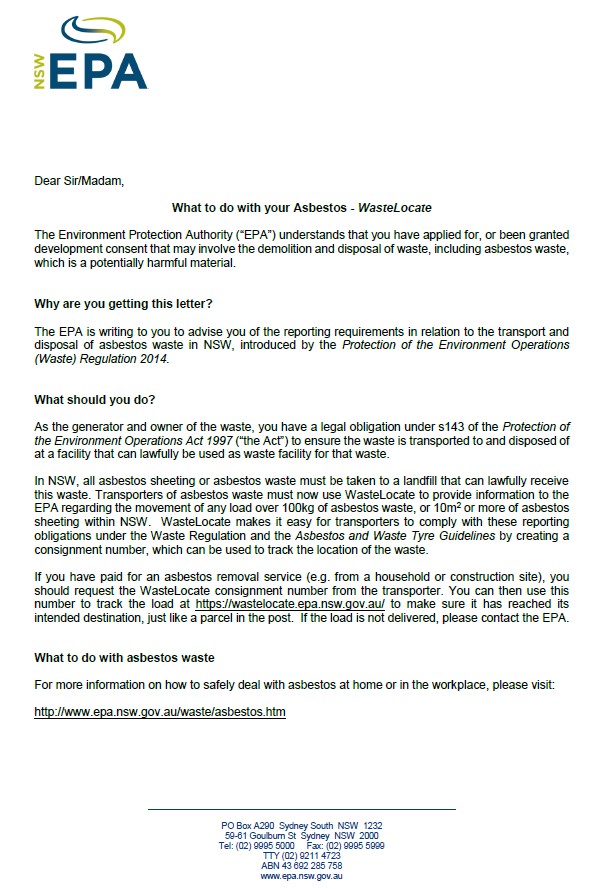

Ordinary Council Meeting 24 April 2019
SUMMARY
To update council on rate arrears to the end of the third quarter of the 2018/19 financial year.
Rate arrears totalled $559,428.67 as at 30 June 2018 and this has now been reduced to $352,893.47 as of 31 March 2019. This represents an improvement of $206,535.20 or 36.92%.
|
That the information be noted. |
Financial IMPLICATIONS
Nil.
POlicy & Legislation
Rate arrears are closely monitored and debt recovery is fully compliant with Council’s Debt Recovery Policy FS-POL-3.
REPORT
Table 1 – Arrears as of 31 March 2019
|
|
Rates and Charges Levied (includes interest) |
Paid 1 July to 31 March |
Balance Outstanding |
% Paid 1 July to 31 March |
|
Arrears to 30/6/2018 |
$559,428.67 |
$206,535.20 |
$352,893.47 |
36.92 |
|
Current Years Rates and Charges billed since 1/7/18 |
$16,595,896.76 |
$12,047,605.46 |
$4,548,291.30 |
72.59 |
|
TOTALS |
$17,155,325.43 |
$12,254,140.66 |
$4,901,184.77 |
71.43 |
Table 2 – Summary of Prior Year’s Outstanding Balance as of 31 March 2019
|
Year |
No of Assessments |
Amount |
|
2004/2005 |
1 |
$201.52 |
|
2005/2006 |
1 |
$309.09 |
|
2006/2007 |
1 |
$342.02 |
|
2007/2008 |
1 |
$437.26 |
|
2008/2009 |
5 |
$2,791.12 |
|
2009/2010 |
5 |
$3,497.44 |
|
2010/2011 |
5 |
$3,408.90 |
|
2011/2012 |
6 |
$4,366.34 |
|
2012/2013 |
6 |
$6,547.15 |
|
2013/2014 |
9 |
$8,952.85 |
|
2014/2015 |
12 |
$17,892.29 |
|
2015/2016 |
18 |
$20,895.24 |
|
2016/2017 |
42 |
$48,447.15 |
|
2017/2018 |
265 |
$234,805.10 |
|
|
TOTAL |
$352,893.47 |
Table 3 – Rates and Charges Levied and Payments Made 1 July to 31 March
|
|
Rates and Charges Levied (includes interest) |
Paid 1 July to 31 March |
Balance Outstanding |
% Paid 1 July to 31 March |
% Rates & Charges Outstanding as of 30 June * |
OLG Bench mark |
|
1/7/15 – 31/3/16 |
$13,006,655.02 |
$9,927,397.67 |
$3,079,257.35 |
76.33% |
5.75% |
10.00% |
|
1/7/16 – 31/3/17 |
$14,215,953.14 |
$10,770,481.39 |
$3,445,471.75 |
75.76% |
4.02% |
10.00% |
|
1/7/17 – 31/3/18 |
$15,340,492.26 |
$11,530,058.84 |
$3,810,433.42 |
75.16% |
4.07% |
10.00% |
|
1/7/18 – 31/3/19 |
$16,595,896.76 |
$12,047,605.46 |
$4,548,291.30 |
72.59% |
|
10.00% |
Note: Special rate variation in place 2016/17 to 2019/20
* Includes provision for doubtful debts, percentage outstanding figure taken from council’s annual statement.
The rate arrears as of 30 June 2018 showed an outstanding balance of $559,428.67 which has now been reduced to $352,893.47 as shown in Table 1. The yearly breakup of these arrears is shown in Table 2.
The Rates & Charges Levied and the payments made up until the end of the financial year is shown in Table 3. Also included are comparative figures for the previous three financial years. It can be seen that percentage of rates & charges paid for the past four years has been relatively constant despite the special rate variation being in effect since 1/7/16. The small decrease in rates paid for the current financial year can be attributed to the lack of recovery action over the last nine months. This was due to officers becoming familiar with Council’s new computer software and will be addressed prior to the end of the financial year.
Key Pillar 5. Our Civic Leadership
CSP Strategy CL4 - Actively investigate and communicate funding sources and collaboration opportunities that can strengthen the region
Delivery Program Action CL4.1 - Monitor and distribute information from government agencies relating to funding opportunities
Operational Plan Activity CL4.1.1 - Develop a register of community organisations to target the distribution of grant information in a timely manner
Ordinary Council Meeting 24 April 2019
8.2 Investment and Borrowings Report
SUMMARY
In accordance with the Local Government (General) Regulation 2005 (NSW) Clause 212, this report provides a summary of Council’s investments as at 31 March 2019. In accordance with paragraph (1)(b), it can be certified that the investments listed have been made in accordance with the Act, the Regulations and Council’s Investment Policy.
|
The Investment Report as at 31 March 2019 be received and it be noted that the summary has been prepared in accordance with the Act, the Regulations and Council’s Investment Policy.
|
Financial IMPLICATIONS
Council’s investment portfolio provides funding for some projects identified in the Operational Plan.
POlicy & Legislation
Local Government Act (1993)
Local Government General Regulation (2005)
Investment Policy GOV-POL-19.
REPORT 1. Comments on Economic Climate
The RBA left the cash rate on hold again in April, marking 32 months with the cash rate remaining at 1.5%. Risks to the outlook still remain evenly balanced with the key still revolving around the employment market. The statement by the RBA continued to point to the risks to the economic outlook while contrasting those risks with the ongoing strength in the labour market.
Additionally, the RBA’s statement noted that “The Board will continue to monitor developments and set monetary policy to support sustainable growth in the economy and achieve the inflation target over time.” A statement like this has, in the past, been a precursor to a large shift in the RBA’s outlook and this could well be the RBA setting the scene for a shift to an interest rate reduction in the near future. History as a guide suggests that if the RBA were to cut rates they would follow up with a second rate cut within the next quarter.
2. Council Investments
Valuations of Council investments are detailed in Attachment A.
Details of investment compliance with Council’s Investment Policy are provided in the tables below.
Table 1 – Exposure by Credit Rating Type as at 31 March 2019
|
S&P Rating (or equivalent) |
Exposure |
Maximum % Invested per Policy |
|
A1+/AAA |
Nil |
100% |
|
A1/AA |
83.02% |
100% |
|
A2/A |
Nil |
60% |
|
A3/BBB |
7.88% |
30% |
|
N/A |
9.10% |
Note 1 |
Note 1 – The TCorp Strategic Cash Facility is an allowable investment under the Ministerial Order.
Table 2 – Exposure to Single Institutions at 31 March 2019
|
Institution |
S&P Rating (or equiv) |
Exposure |
Max Exposure per Policy |
|
NAB |
A1/AA |
38.94% |
50% |
|
IMB |
A3 |
7.88% |
30% |
|
CBA |
A1/AA |
37.50% |
50% |
|
WBC |
A1/AA |
6.58% |
50% |
|
TCorp |
N/A
|
9.10% |
Note 1 above |
3. Council Loans
Council has four loans with an estimated 31 March 2019 value of $15.488m. It should be noted that there may be small balance variations as current balances are based on indicative payment schedules. The table below provides loan details at 31 March 2019. Indicative repayments for 2018/19 are shown for both principal and interest for all current loans. Balances will not change on a monthly basis as the most frequent repayment cycle is quarterly.

Key Pillar 5. Our Civic Leadership
CSP Strategy CL1 - Effect resourceful and respectful leadership and attentive representation of the community
Delivery Program Action CL1.6 - Maximise Council’s ability to generate income
Operational Plan Activity CL1.6.3 - Review commercial activities to ensure Council is maximising returns
ATTACHMENTS: a. Investment Valuations ⇩
8.2 Investment and Borrowings Report
Attachment a Investment Valuations
Short Term Investments (Cash Accounting) as at 28 February 2019
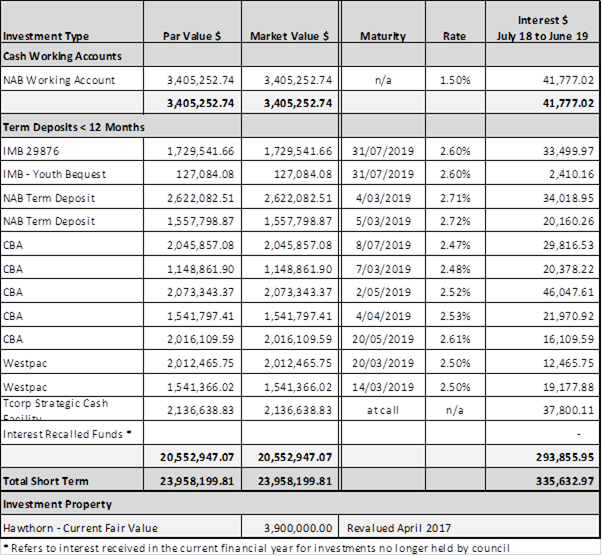
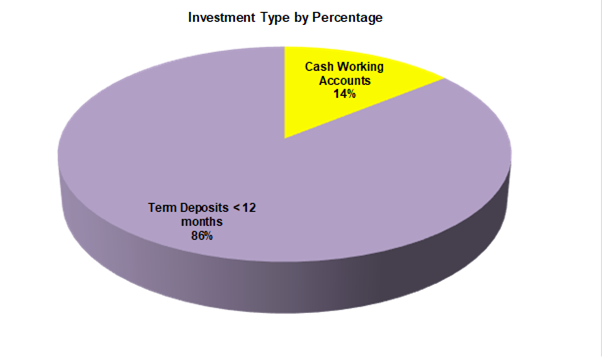
Ordinary Council Meeting 24 April 2019
9.1 New Model Code of Conduct and Procedures for Local Councils in NSW
SUMMARY
The new 2018 Model Code of Conduct for Local Councils in NSW (the Model Code of Conduct) and Procedures for the Model Code of Conduct for Local Councils in NSW (Procedures) were prescribed under the Local Government (General) Regulation 2005 on 14 December 2018. Councils have six months from the date of prescription (14 December 2018 to 14 June 2019), to adopt a code of conduct and procedures based on the prescribed Model Code of Conduct and Procedures.
Following public exhibition the Model Code of Conduct and Procedures are presented for adoption.
|
That council adopts the 2018 Model Code of Conduct for Local Councils in NSW and Procedures for the Administration of the Model Code of Conduct for Local Councils in NSW.
|
Financial IMPLICATIONS
Training in the implementation of the new Code of Conduct is included in the annual training budget.
POlicy & Legislation
Under Section 440 of the LGA, Council must adopt a code of conduct that incorporates the provisions of the Model Code of Conduct for Local Councils in NSW and Procedures for the Model Code of Conduct for Local Councils in NSW as published by the Office of Local Government (OLG).
REPORT
1. Background
Council at its meeting of 27 February resolved:
“That:
1. Council endorses the 2018 Model Code of Conduct for Local Councils in NSW and Procedures for the Model Code of Conduct for Local Councils in NSW for public exhibition for a period of 28 days.
2. Following the expiration of this period, the 2018 Model Code of Conduct for Local Councils in NSW and Procedures for the Model Code of Conduct for Local Councils in NSW and any public submissions be presented back to Council for consideration.”
The Model Code of Conduct and Procedures were placed on public exhibition from 1 March to 29 March 2019.
1.2 Submission
One submission was received (Attachment A) during the exhibition period. The following question was raised:
Can a Councillor’s position be used to provide support for a political party or candidate?
Item 6.4 - Improper and Undue Influence - Councillors are not to take advantage (or seek to take advantage) of their status or position with or of functions they perform for council in order to obtain a private benefit for themself or for any other person or body.
Response
This matter is covered in the Office of Local Government Circular 18-41 Misuse of Council Resources - March 2019 State Election (Attachment B) and is therefore already adequately addressed in the Model Code of Conduct. The circular does not prohibit politicians, including councillors, from participating in political activities. What it does do is assert the very strict rules about misuse of Council resources and facilities.
2. Adoption
Following review of the submission received it is recommended that the Draft Model Code of Conduct and Draft Procedures (Attachments C and D) be adopted as exhibited.
Key Pillar 5. Our Civic Leadership
CSP Strategy CL1 - Effect resourceful and respectful leadership and attentive representation of the community
Delivery Program Action CL1.4 - Be compliant, more efficient and effective
Operational Plan Activity CL1.4.2 - All regulated compliance is adhered to
ATTACHMENTS: a. Submission ⇩
b. OLG Circular 18-41 ⇩
c. Model Code of Conduct ⇩
d. Model Code of Conduct Procedures ⇩
9.1 New Model Code of Conduct and Procedures for Local Councils in NSW
Attachment b OLG Circular 18-41

Attachment c Model Code of Conduct
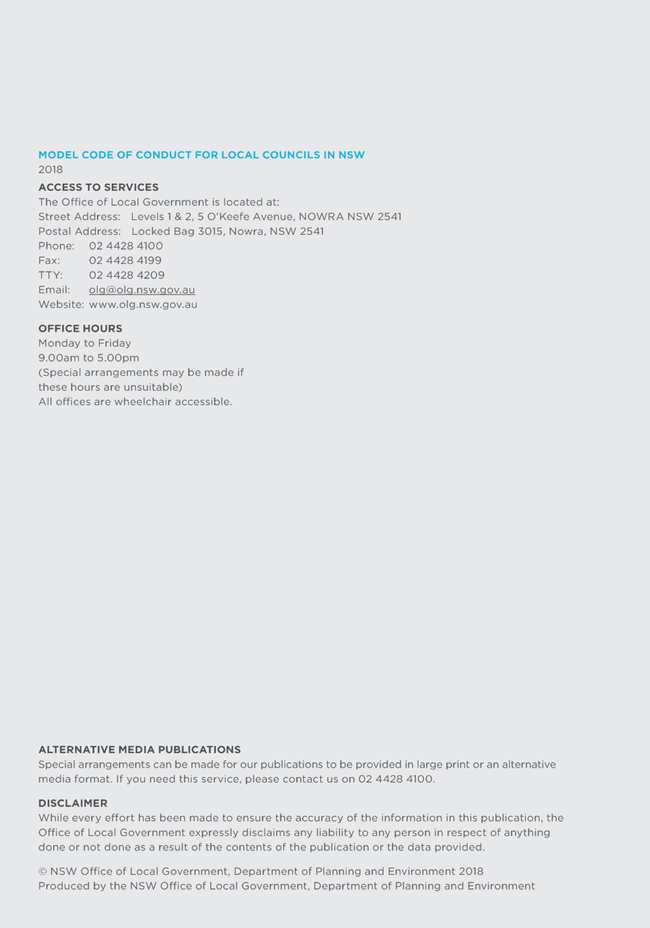
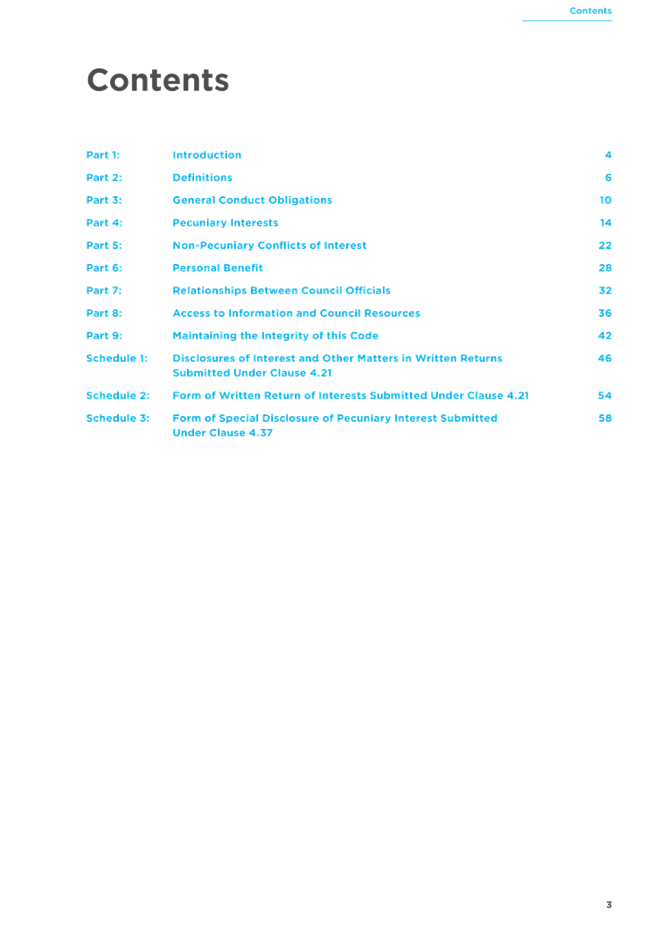

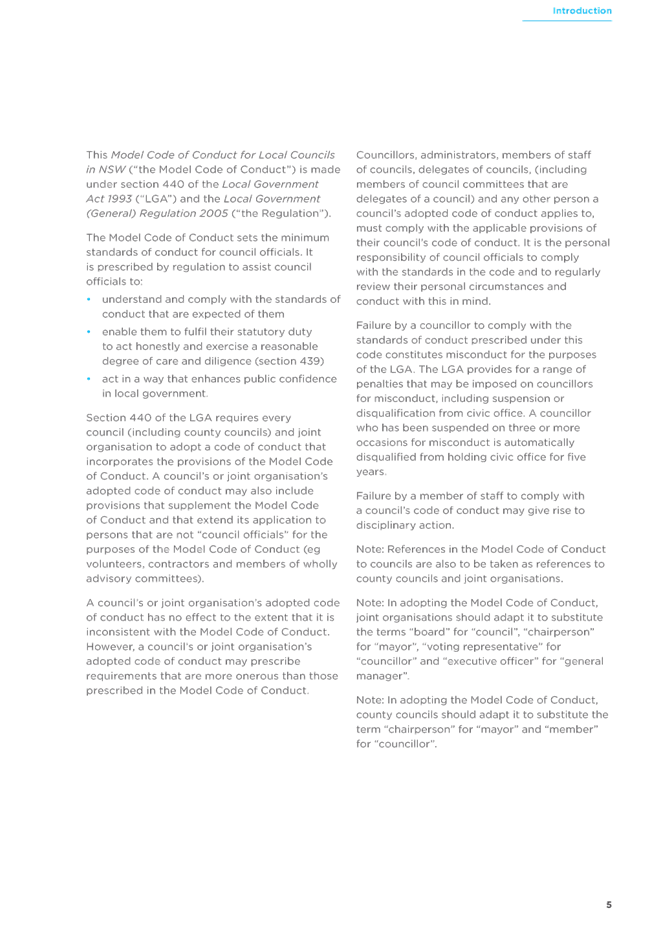

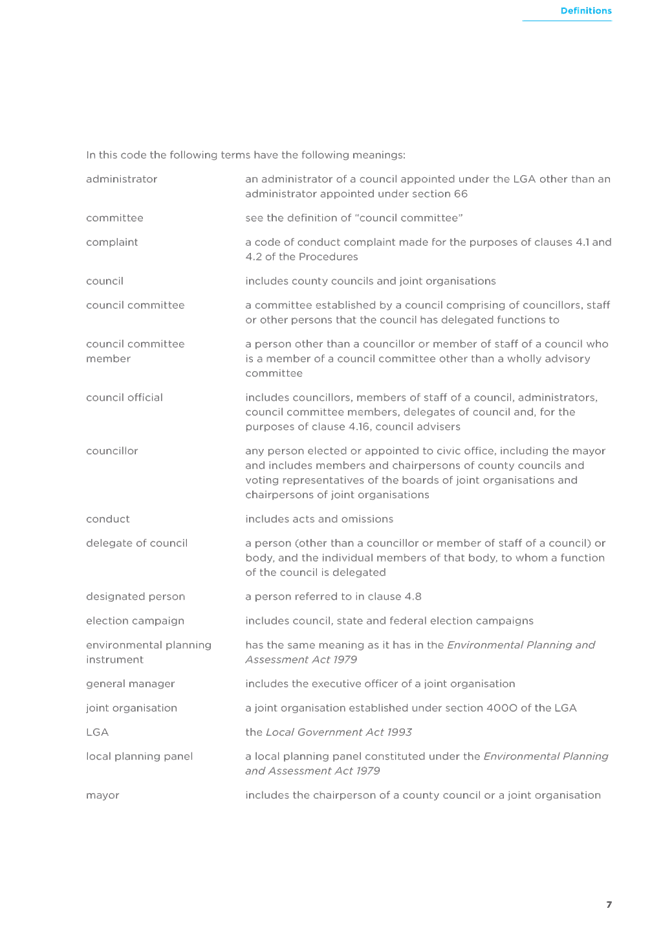
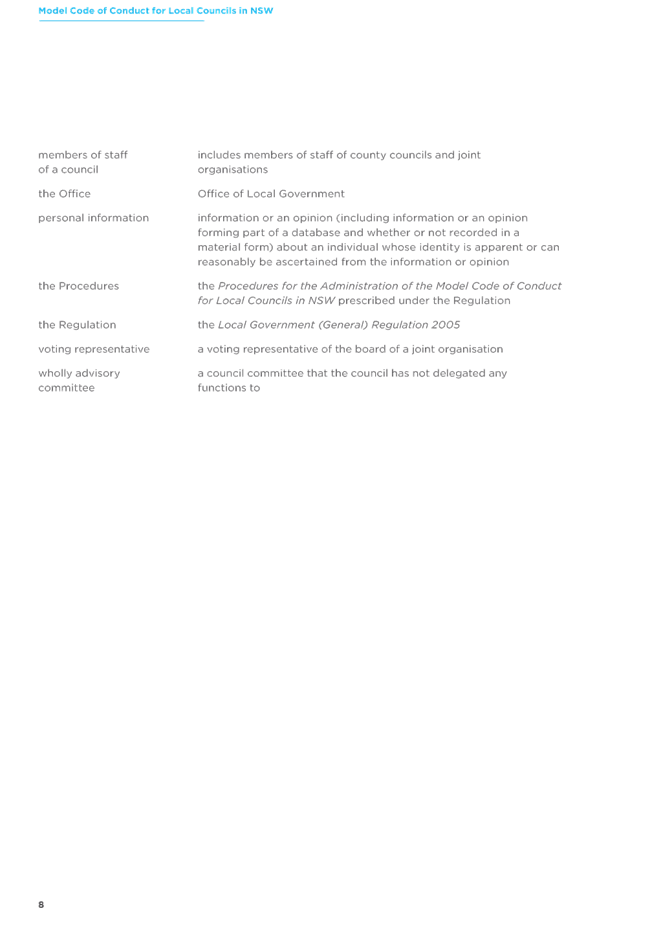

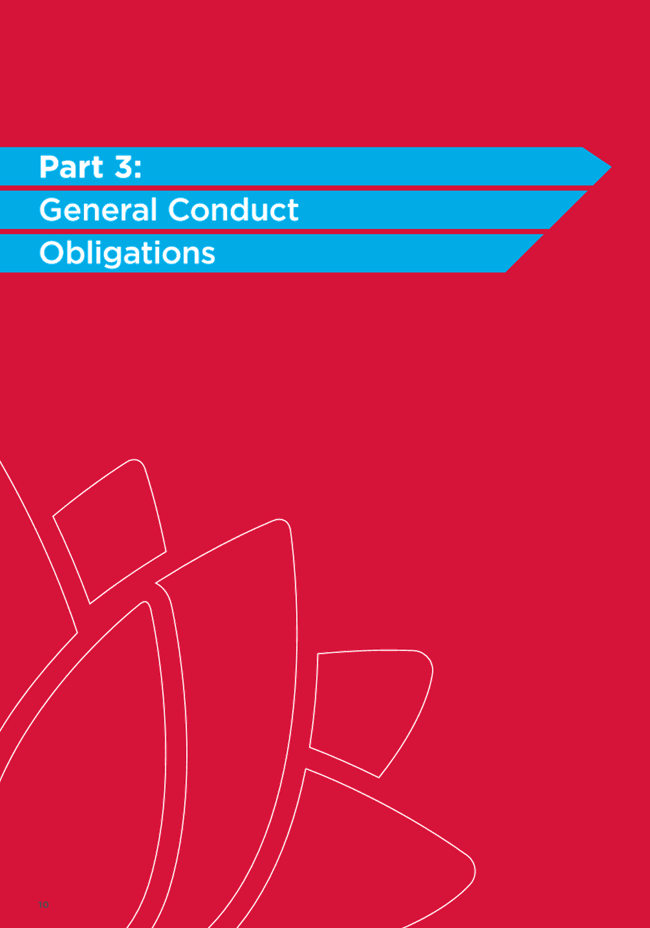
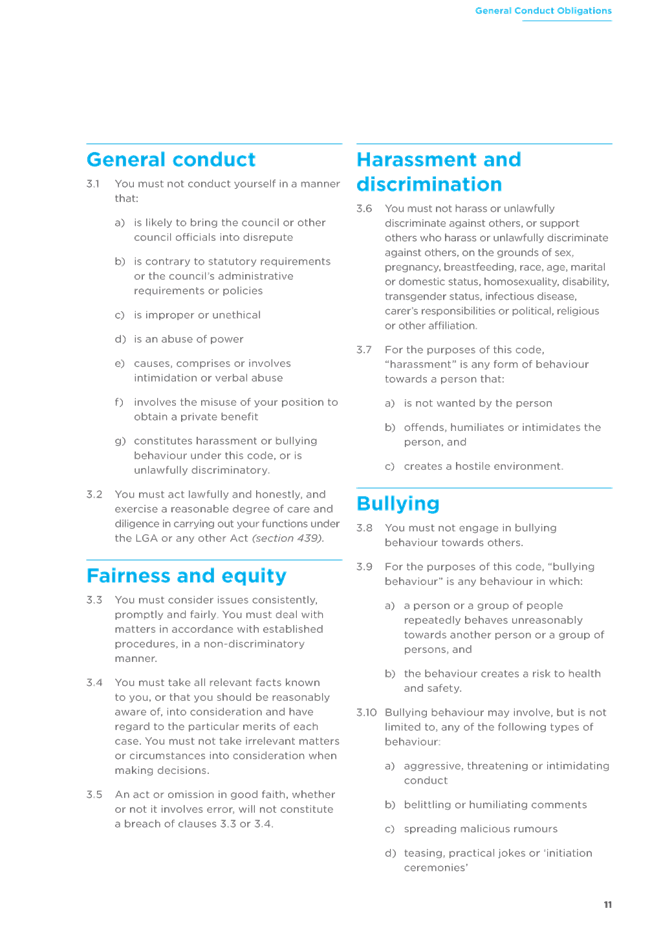

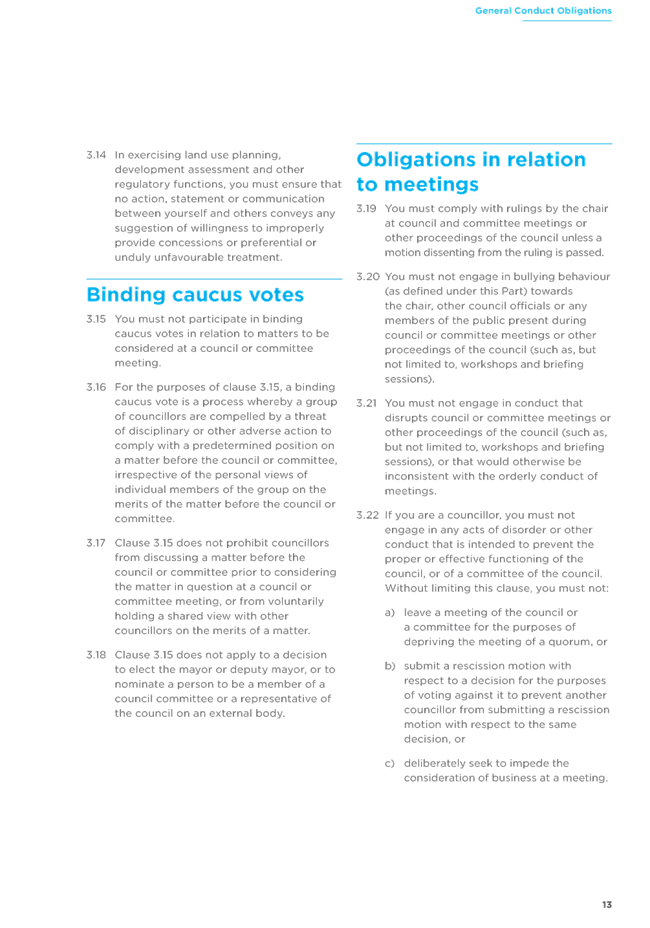

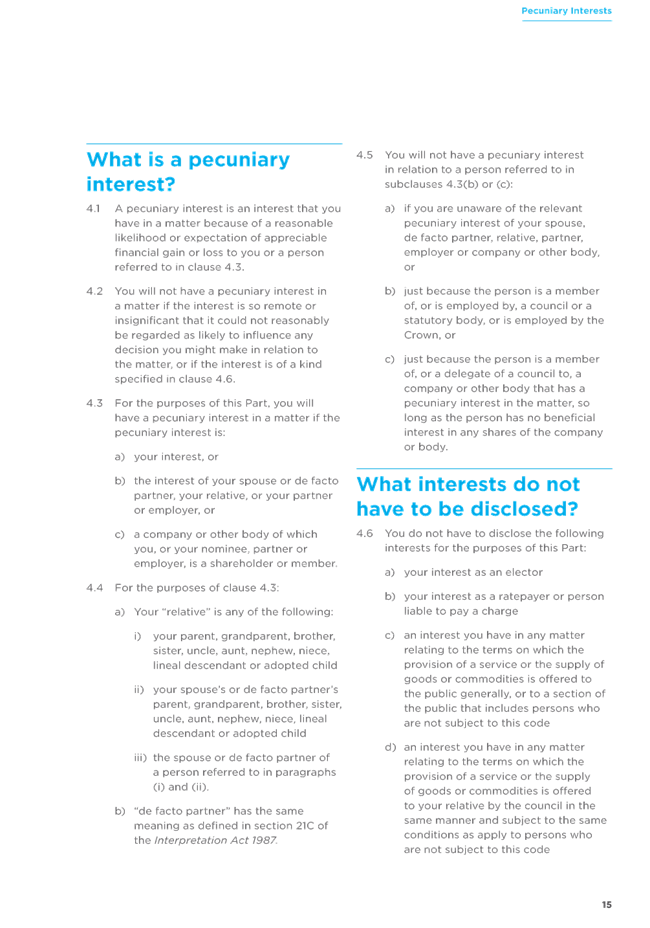
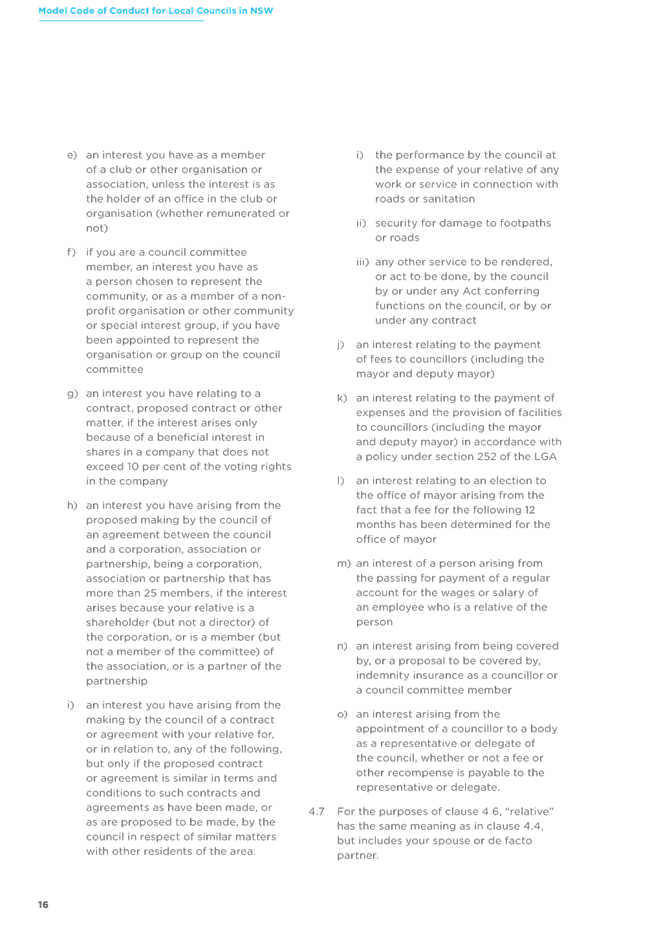
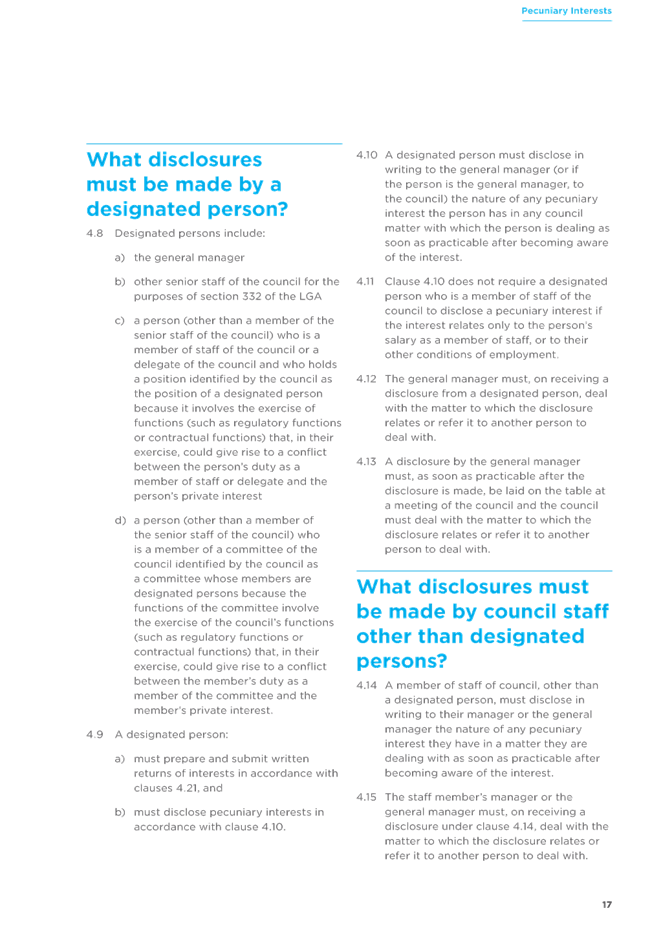
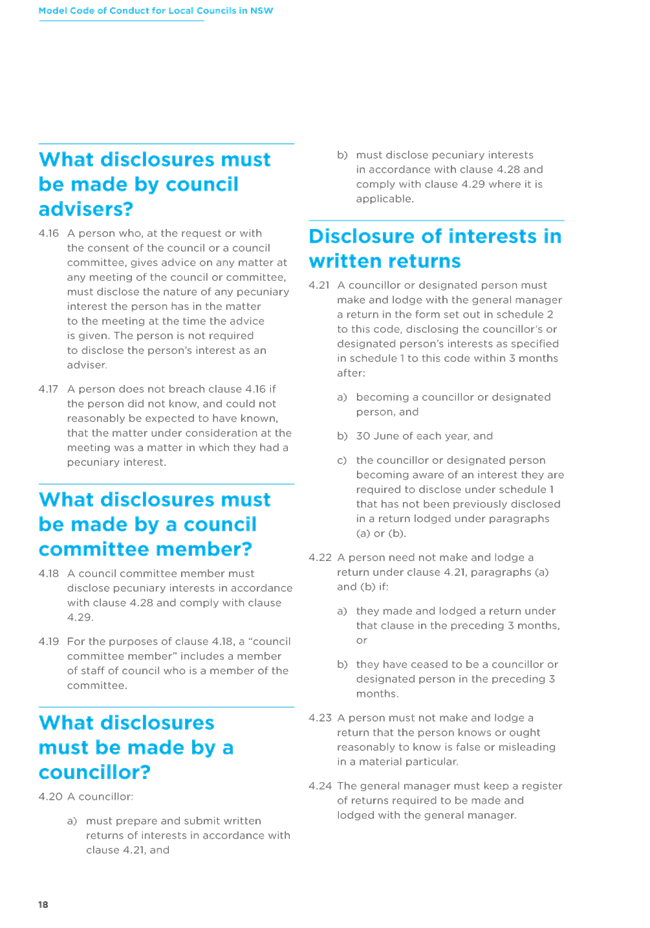
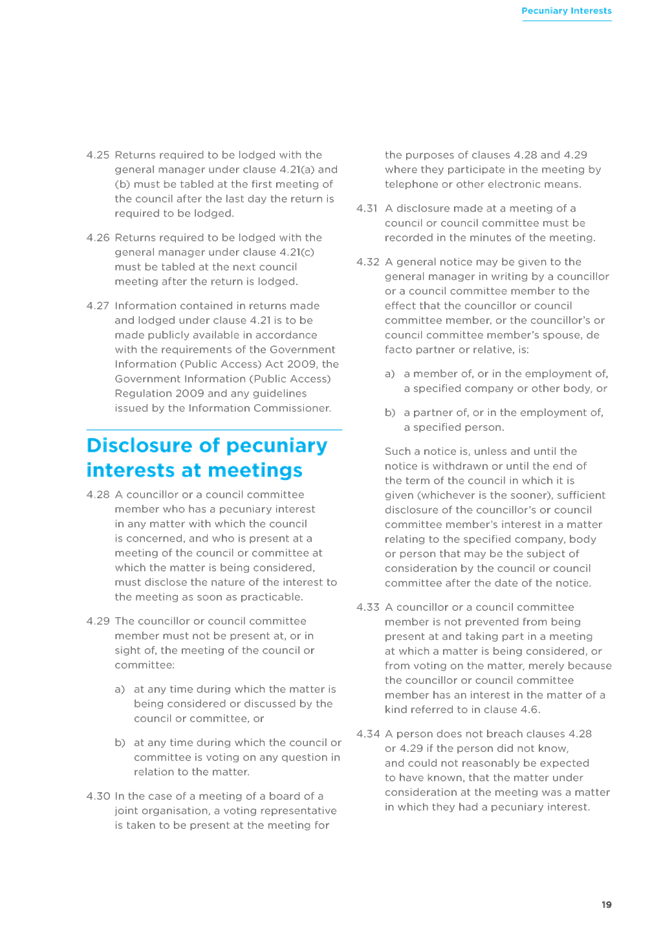
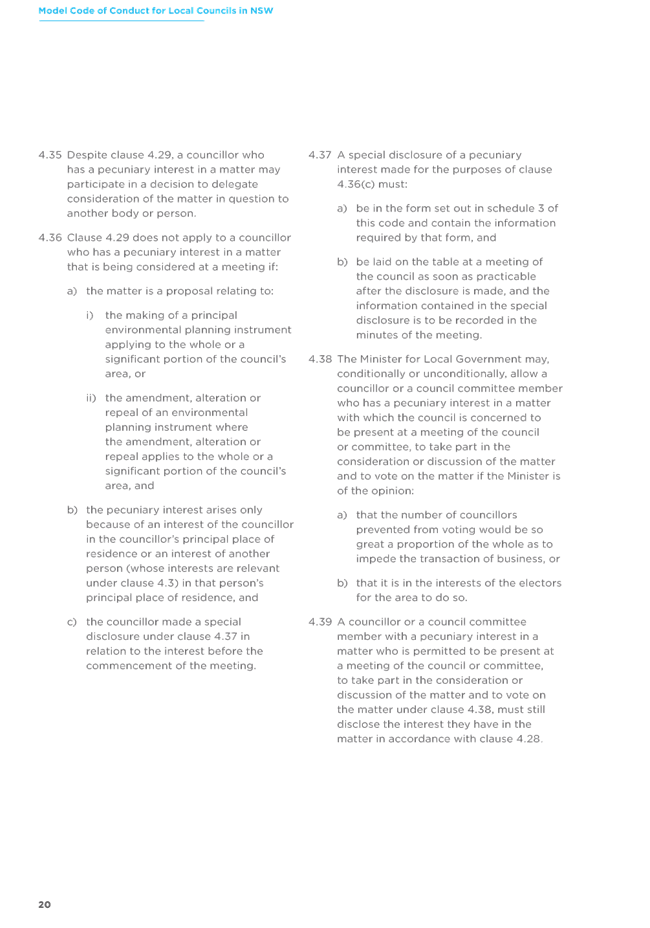




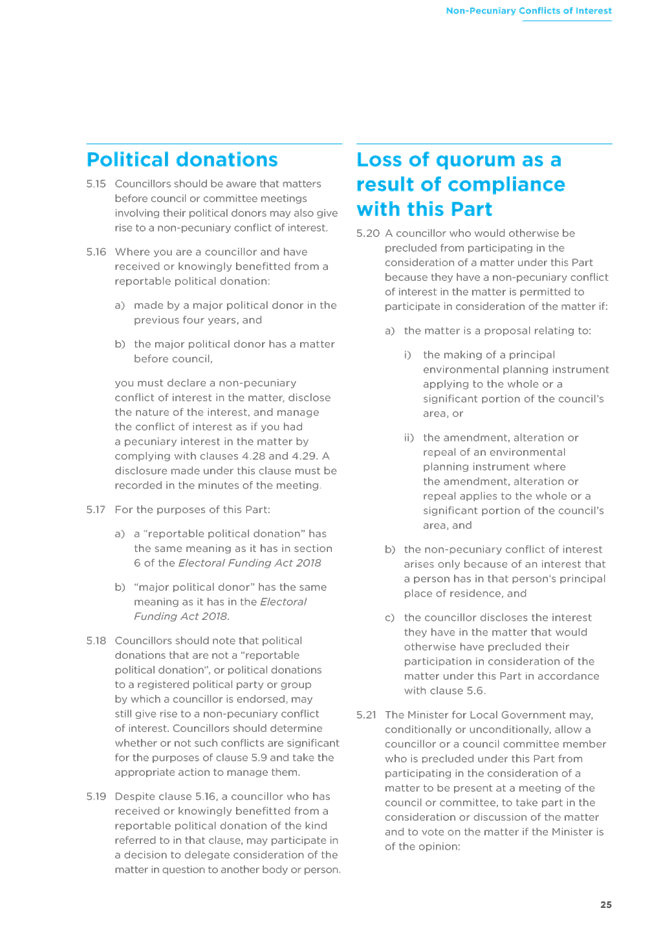
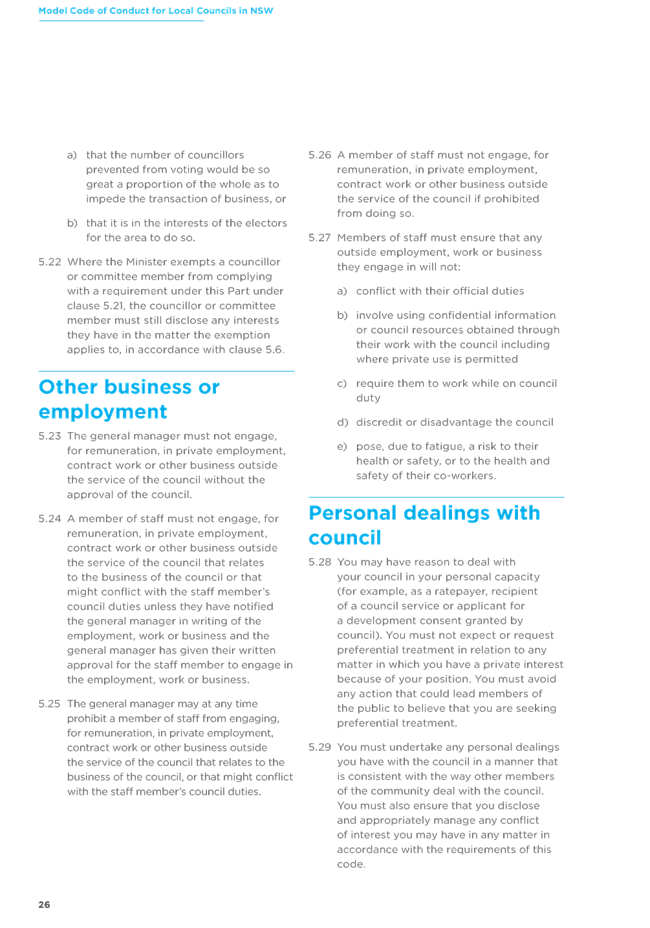



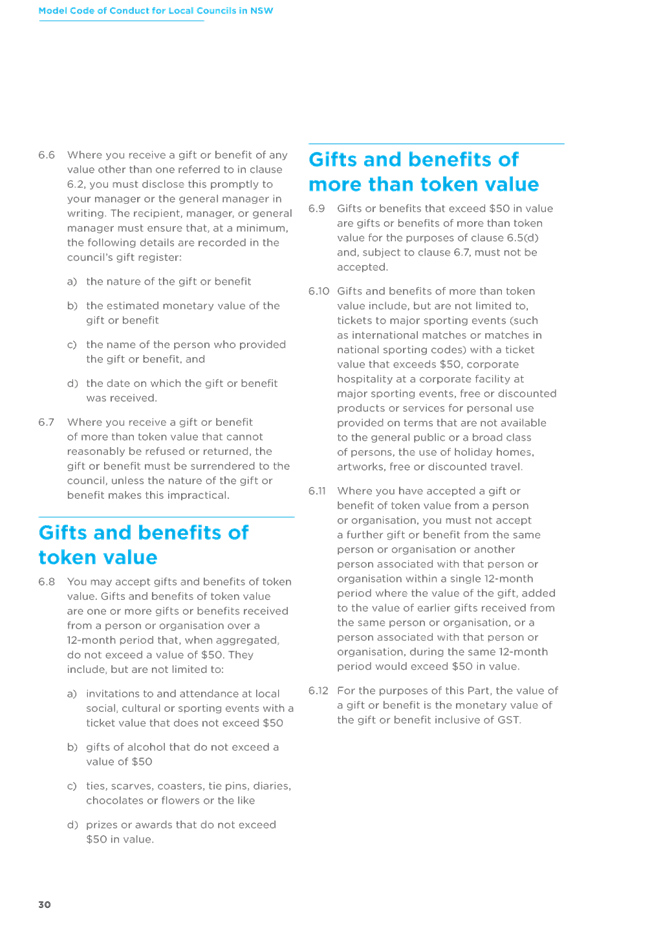
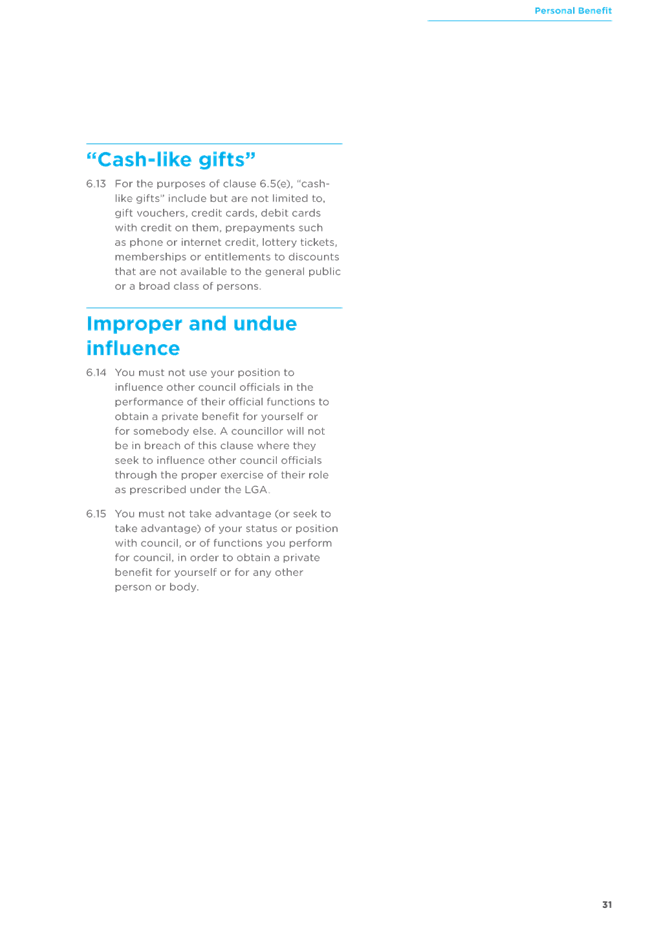

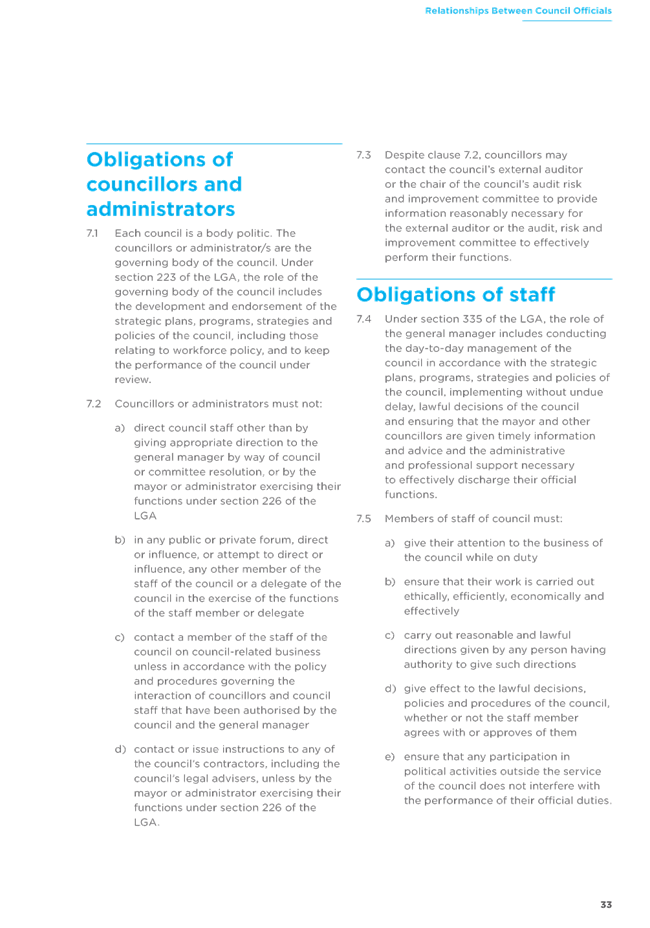



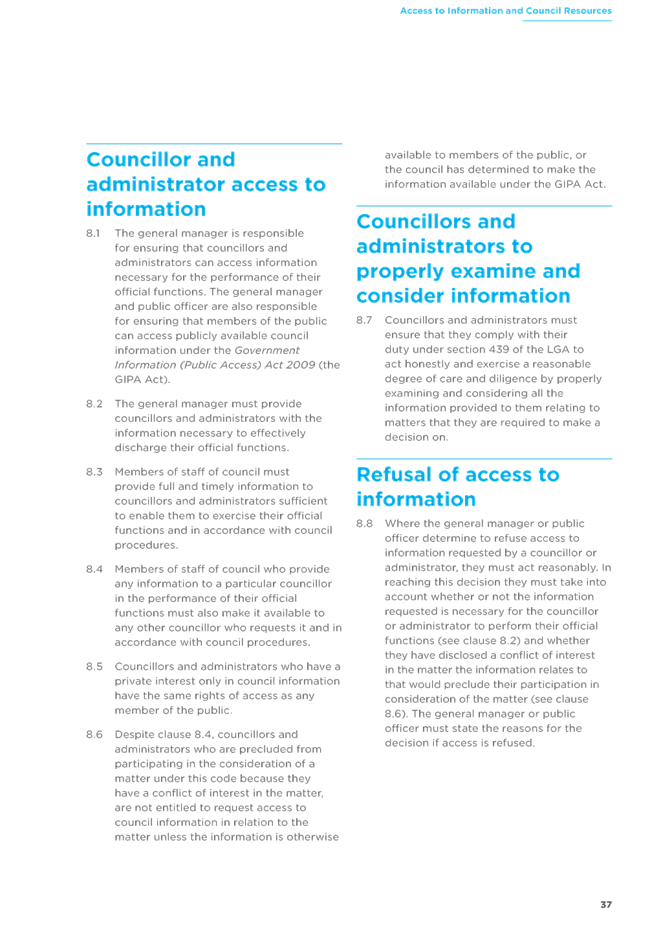
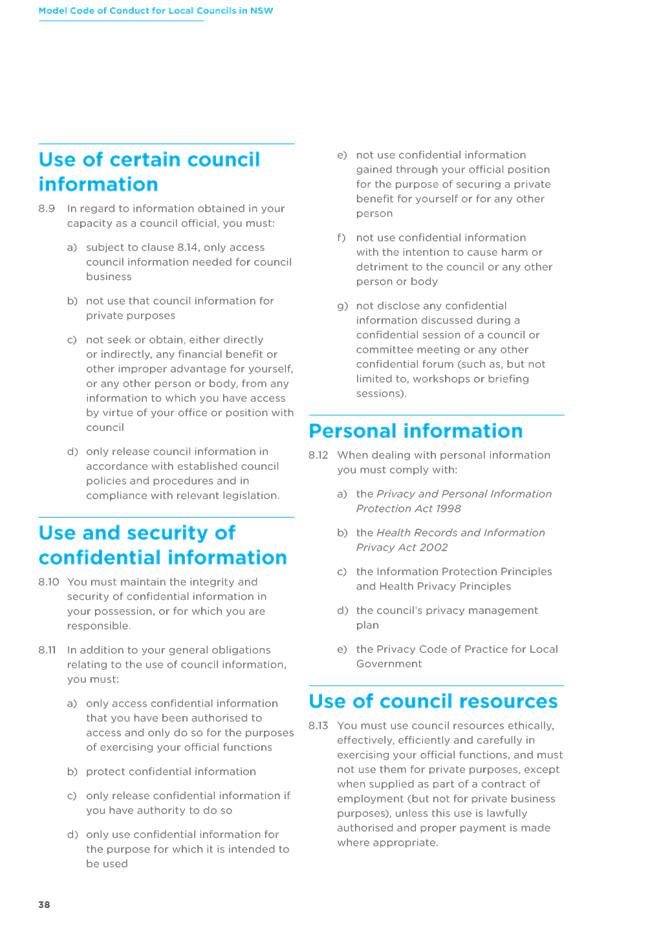
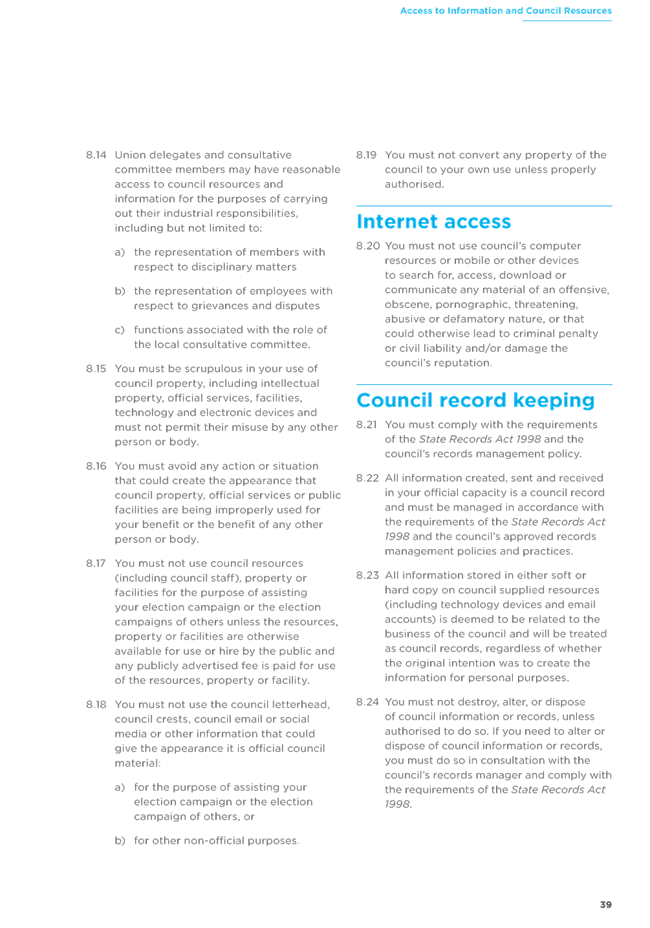



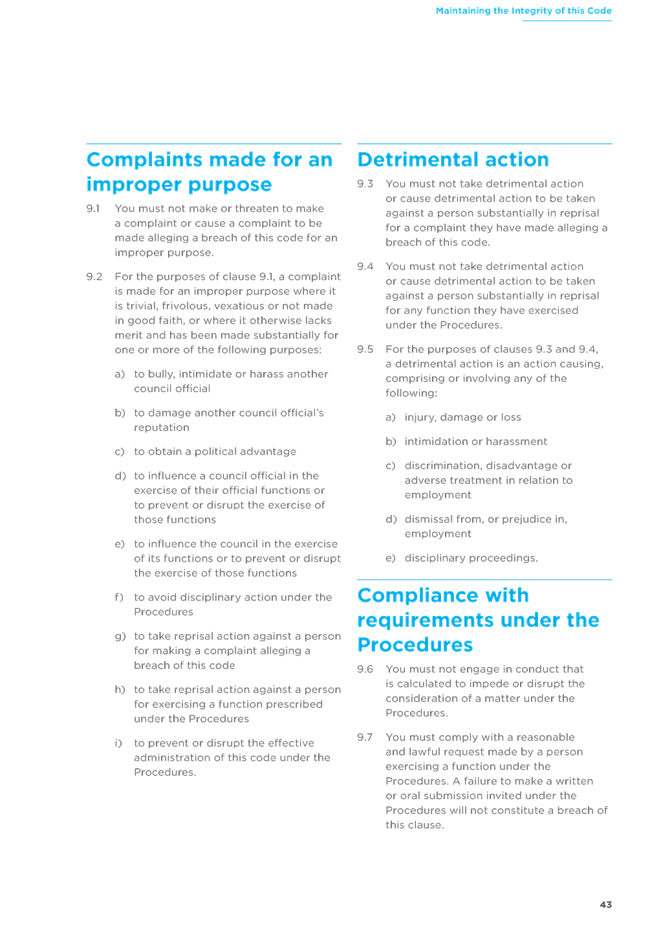
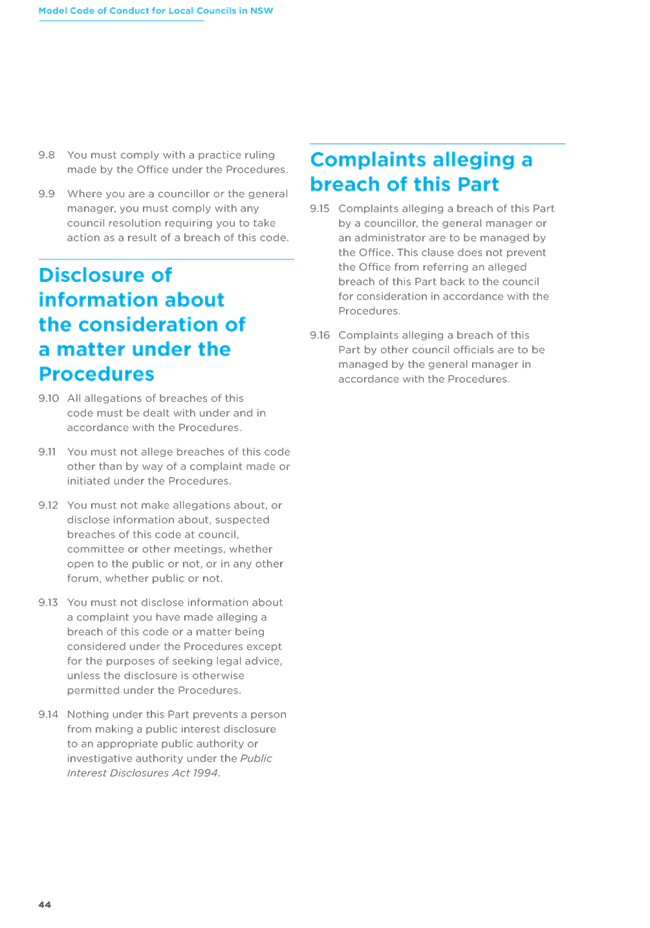

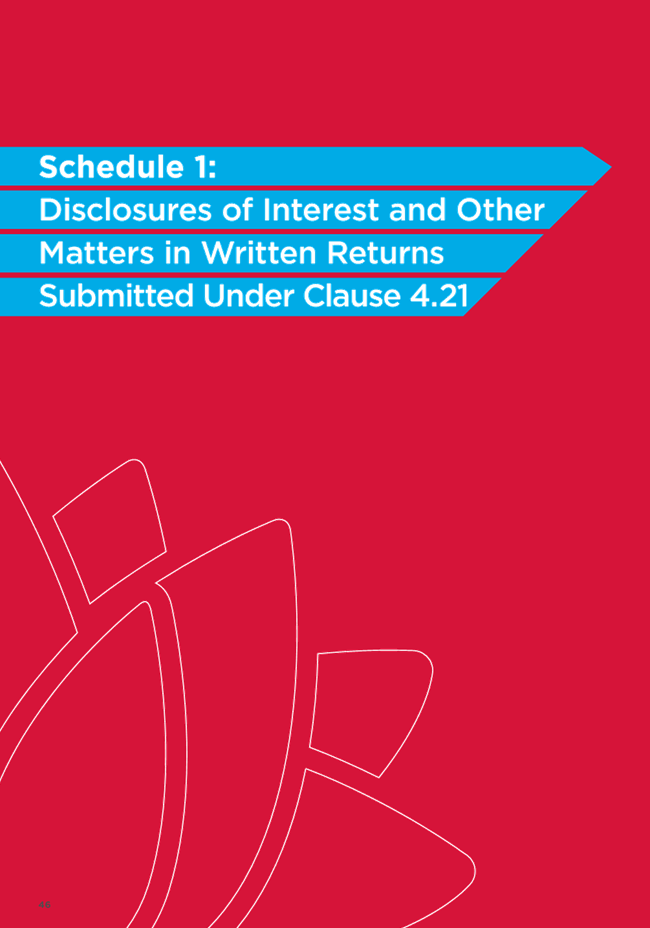
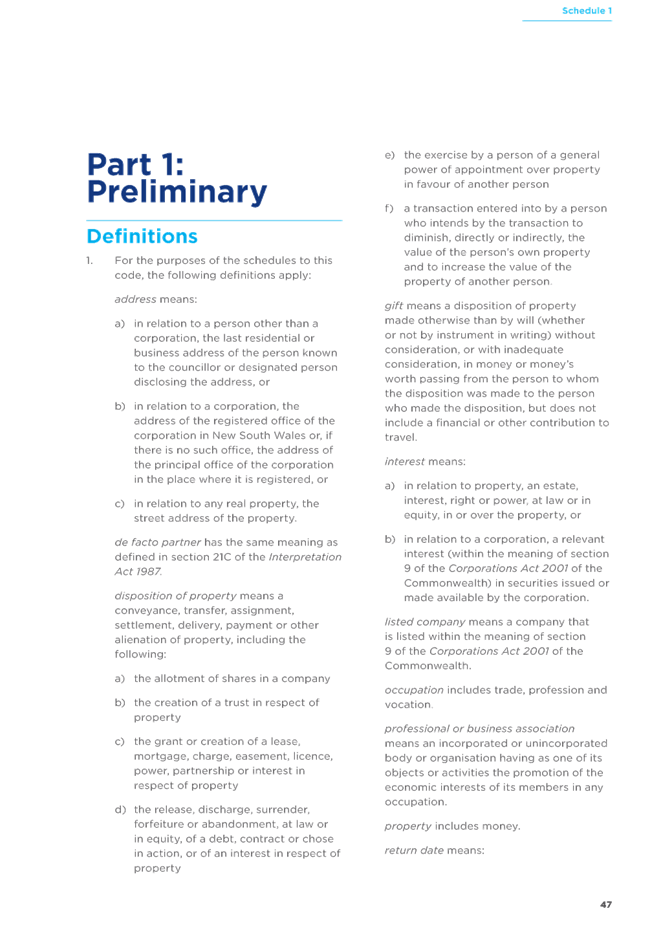
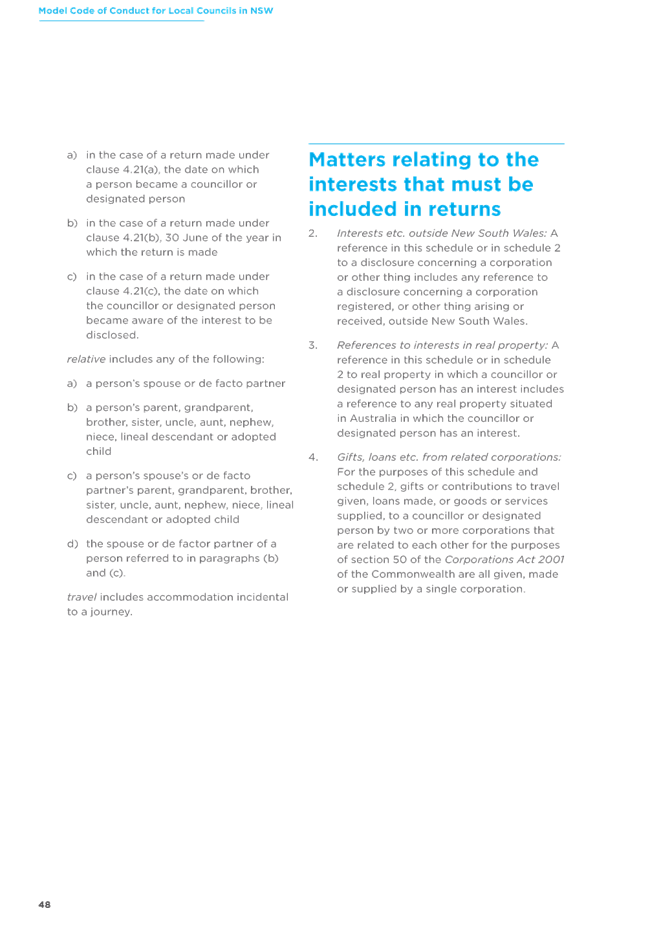
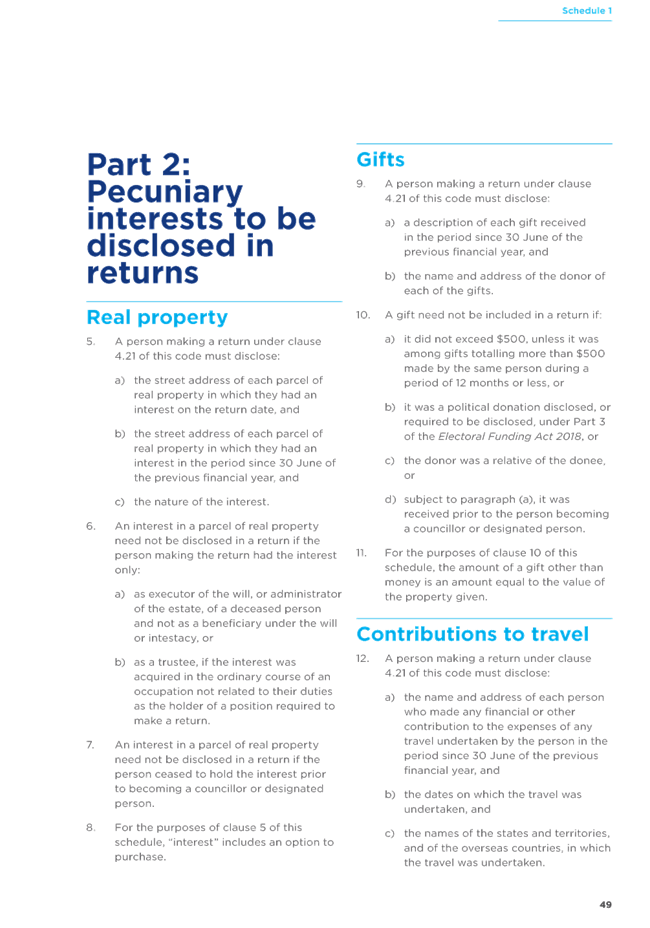
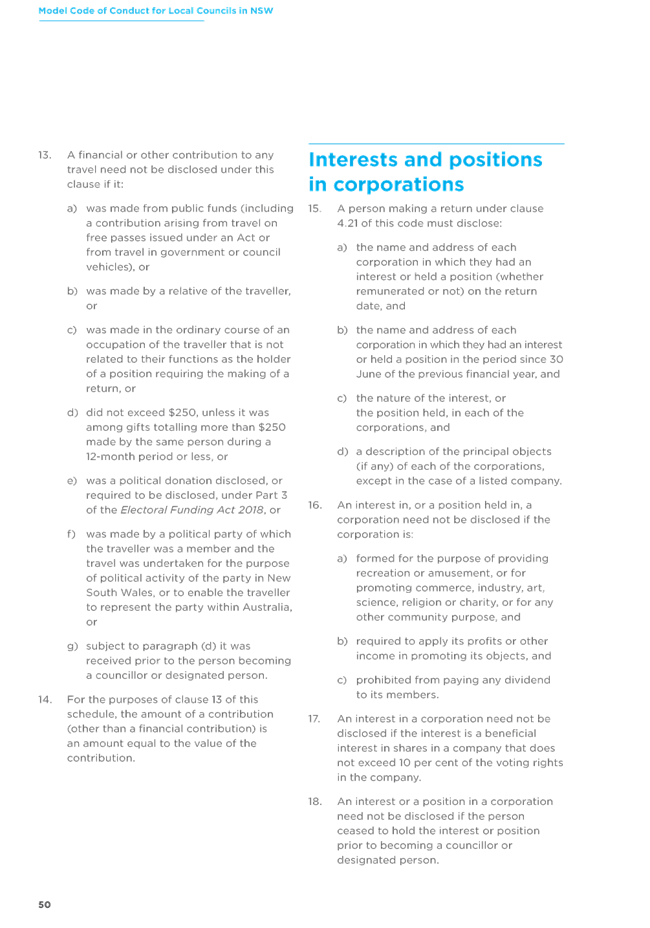
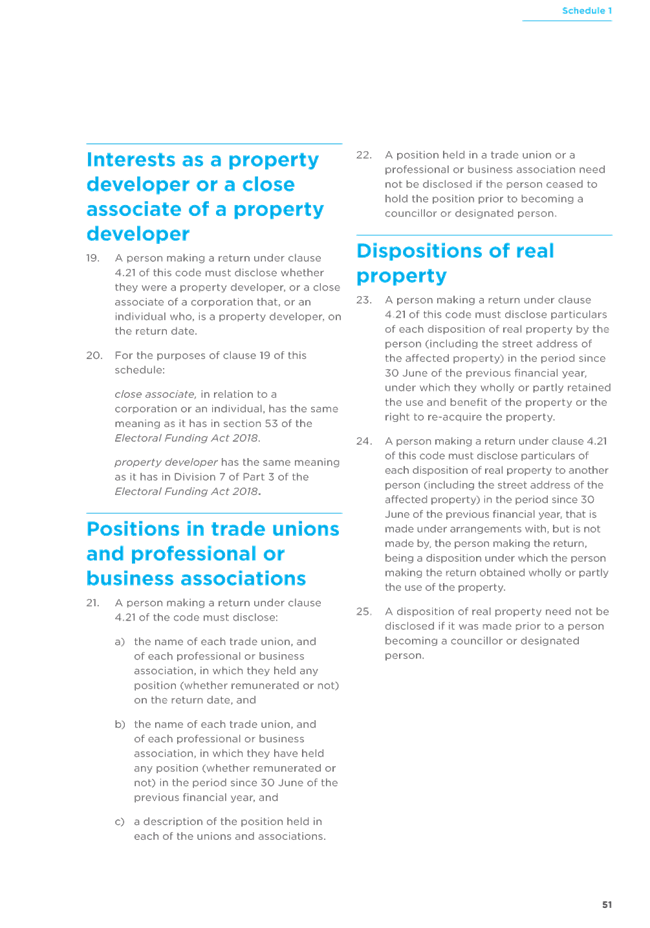
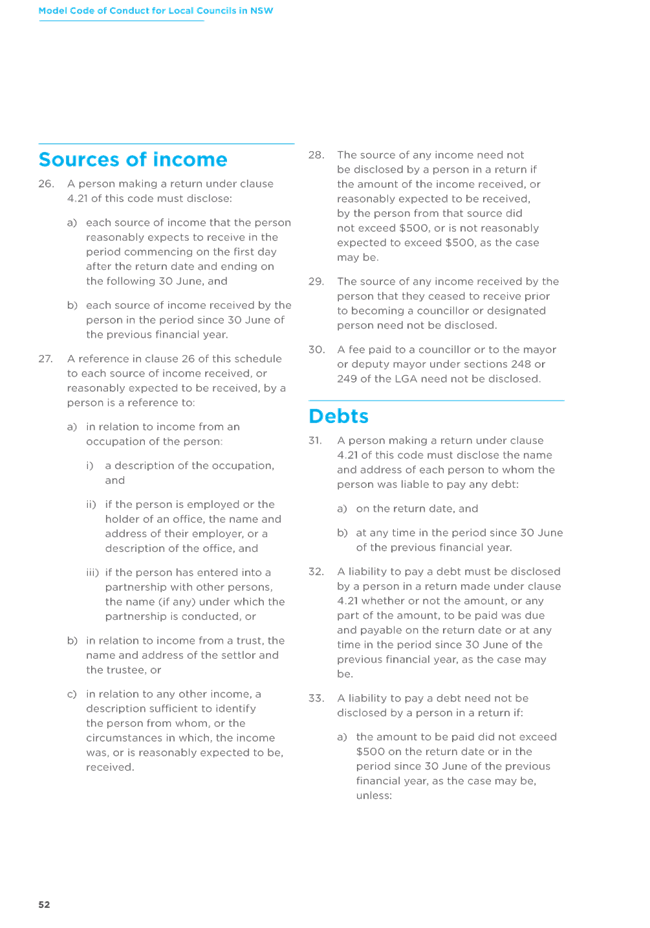
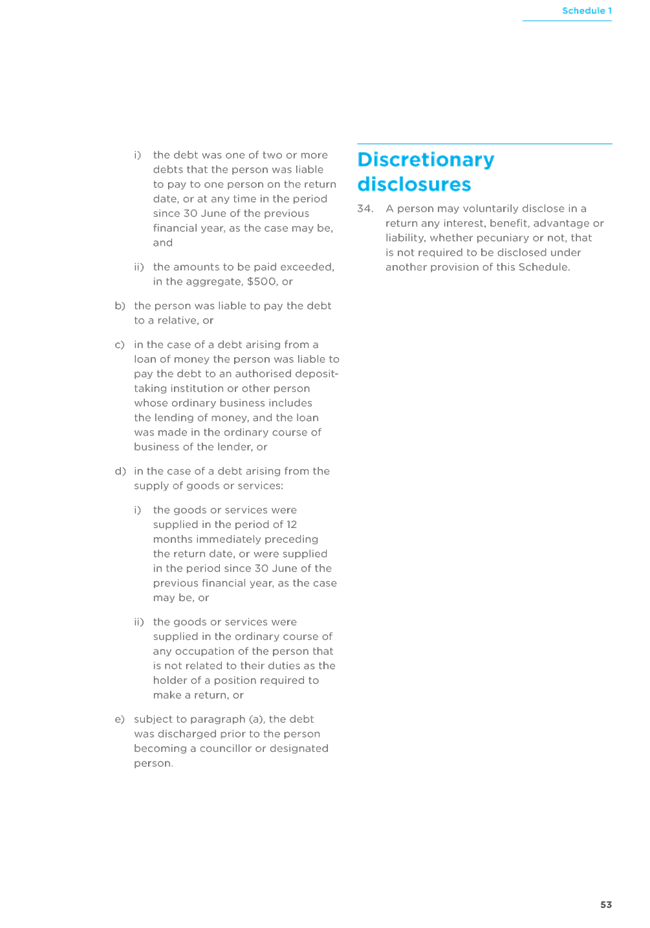
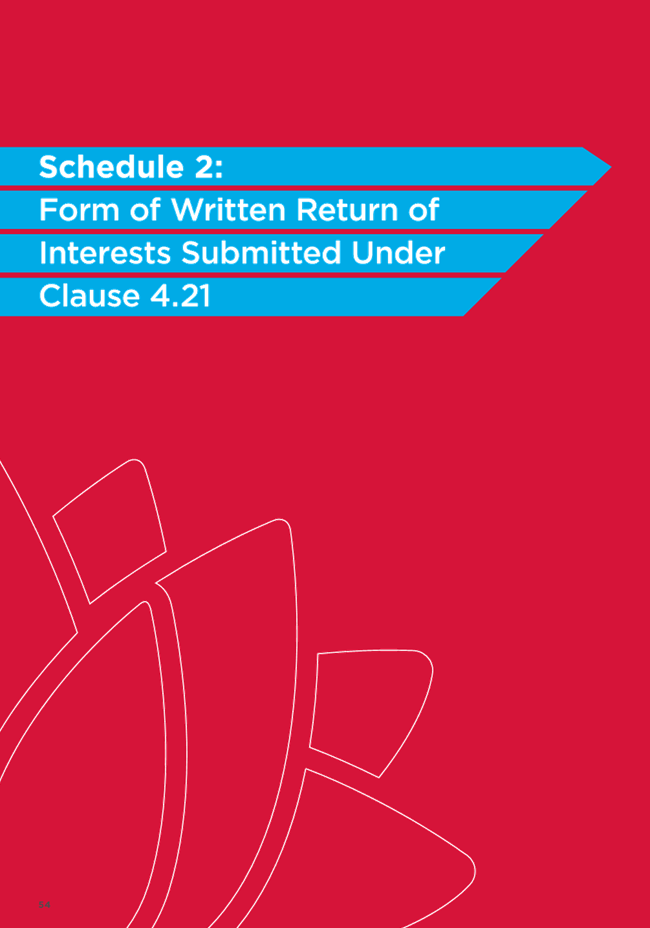
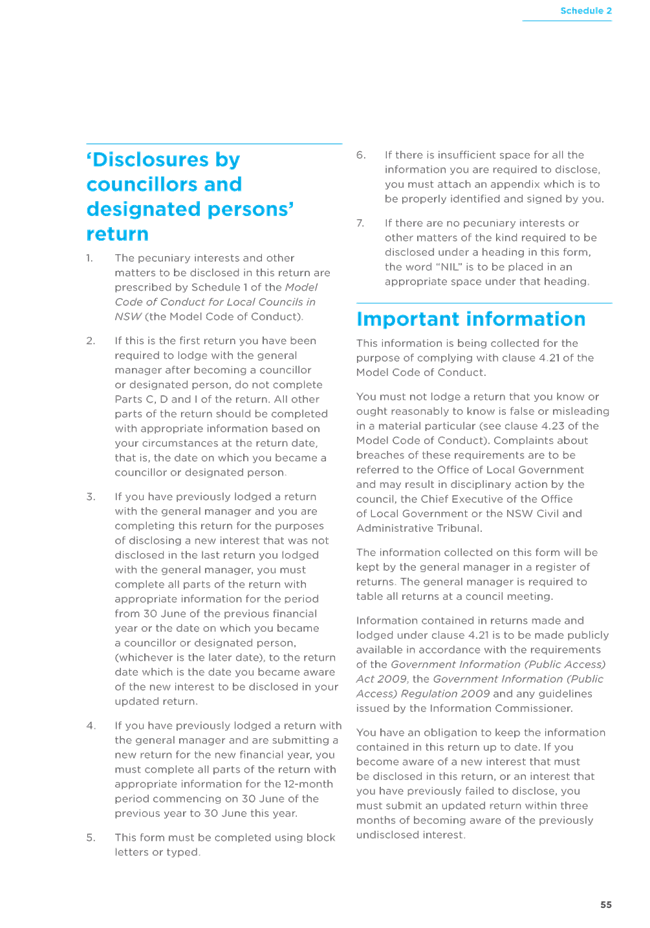
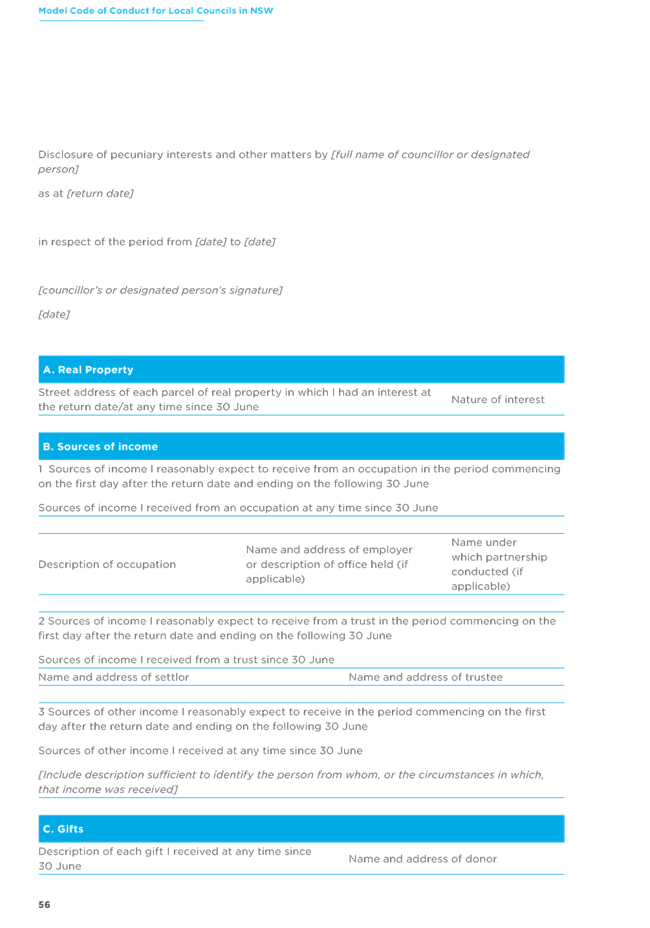
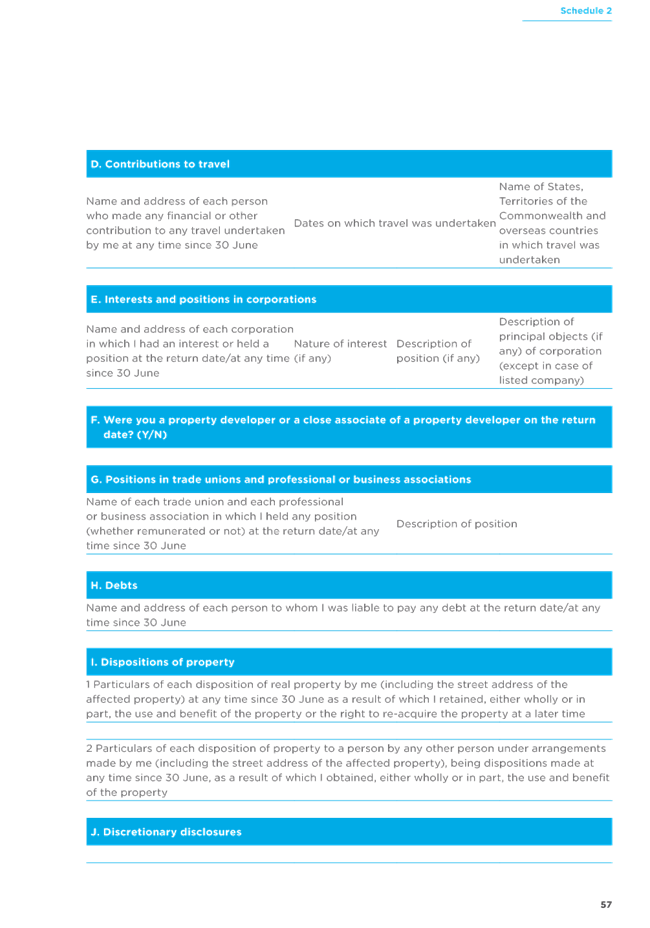
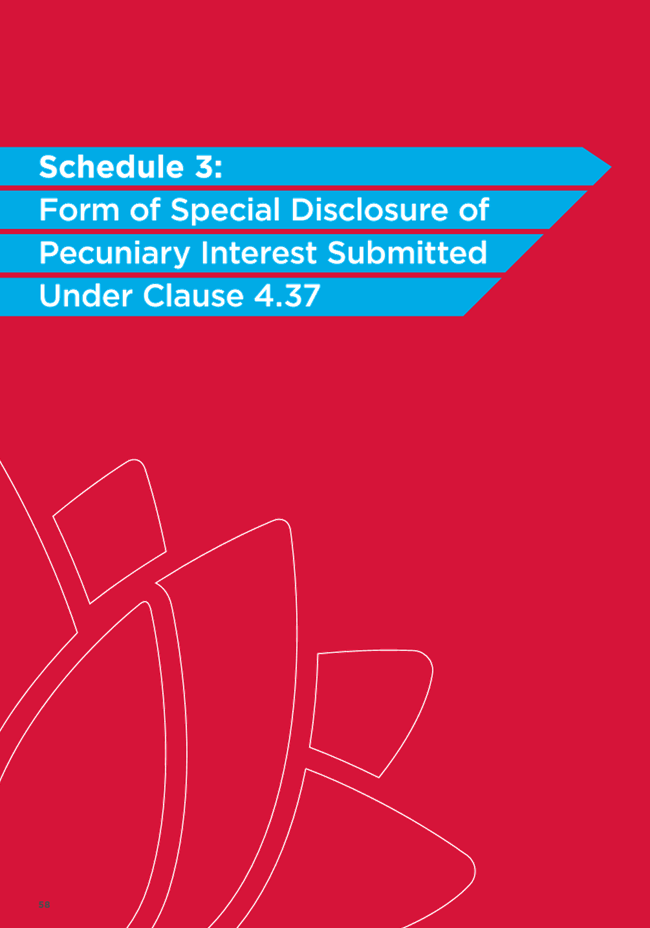
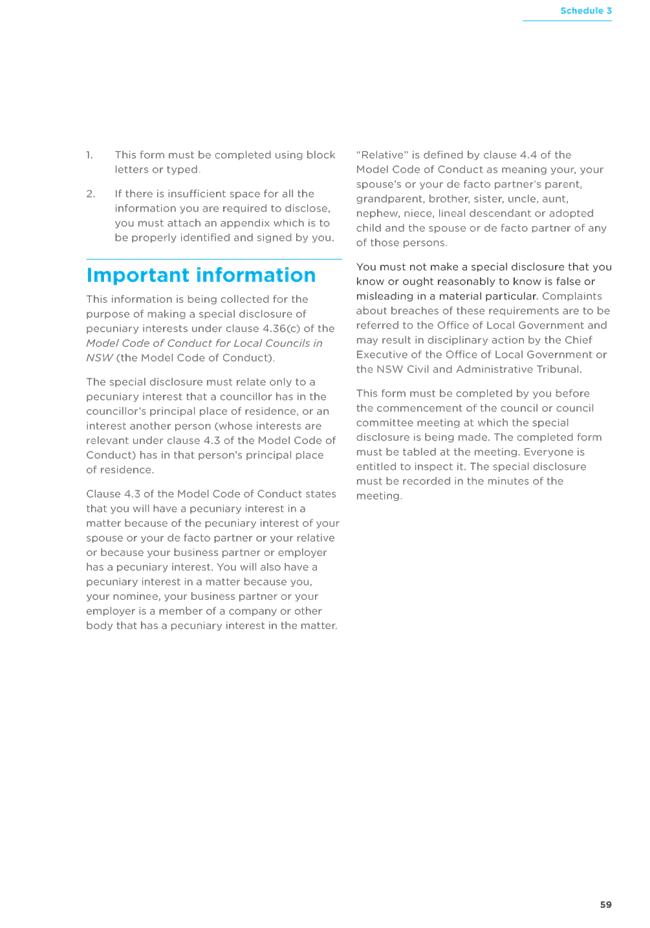
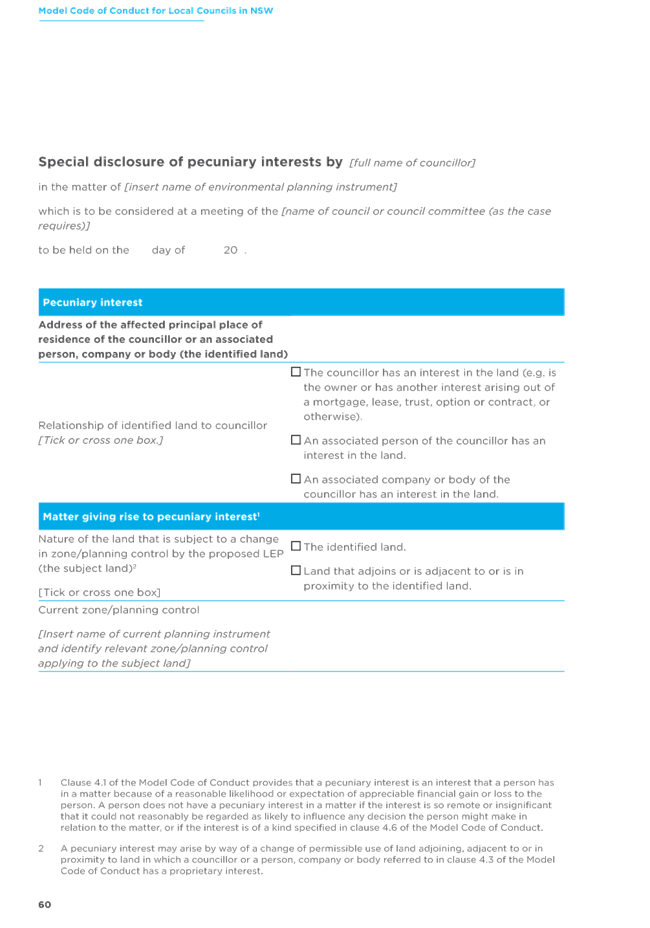
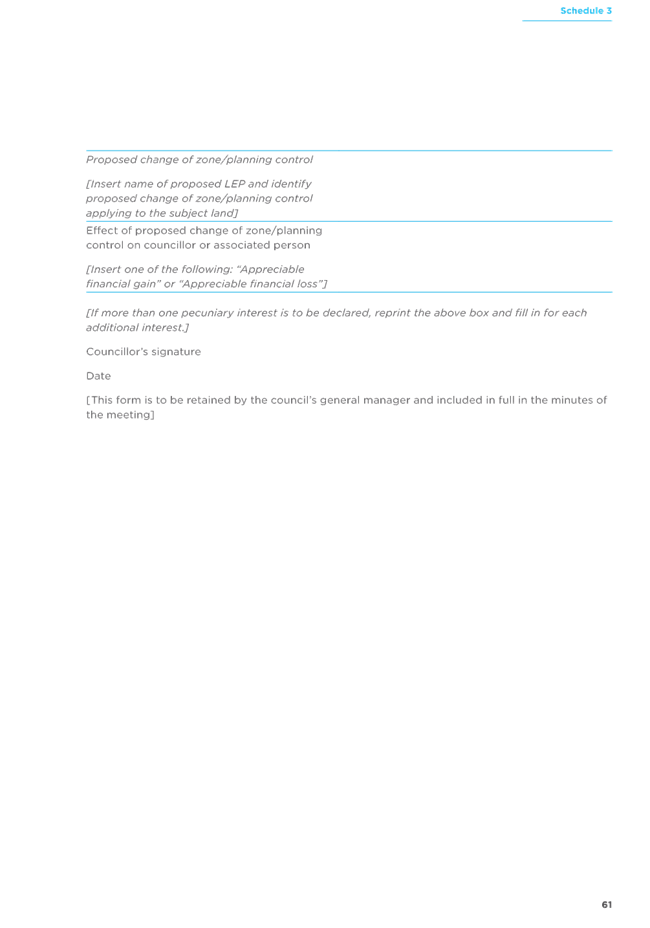

Attachment d Model Code of Conduct Procedures

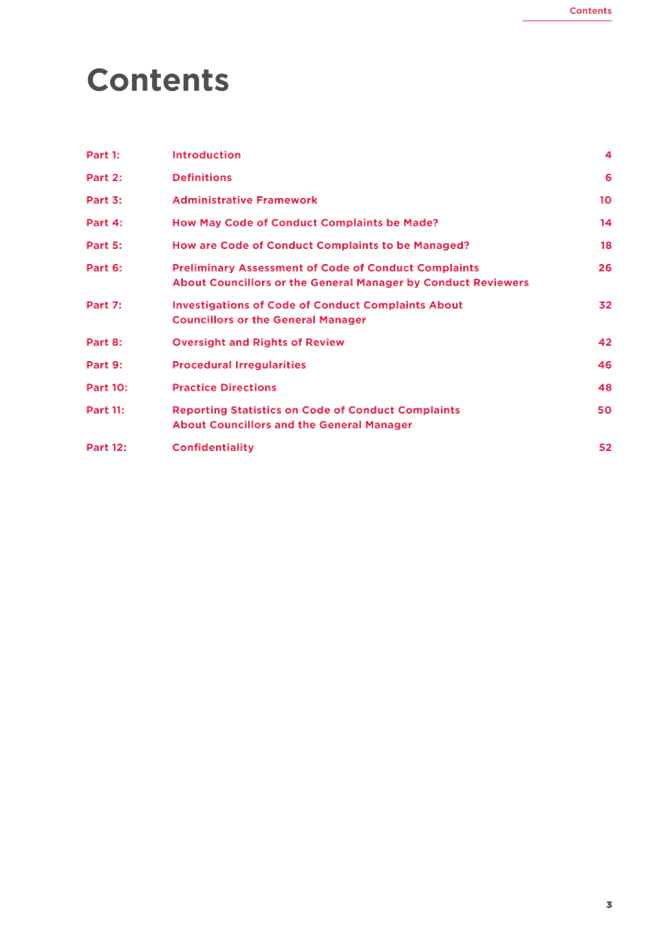

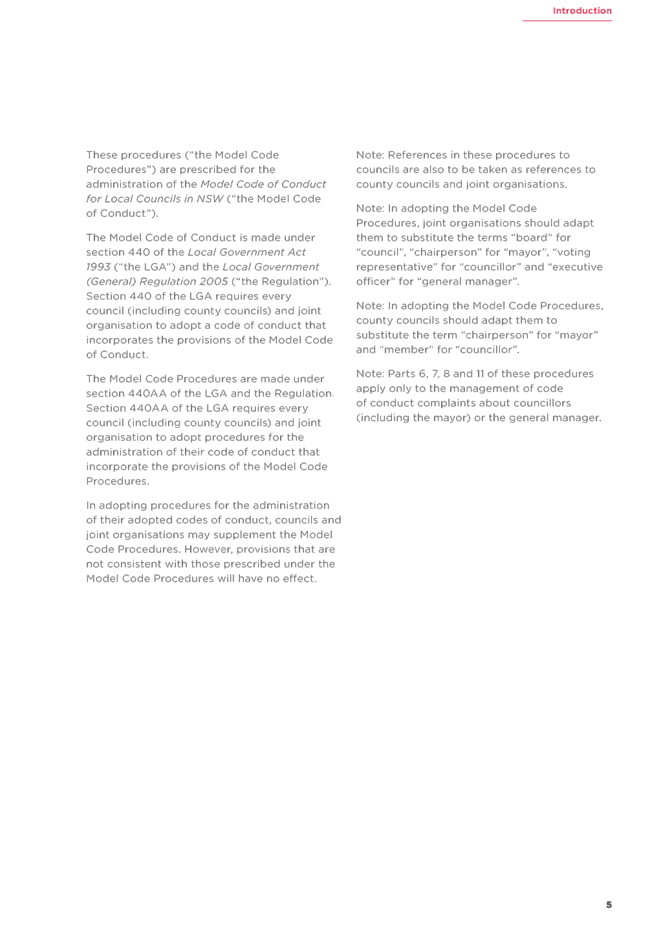

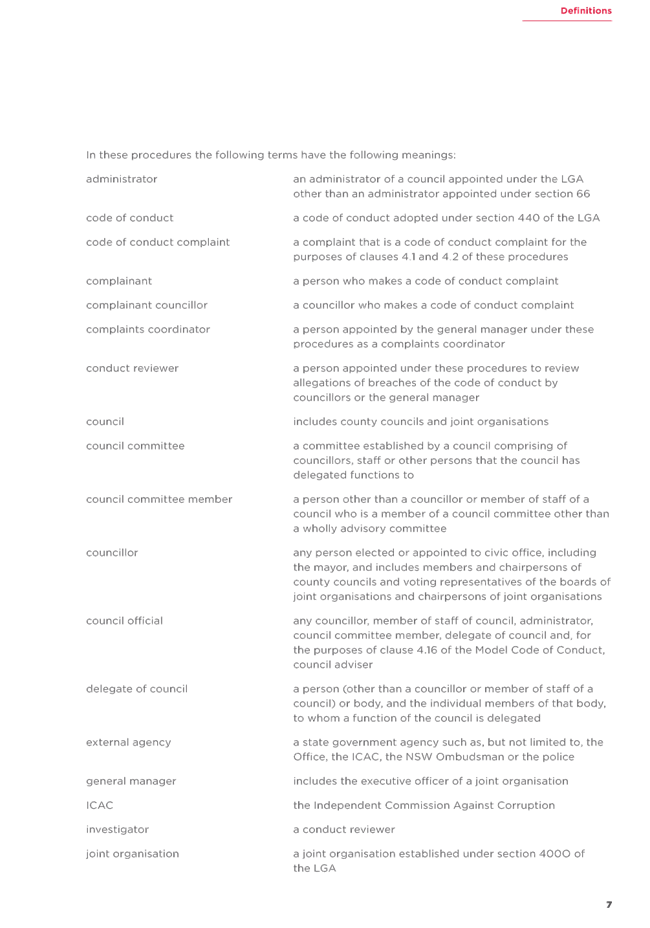



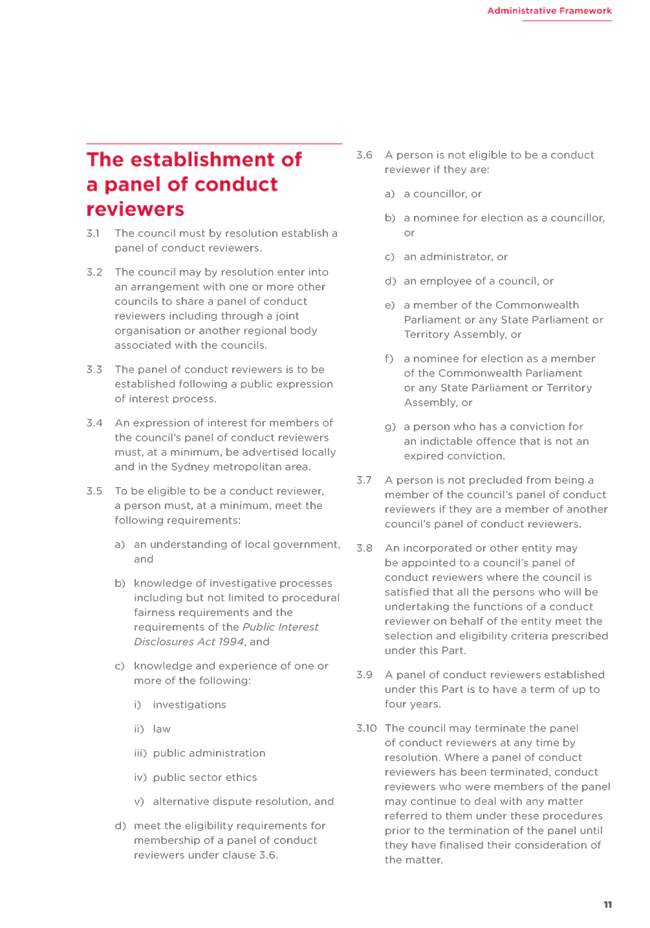
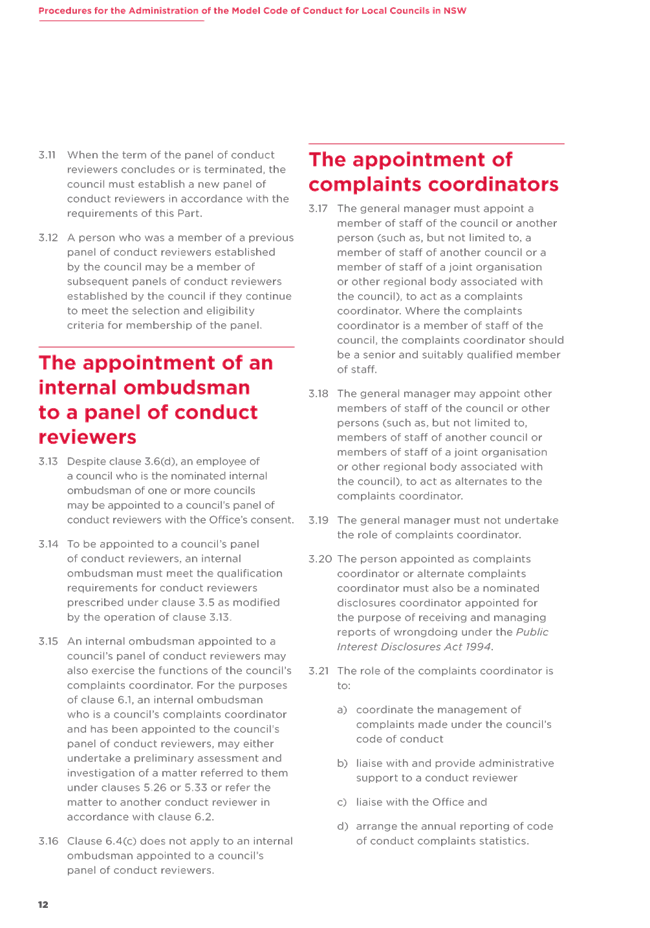


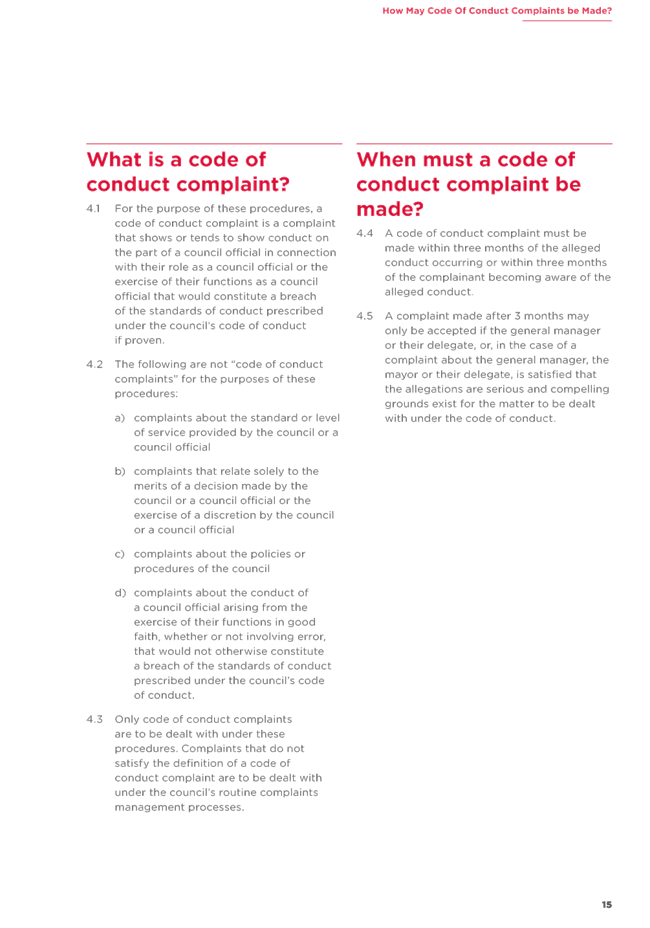
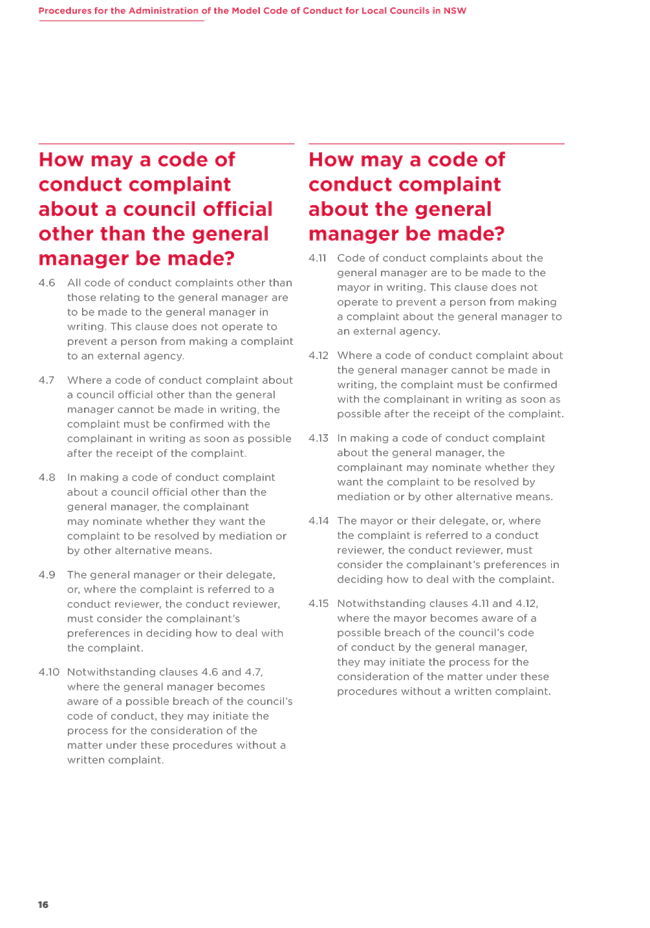


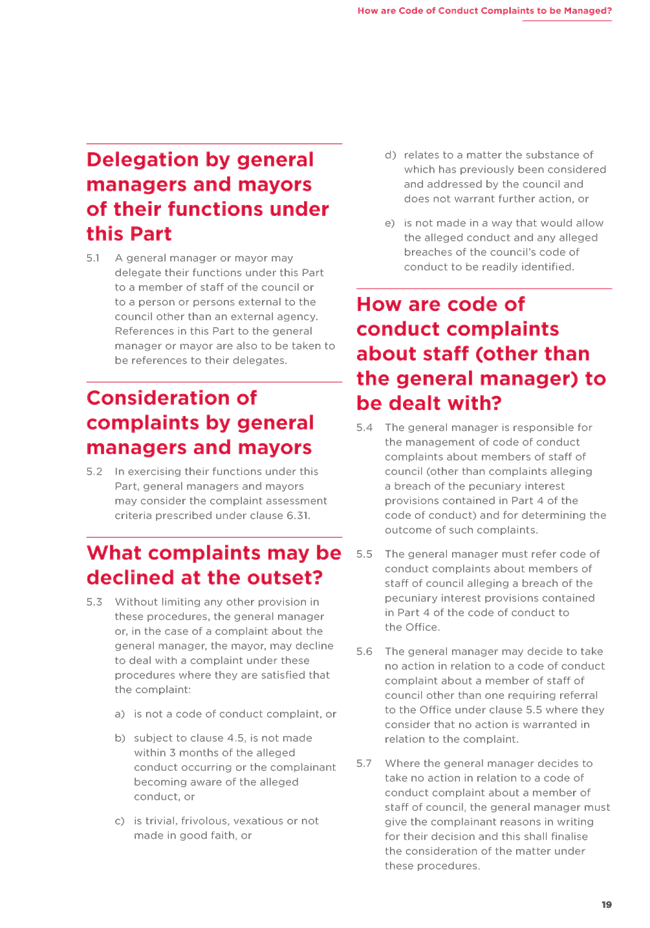
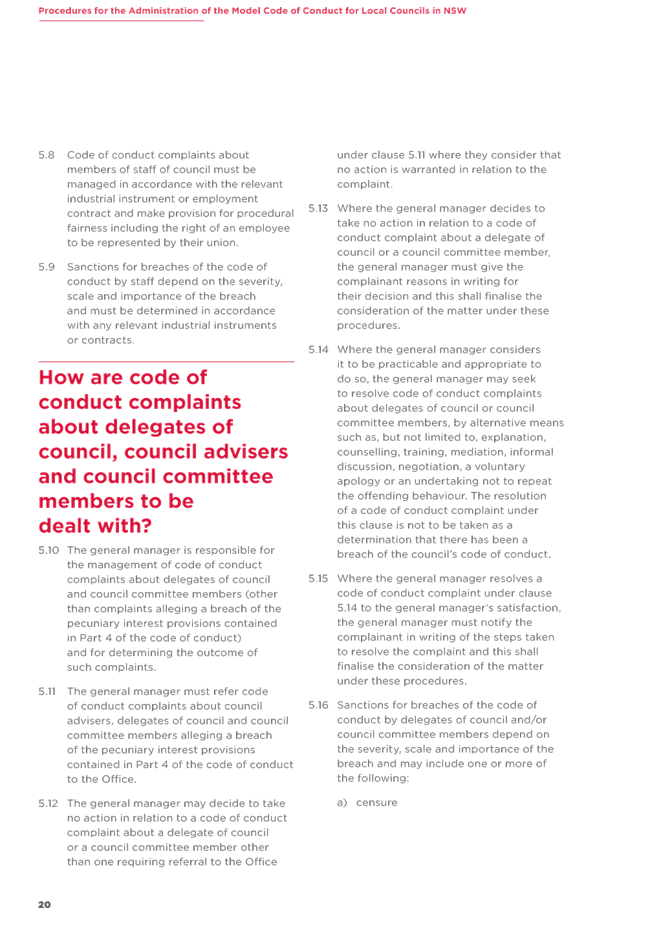
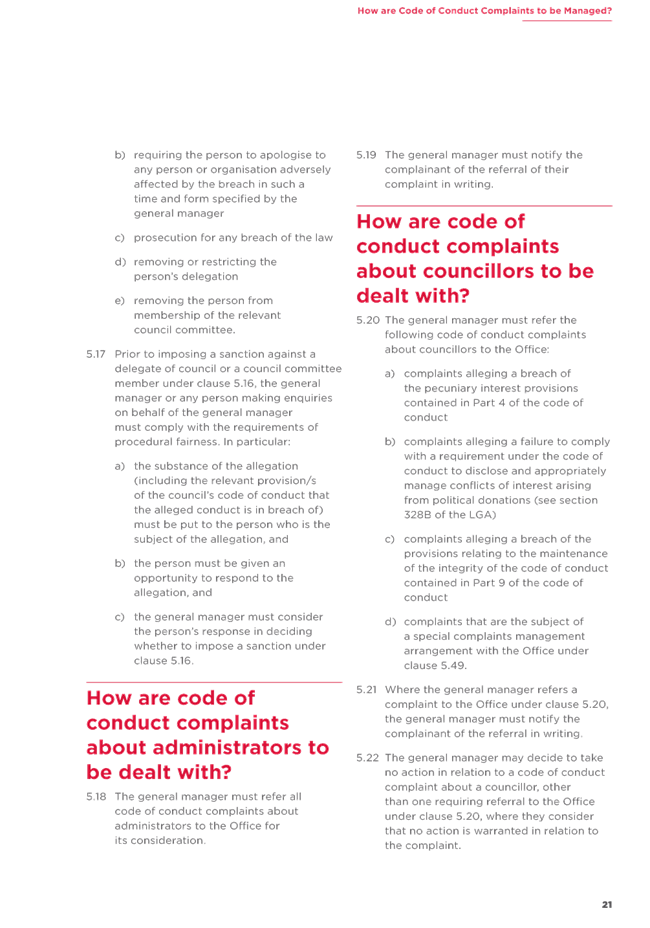
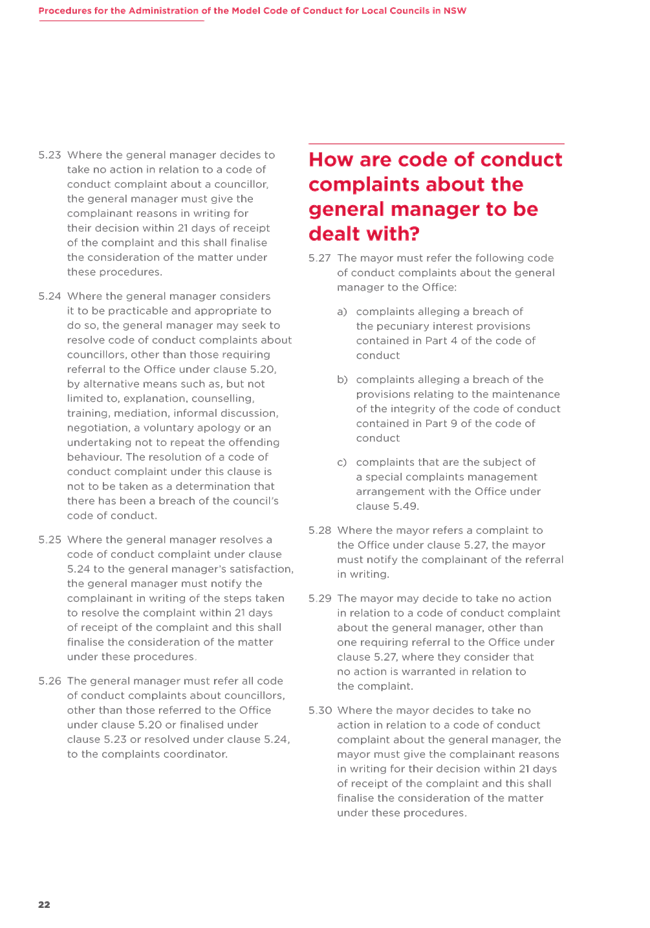
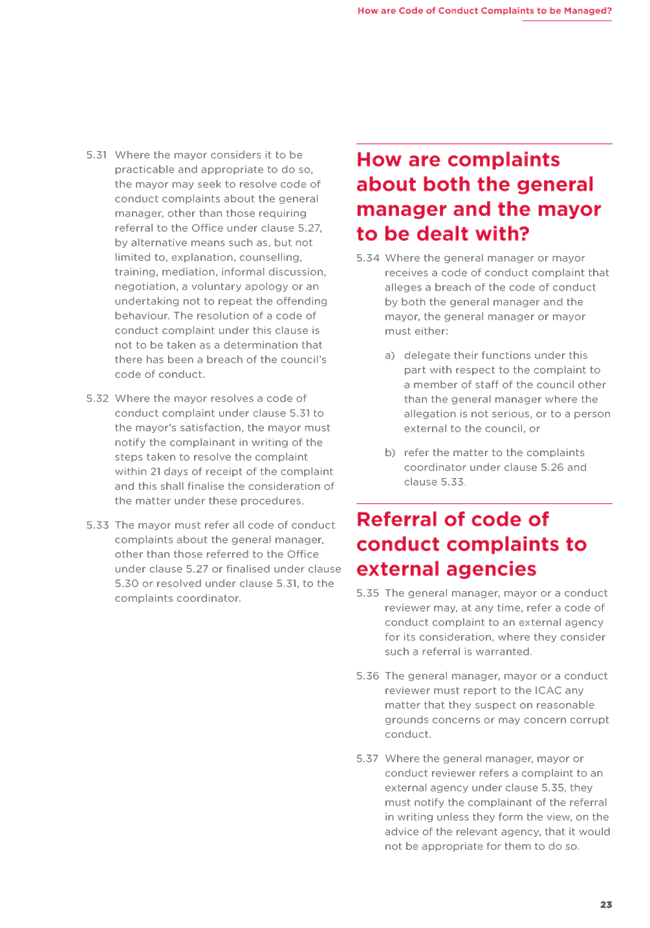
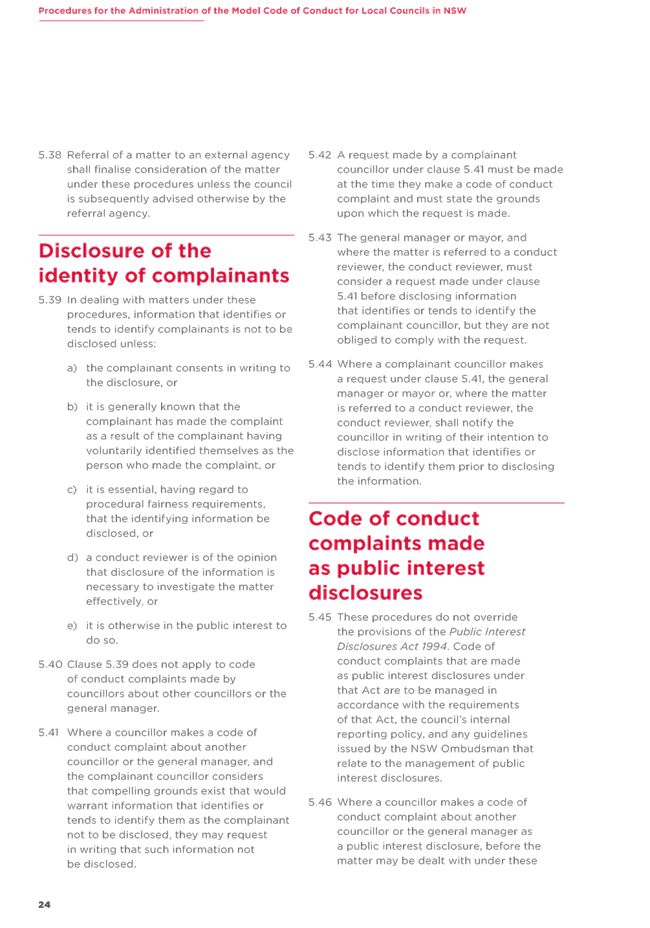
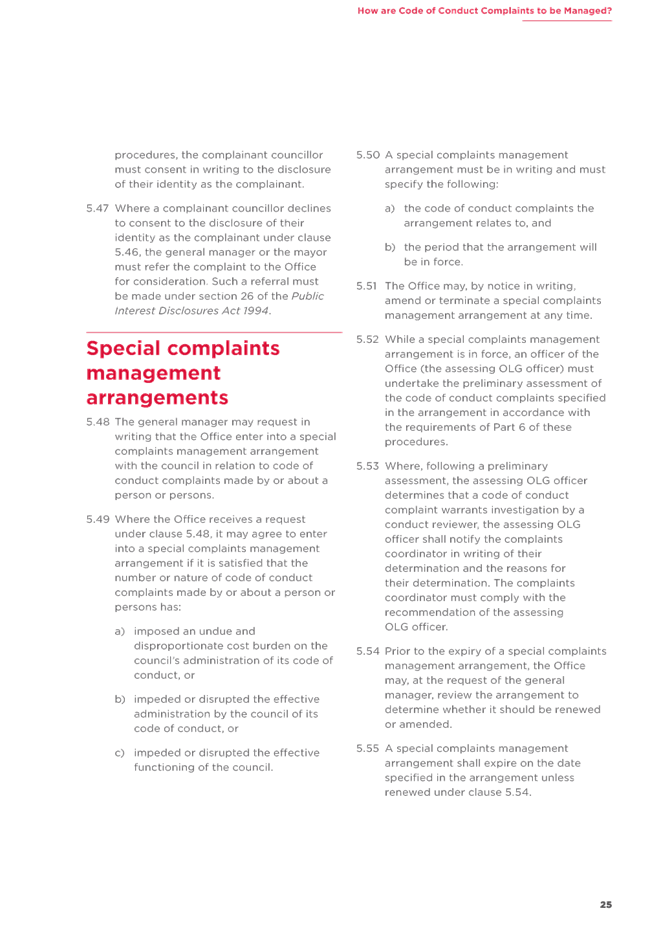
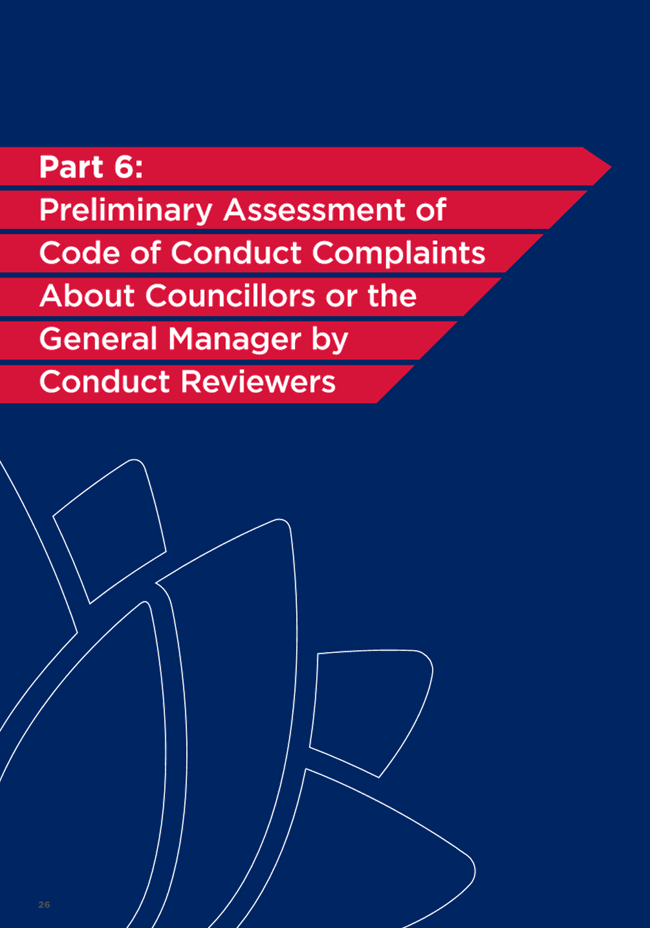
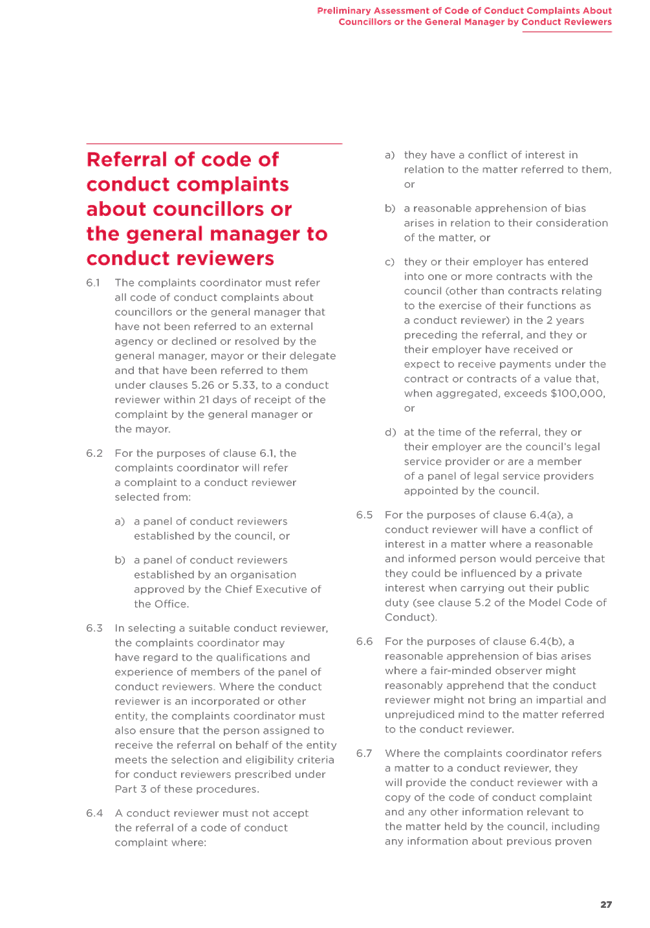
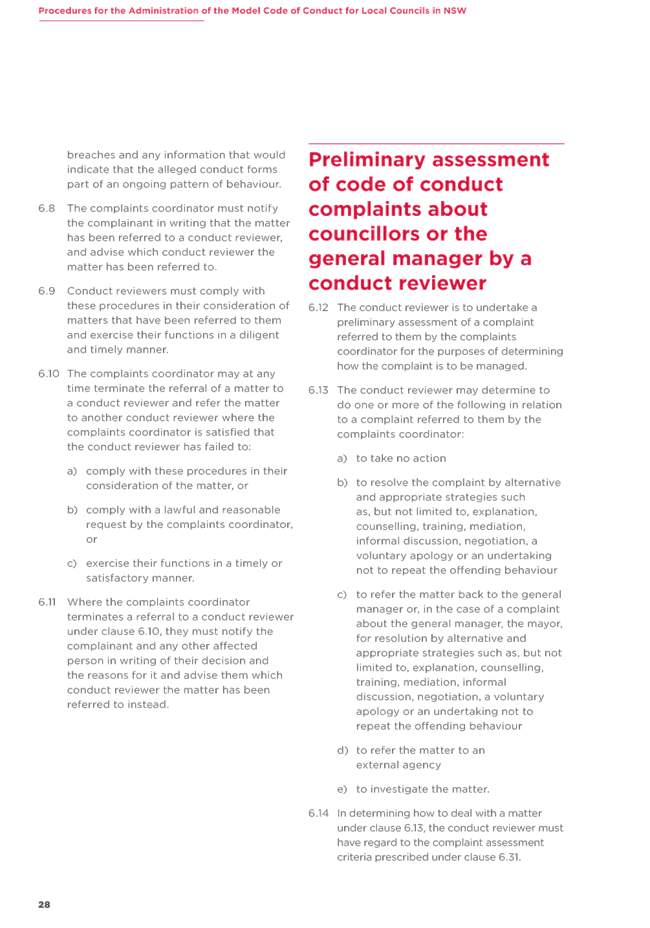
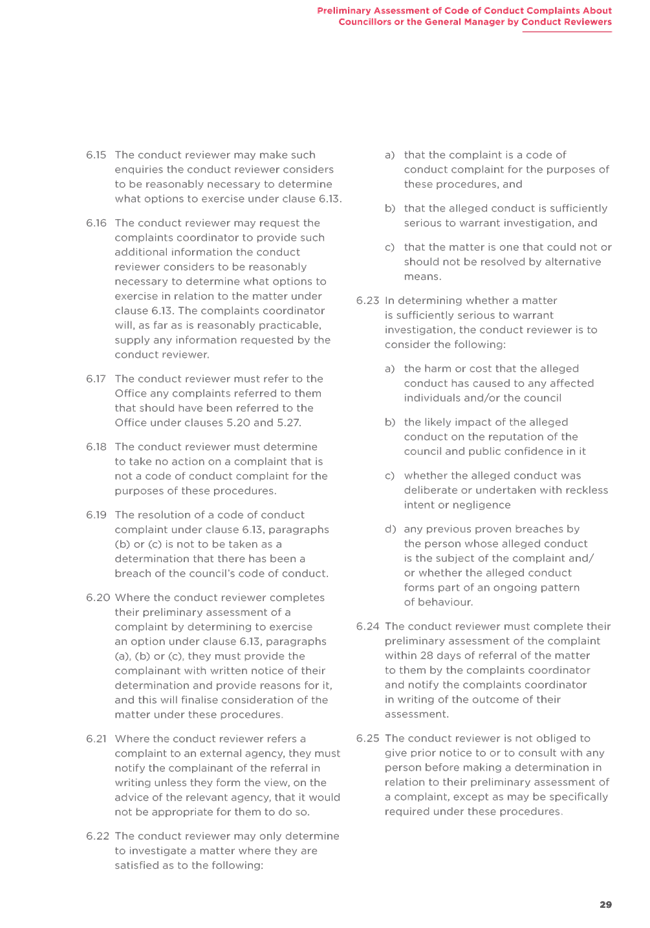
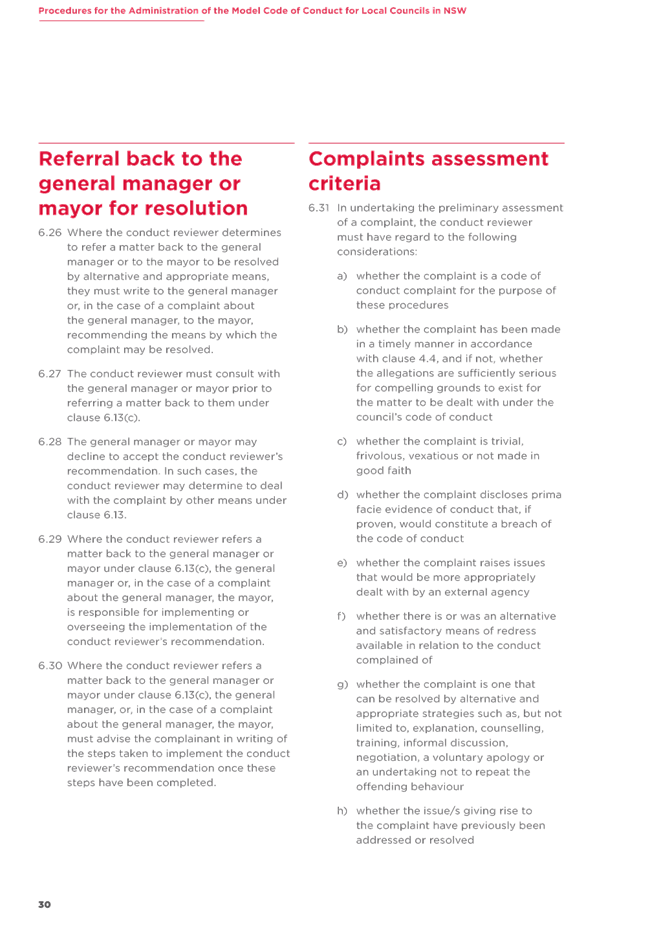
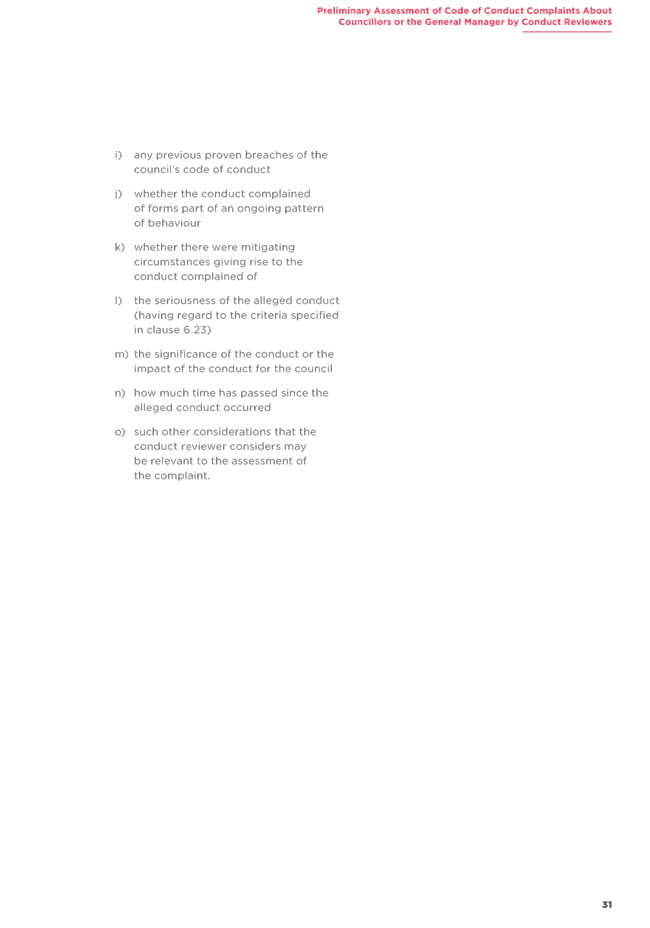
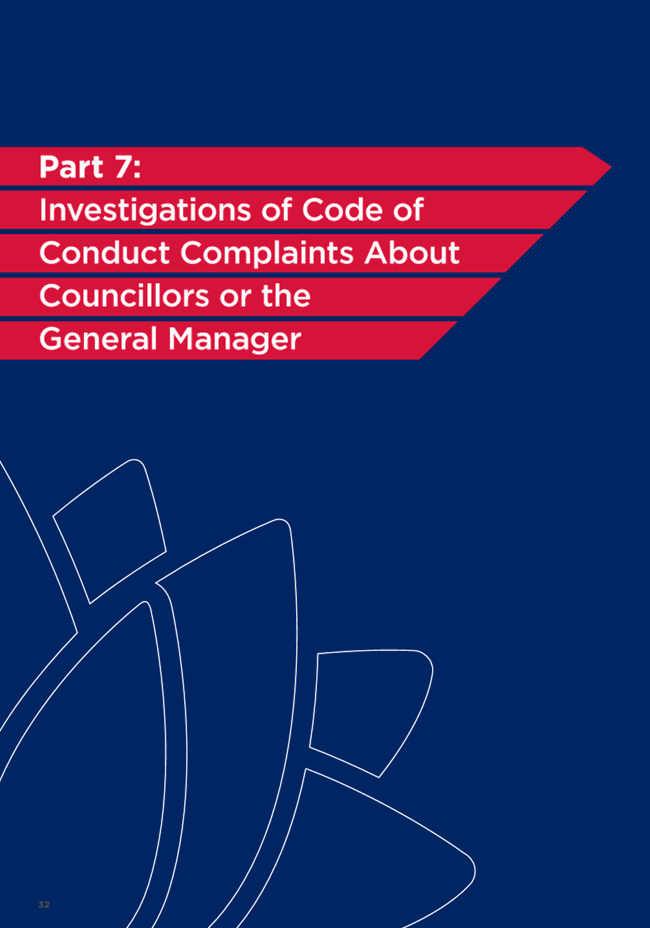

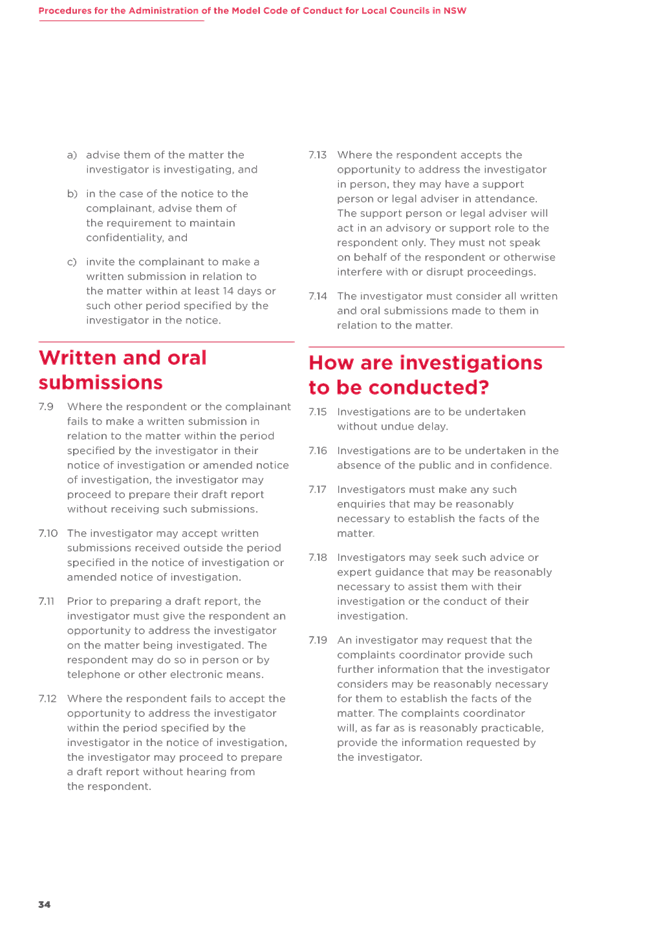
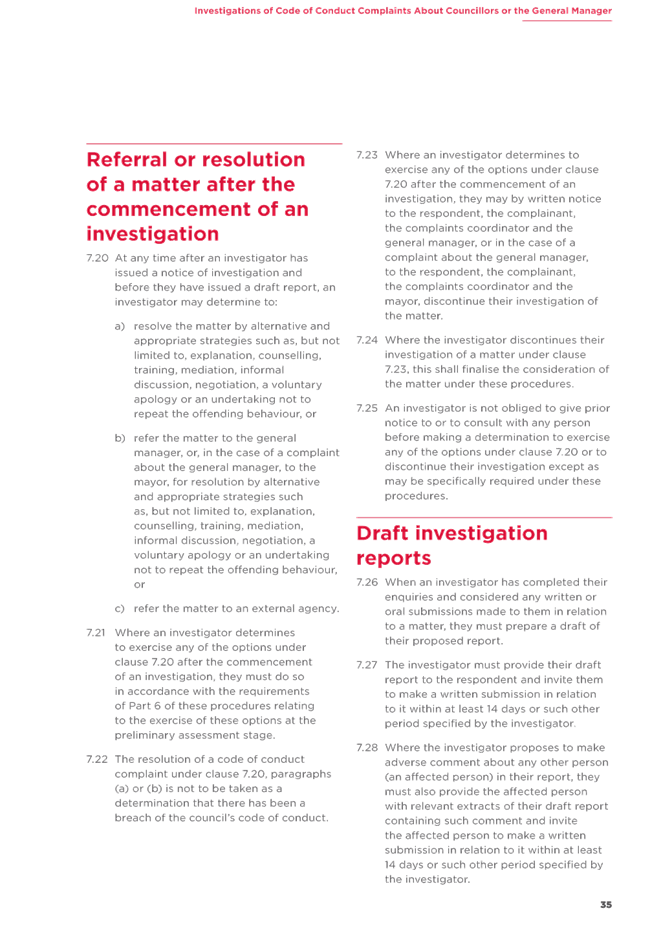

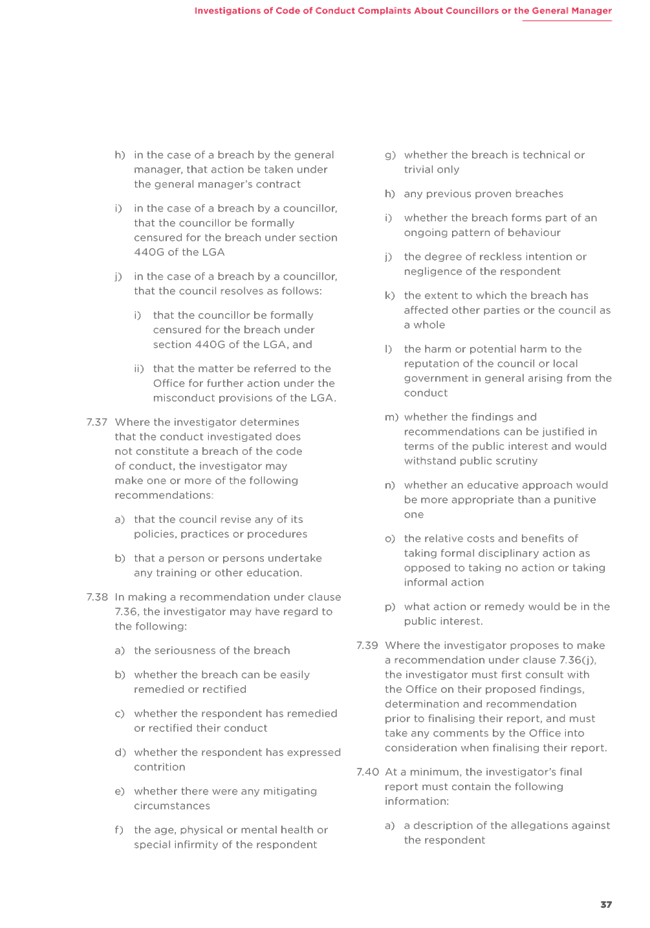

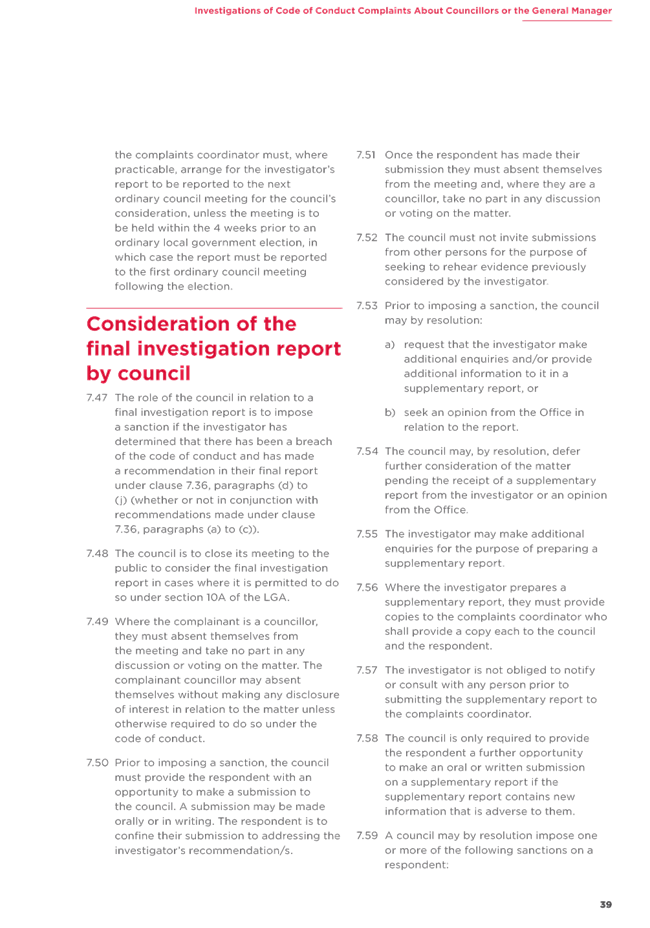
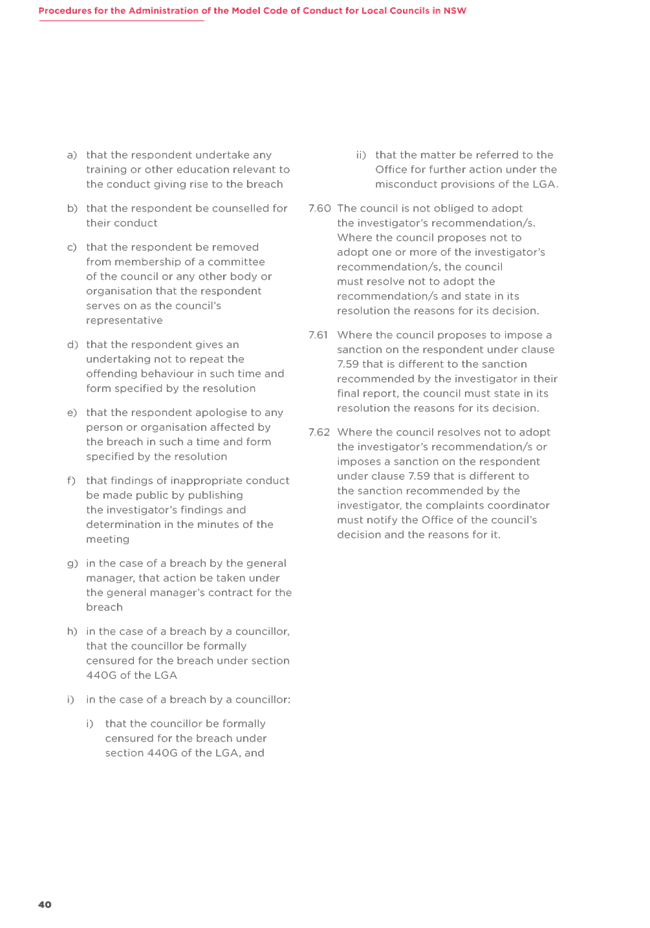


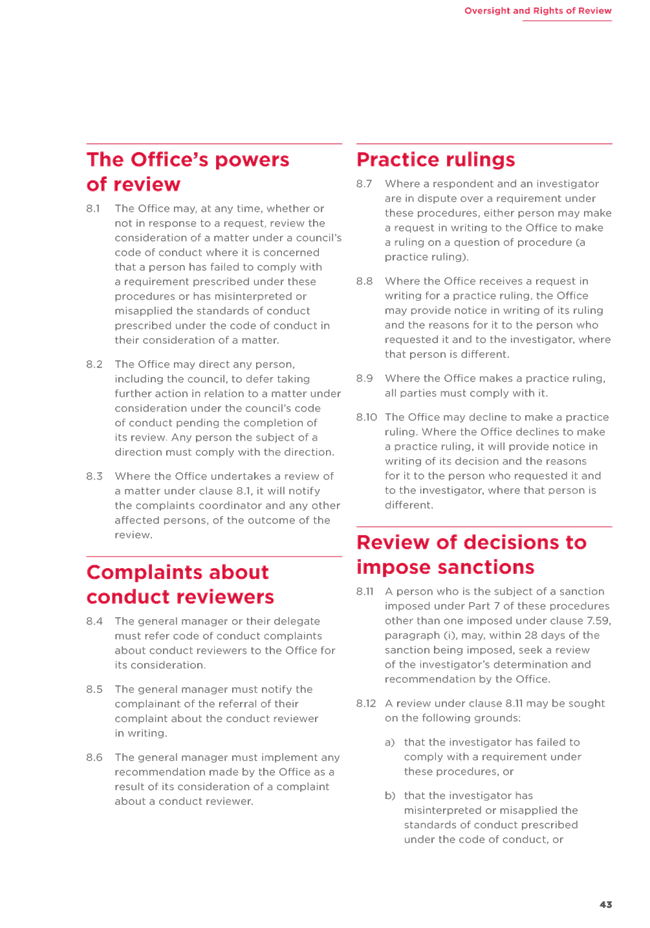
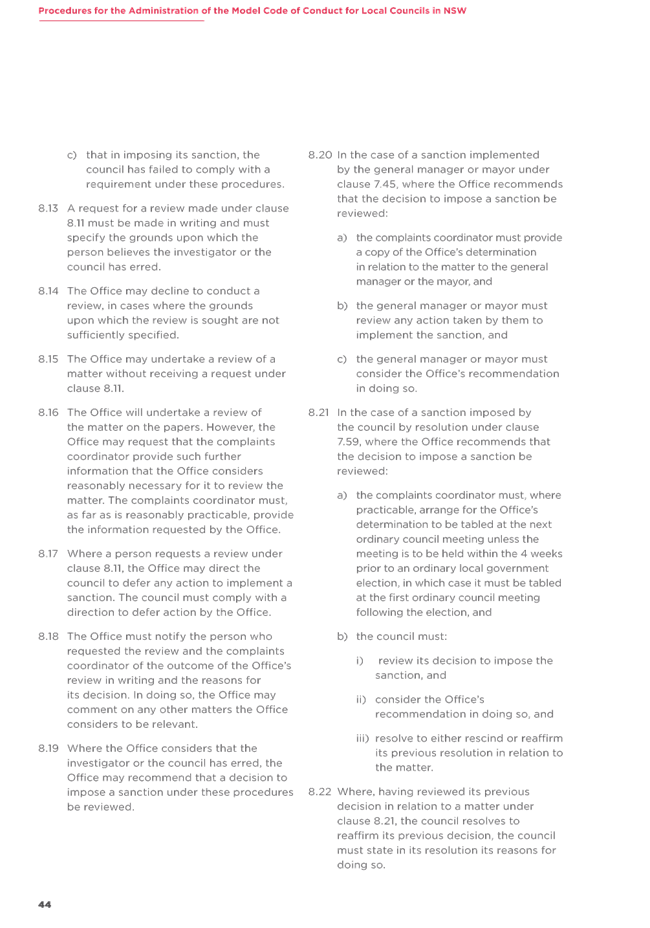

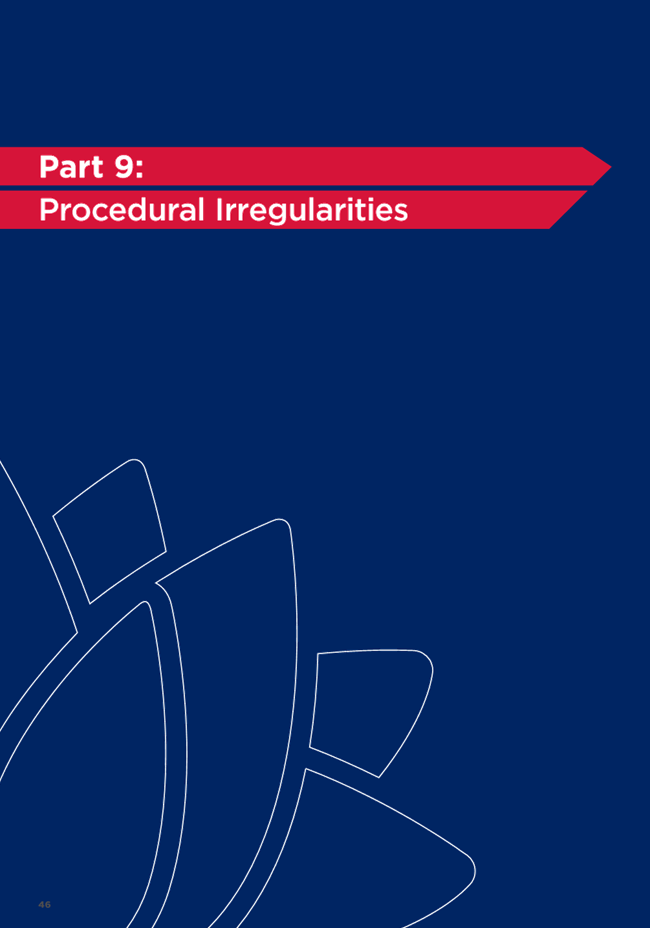
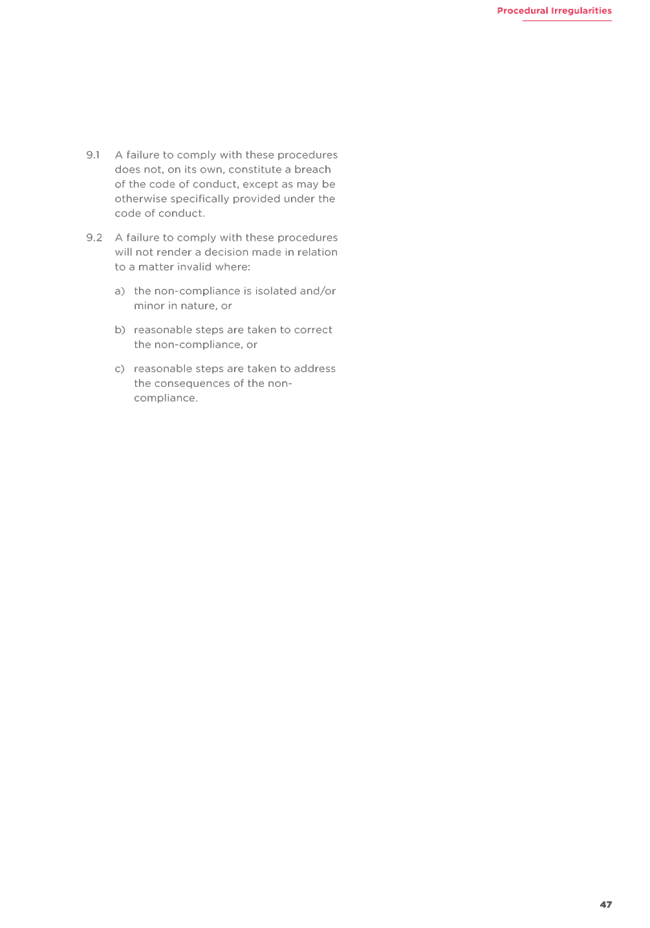


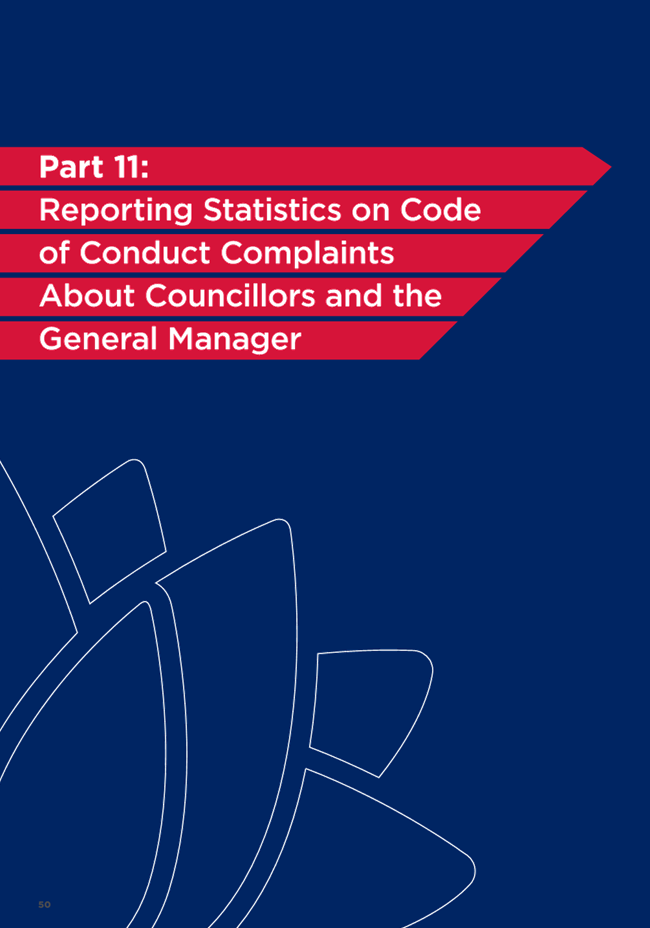
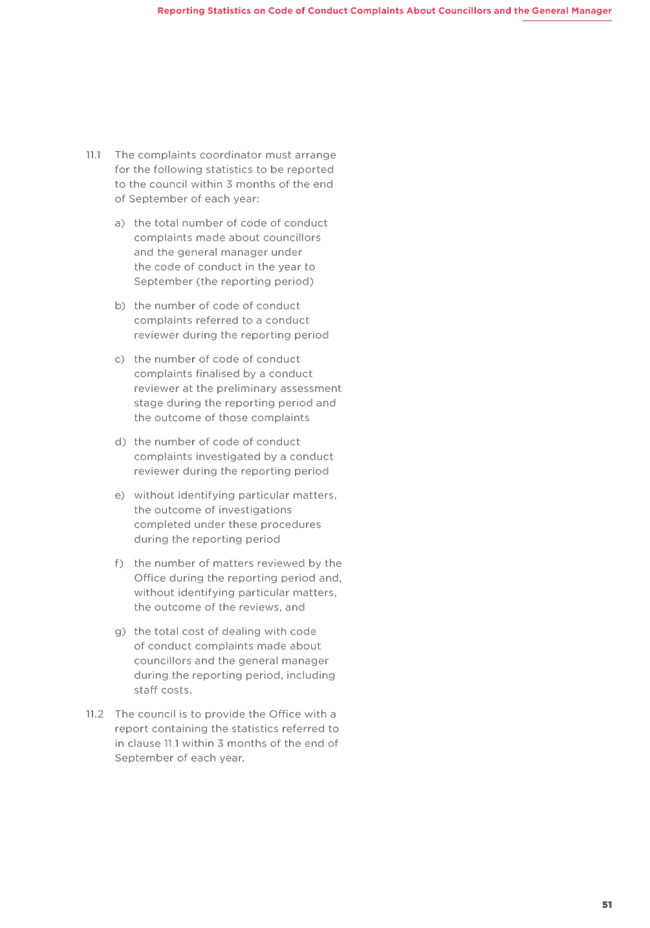

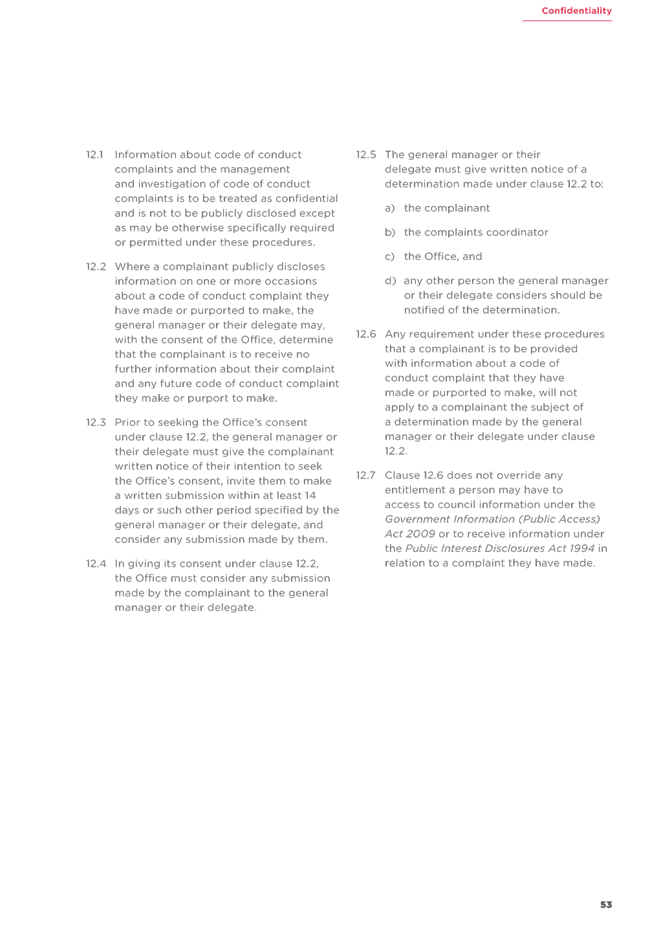

Amendments made to the Local Government Act 1993 (LGA) in August 2016 by the Local Government Amendment (Governance and Planning) Act 2016 (the Phase 1 amendments) provide for a model code of meeting practice (Model Meeting Code) to be prescribed by the Regulation.
The Model Code has been amended as allowed to meet the requirements of Yass Valley Council and this policy is presented to Council for adoption.
RECOMMENDATIONThat the Code of Meeting Practice for Yass Valley Council be adopted.
|
Training in the implementation of the new Code of Meeting Practice is included in the annual training budget.
Amendments made to the Local Government Act 1993 (LGA) in August 2016 by the Local Government Amendment (Governance and Planning) Act 2016 (the Phase 1 amendments) provide for a model code of meeting practice (Model Meeting Code) to be prescribed by the Regulation.
A Model Meeting Code has been prescribed under the Local Government (General) Regulation 2005 (the Regulation) and the existing meetings provisions of the Regulation have been repealed.
Following an extensive consultation process, a Model Meeting Code (Attachment A) has been prescribed under the Local Government (General) Regulation 2005 (the Regulation) and the existing meetings provisions of the Regulation have been repealed.
The Model Meeting Code was placed on public exhibition from 1 March to 12 April 2019. During this period no submissions were received. It is recommended that the Model Meeting Code as exhibited now be adopted by Council.
Key Pillar 5. Our Civic Leadership
CSP Strategy CL1 - Effect resourceful and respectful leadership and attentive representation of the community
Delivery Program Action CL1.4 - Be compliant, more efficient and effective
Operational Plan Activity CL1.4.2 - All regulated compliance is adhered to
ATTACHMENTS: a. Model Code of Meeting Practice ⇩